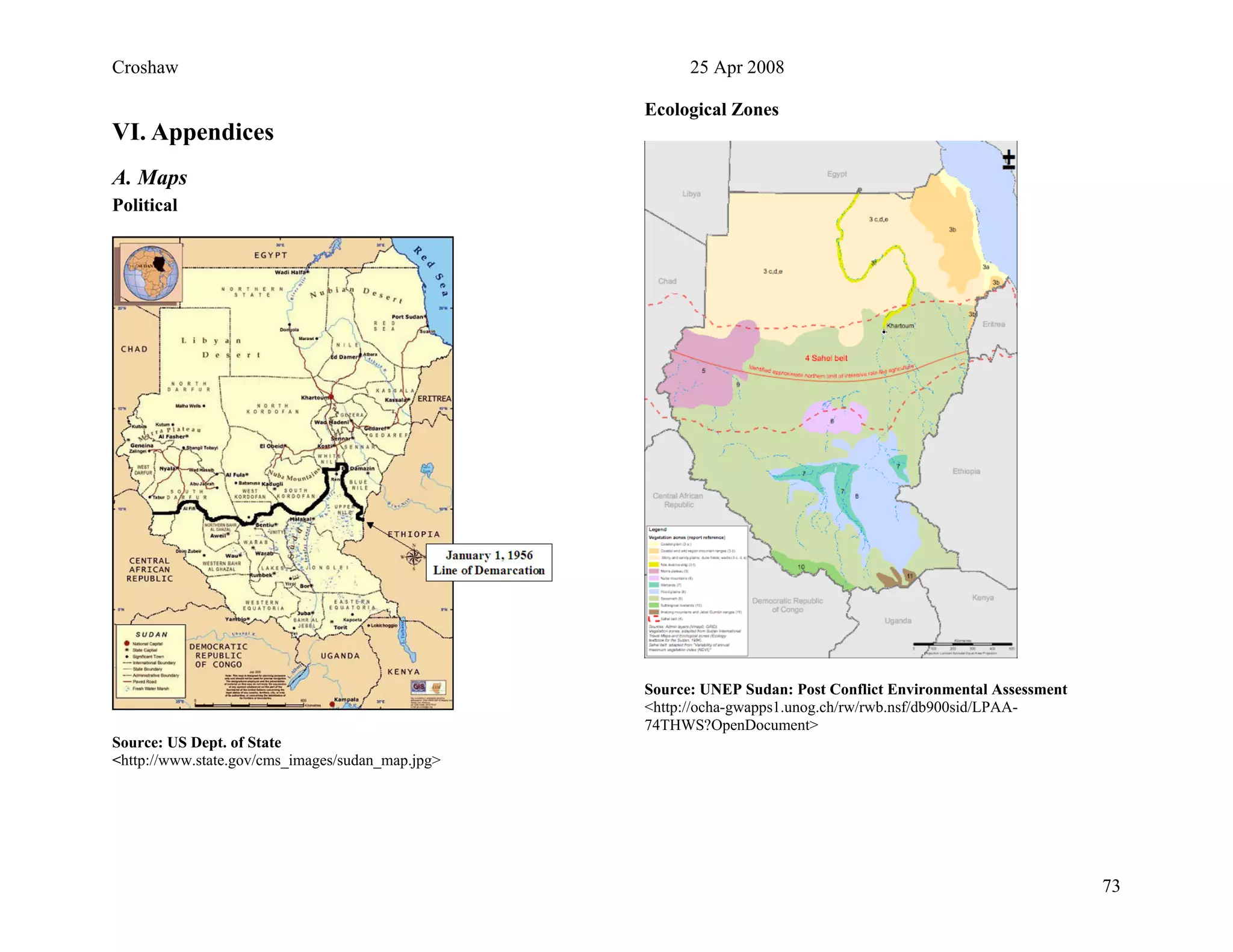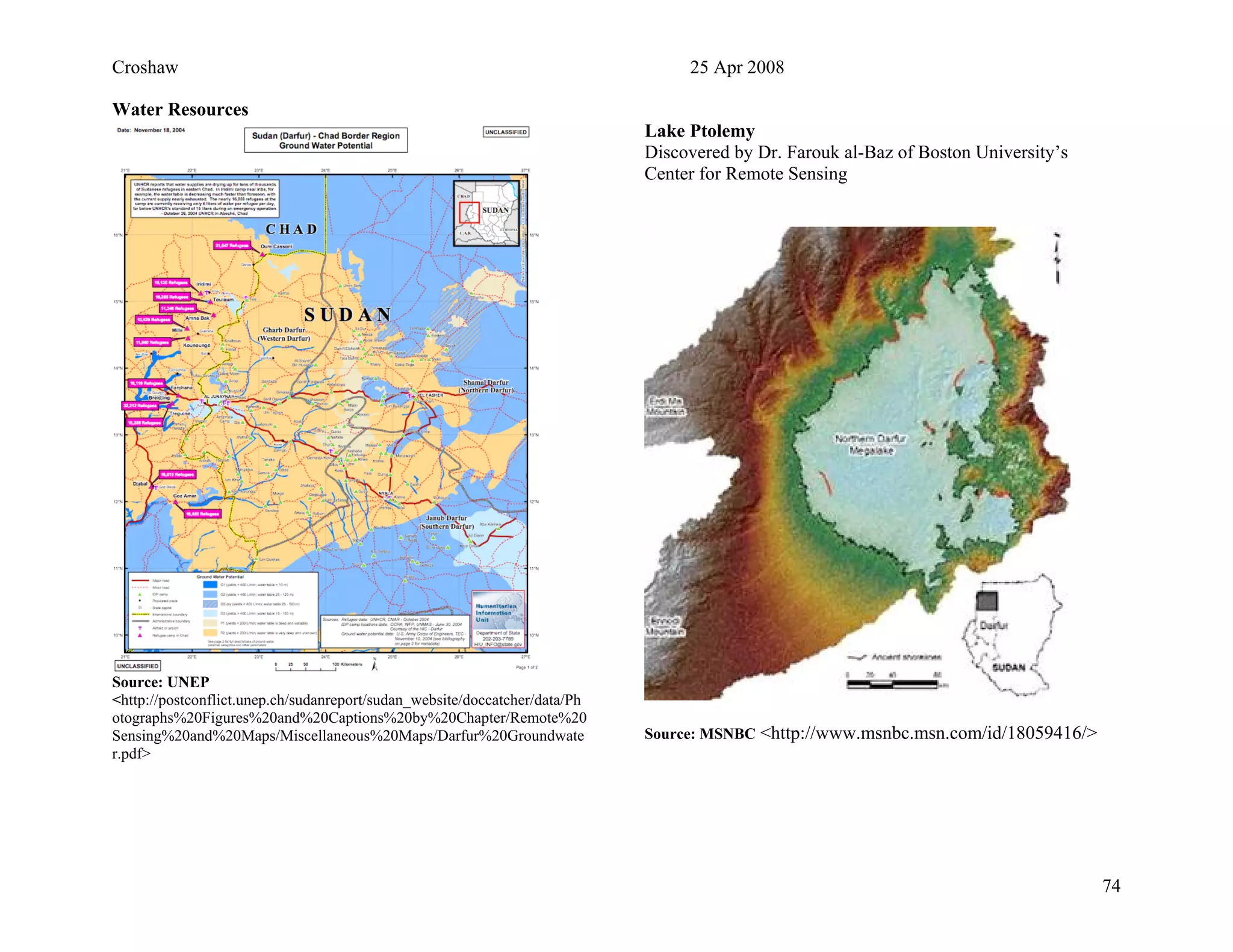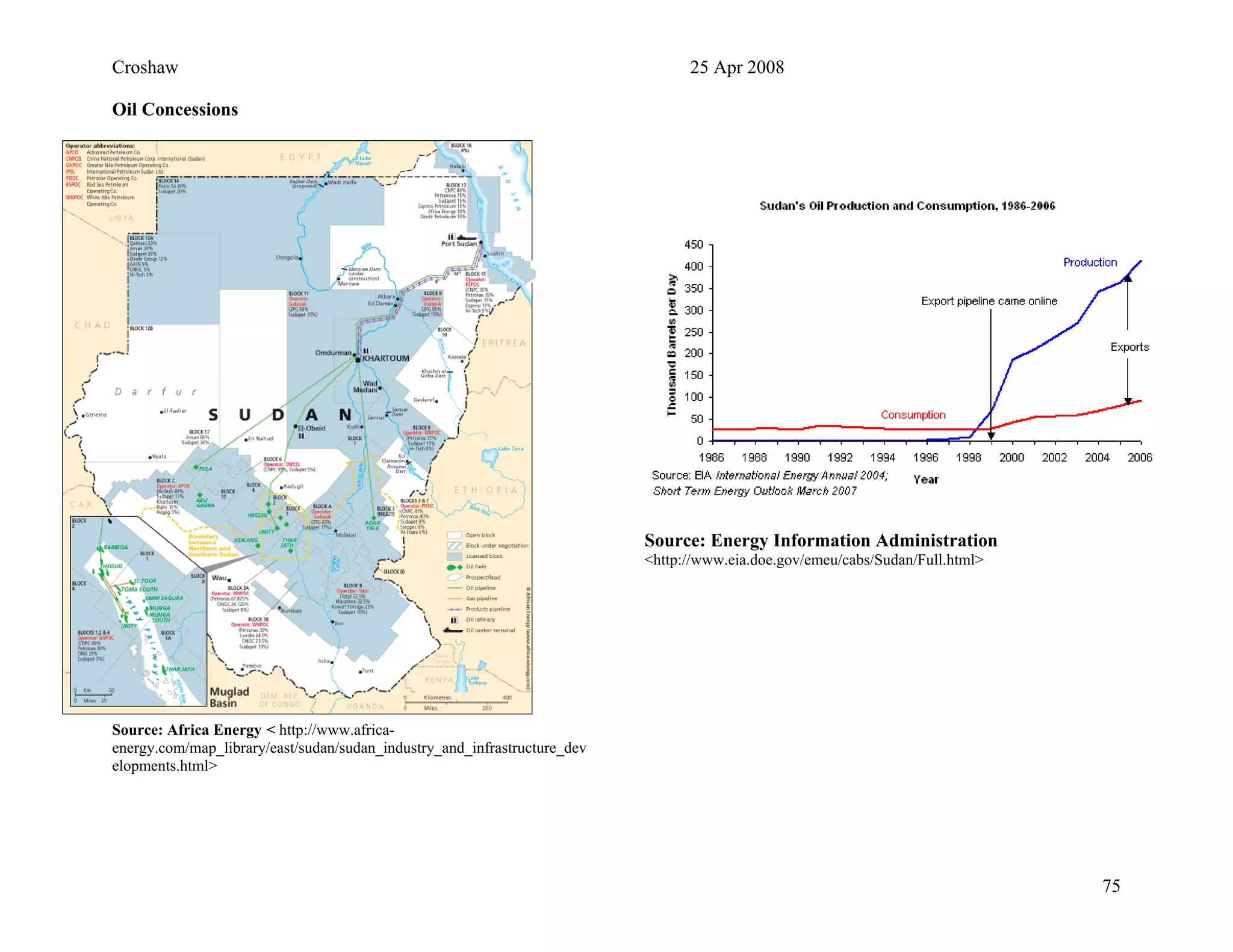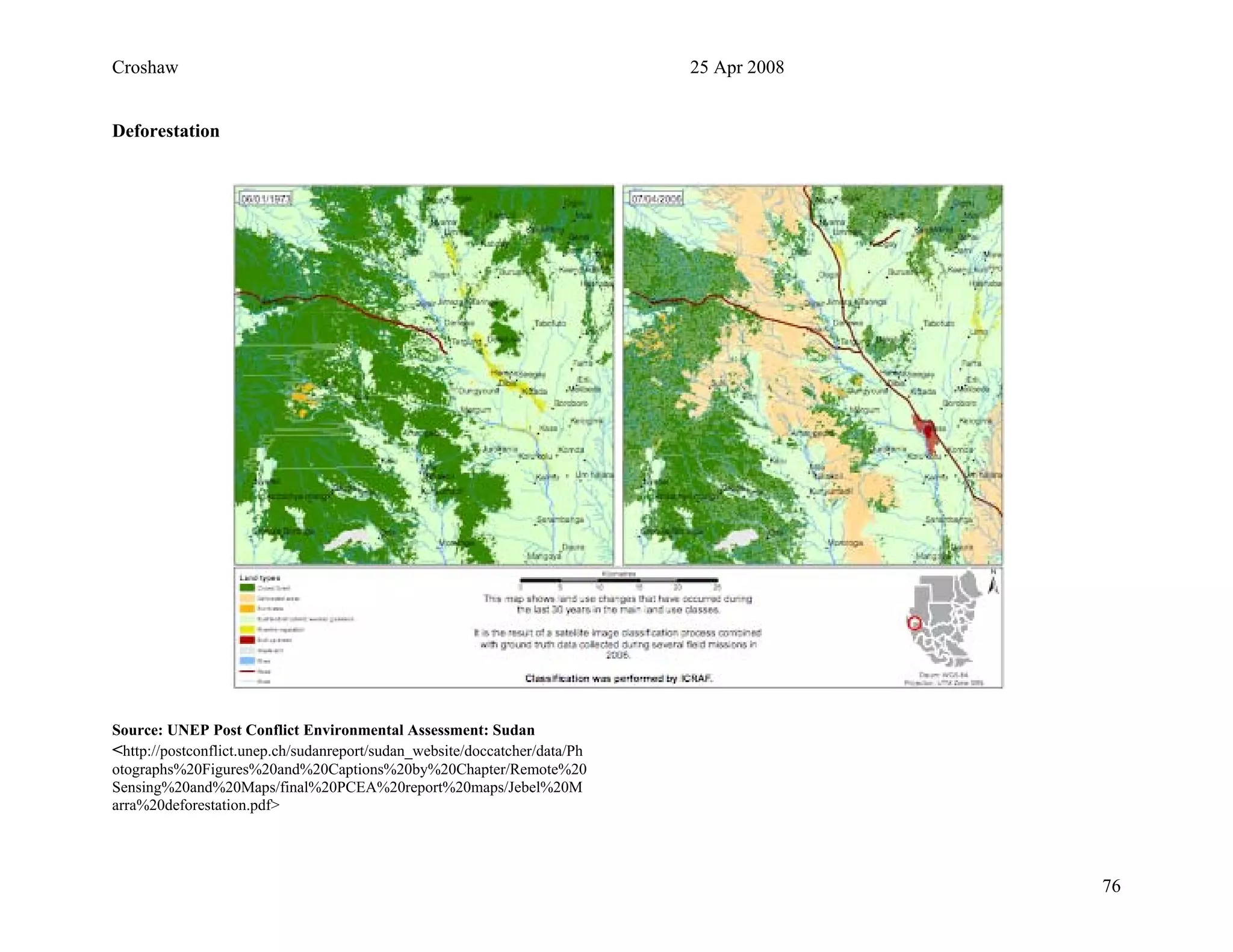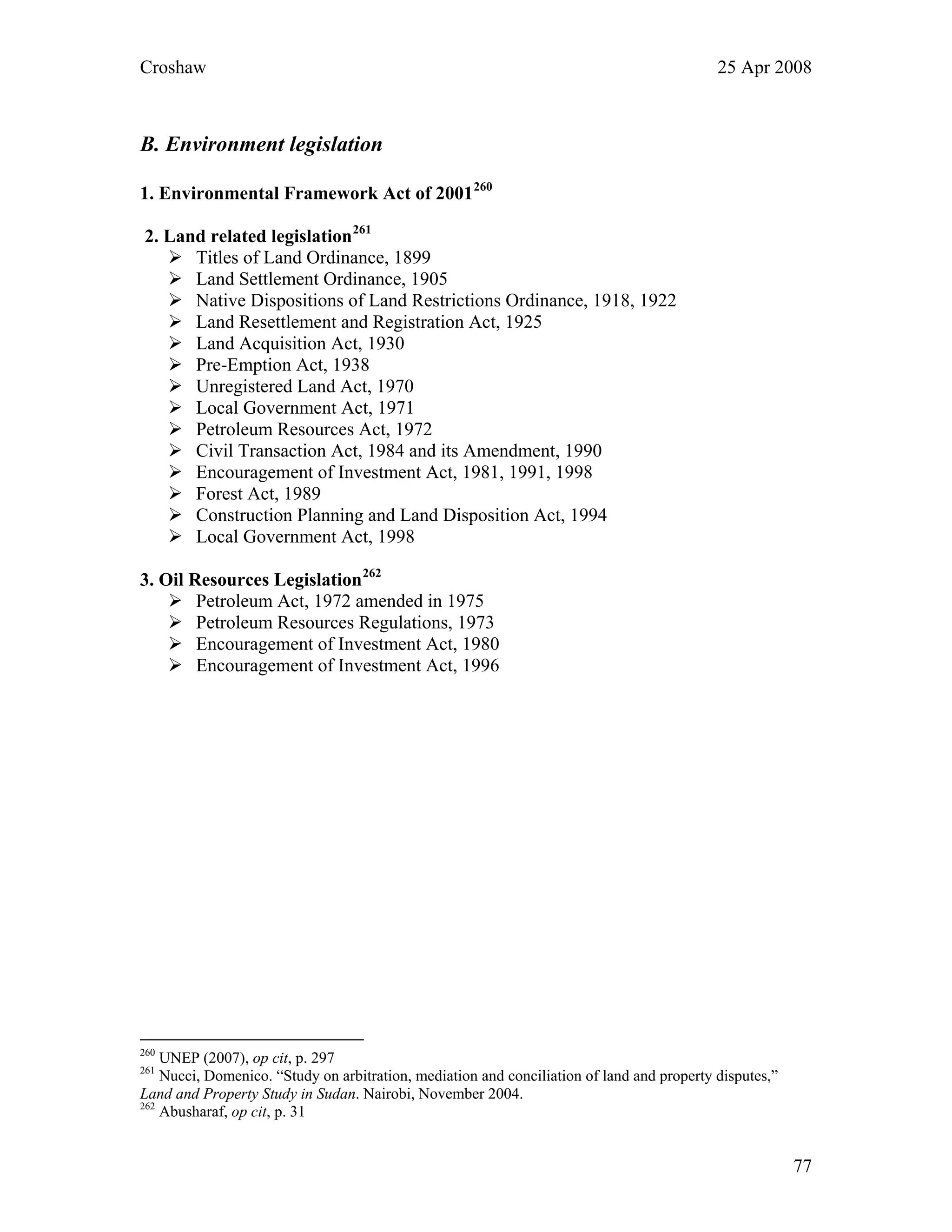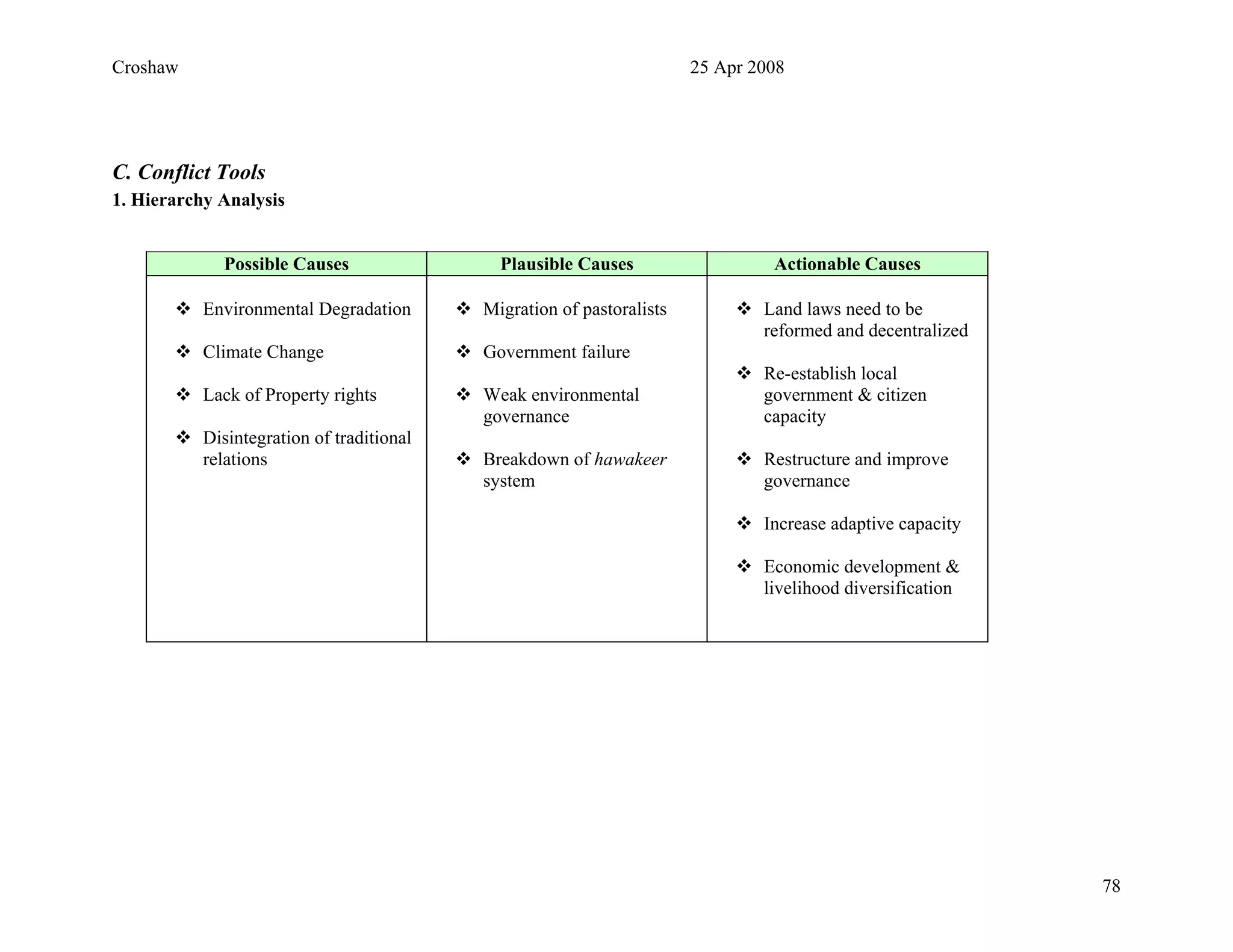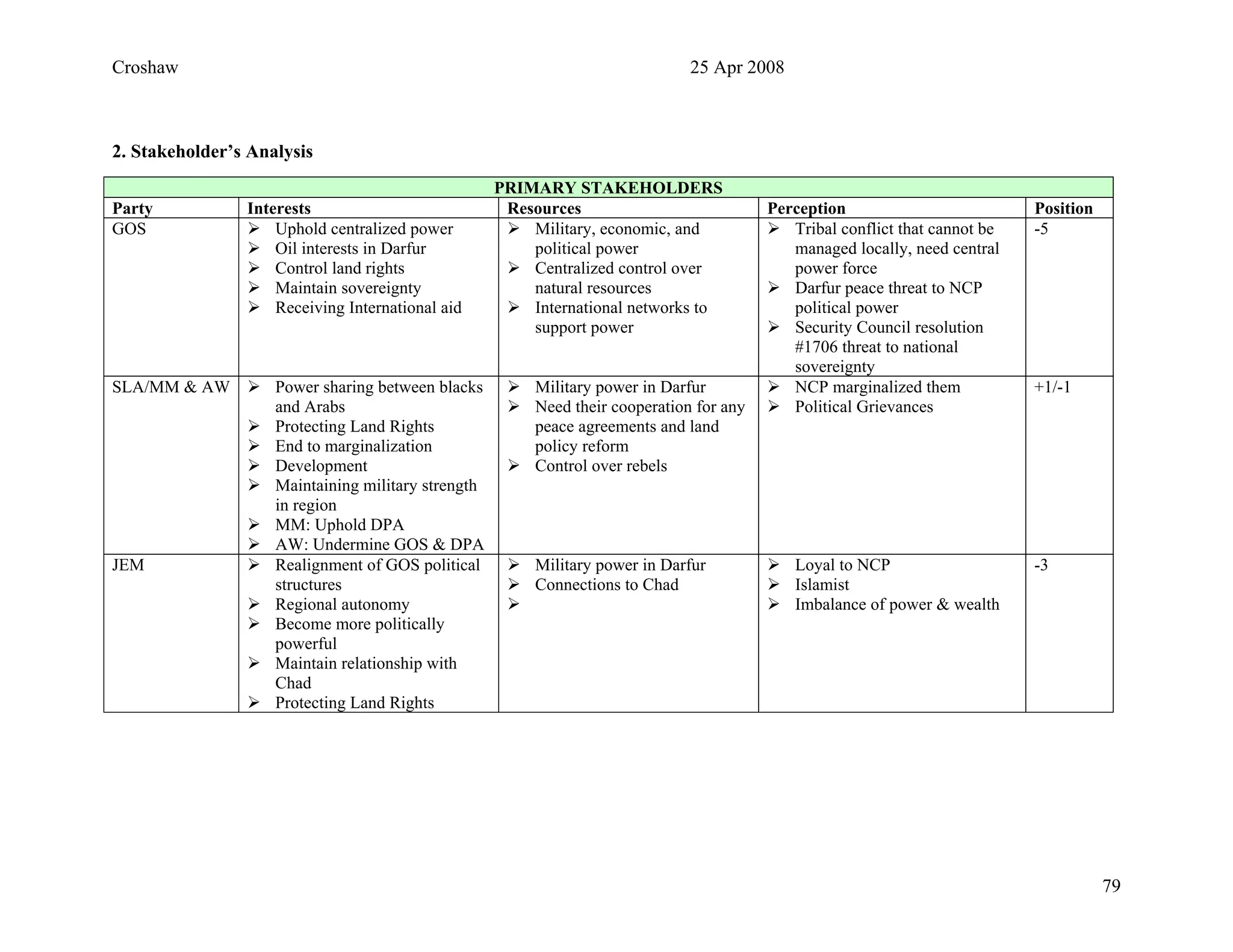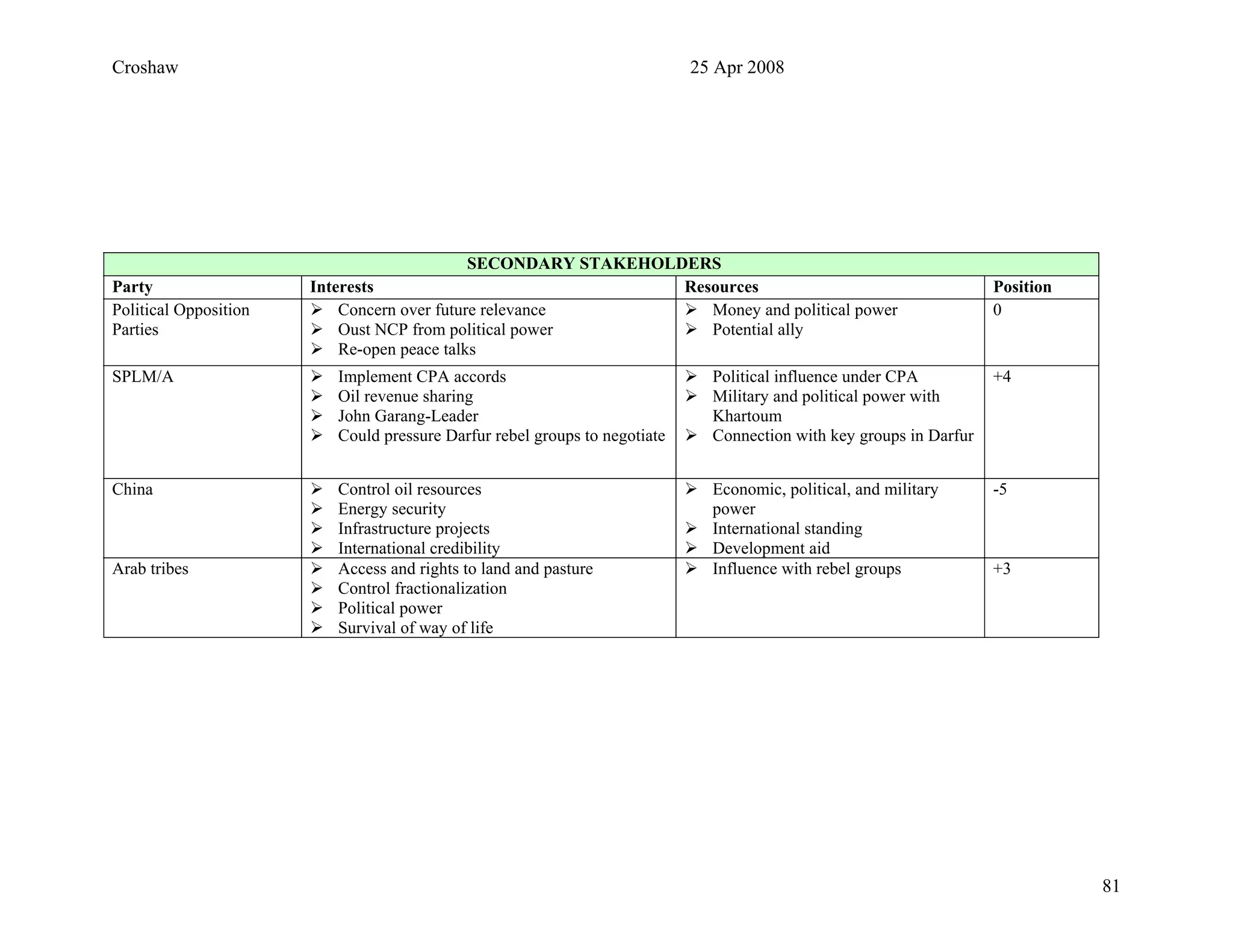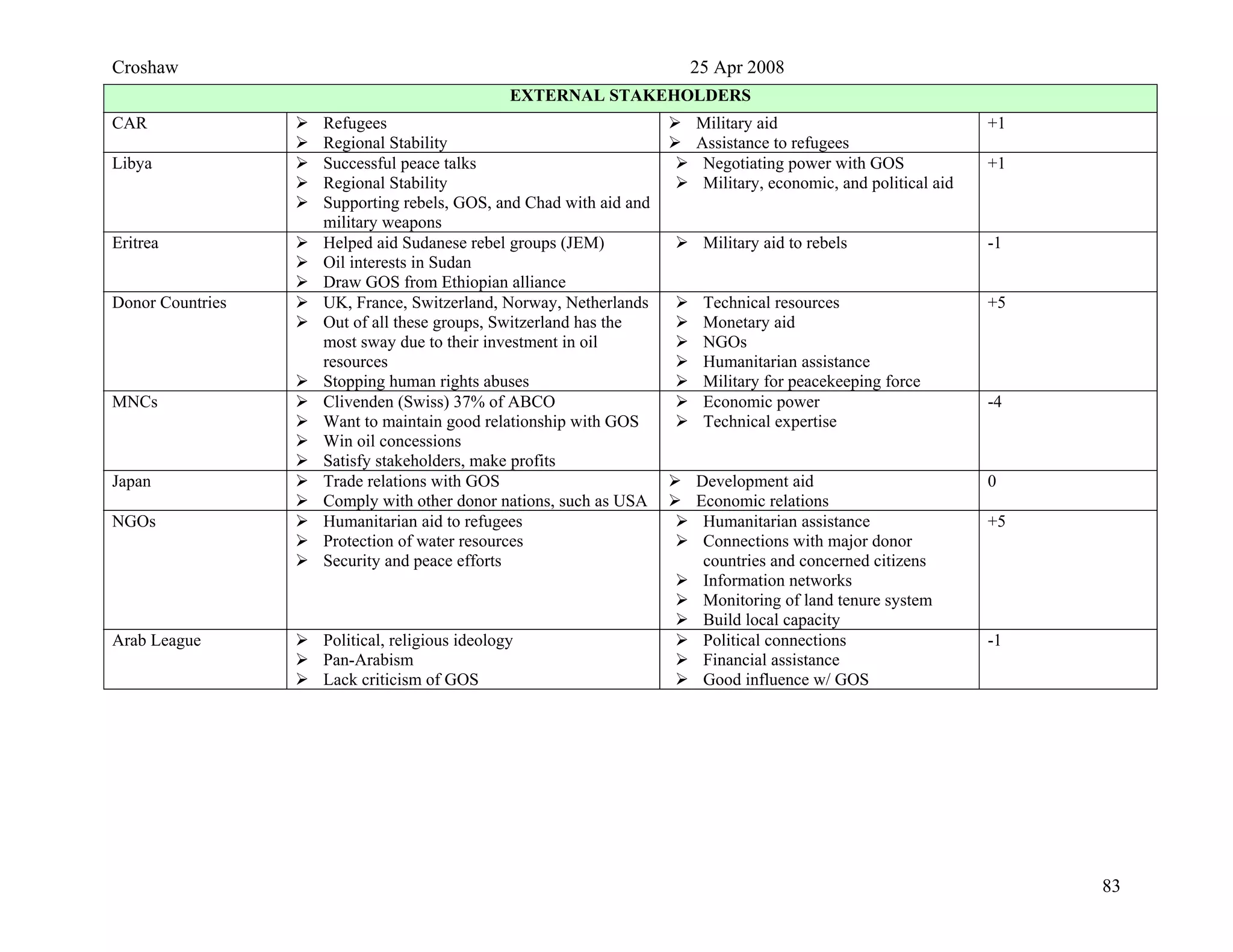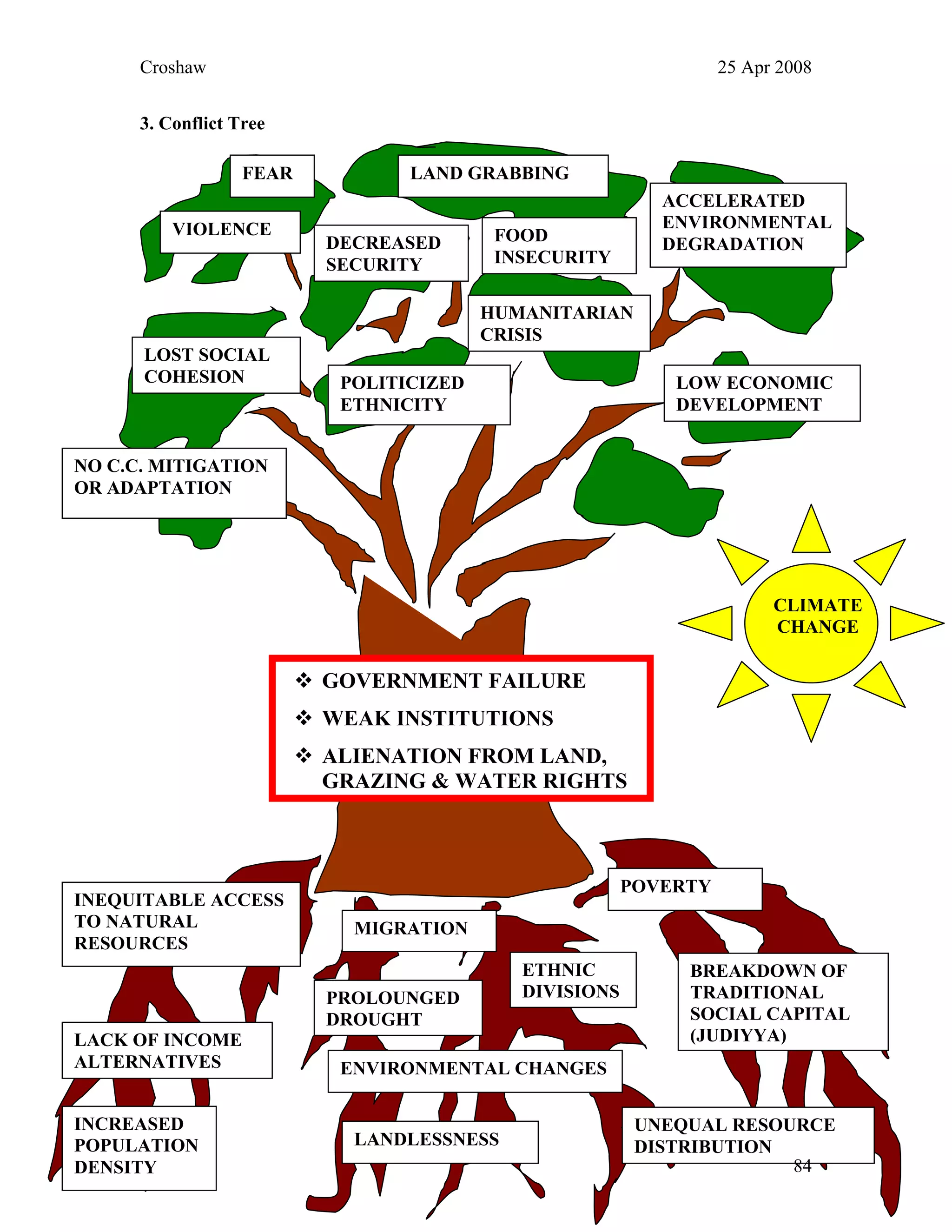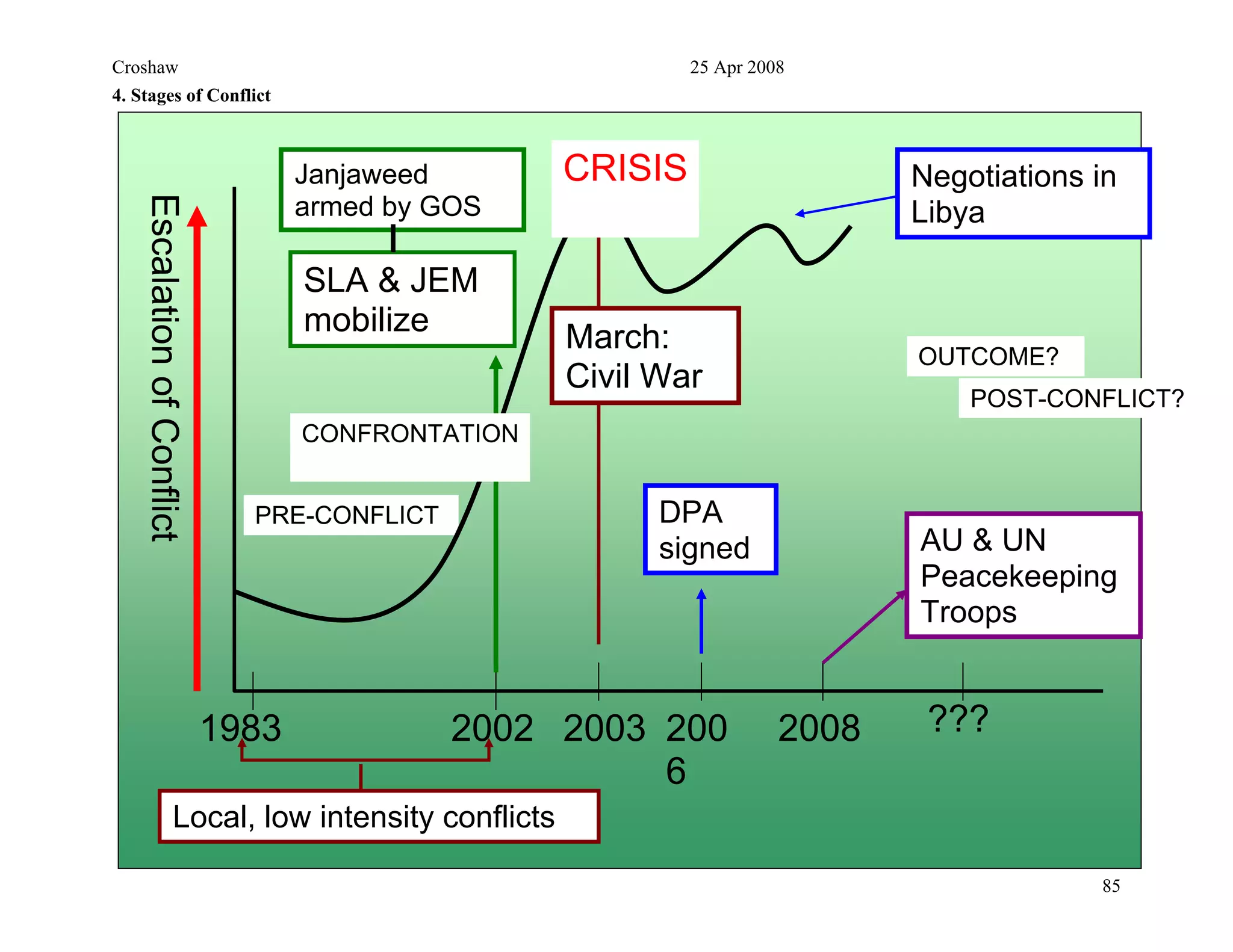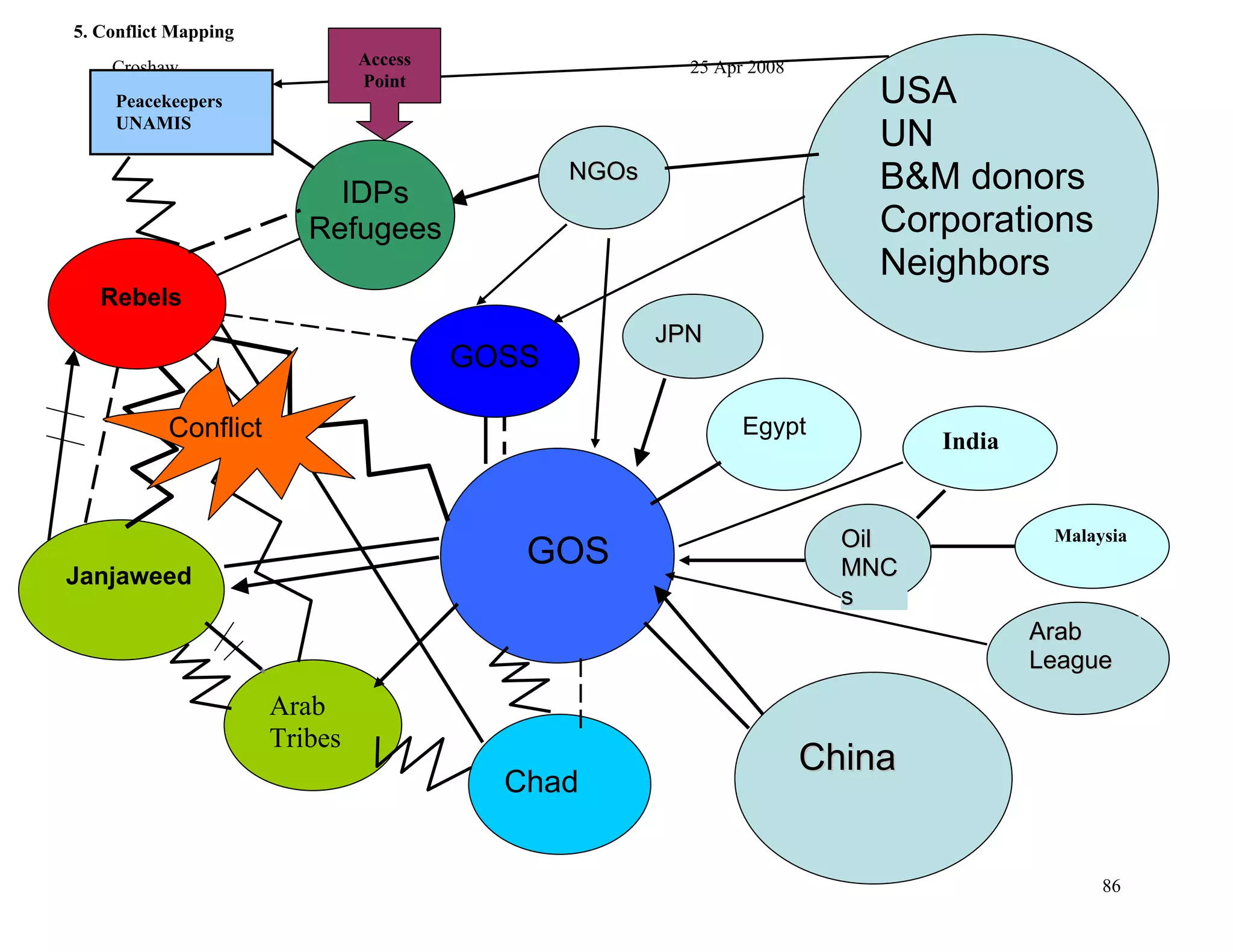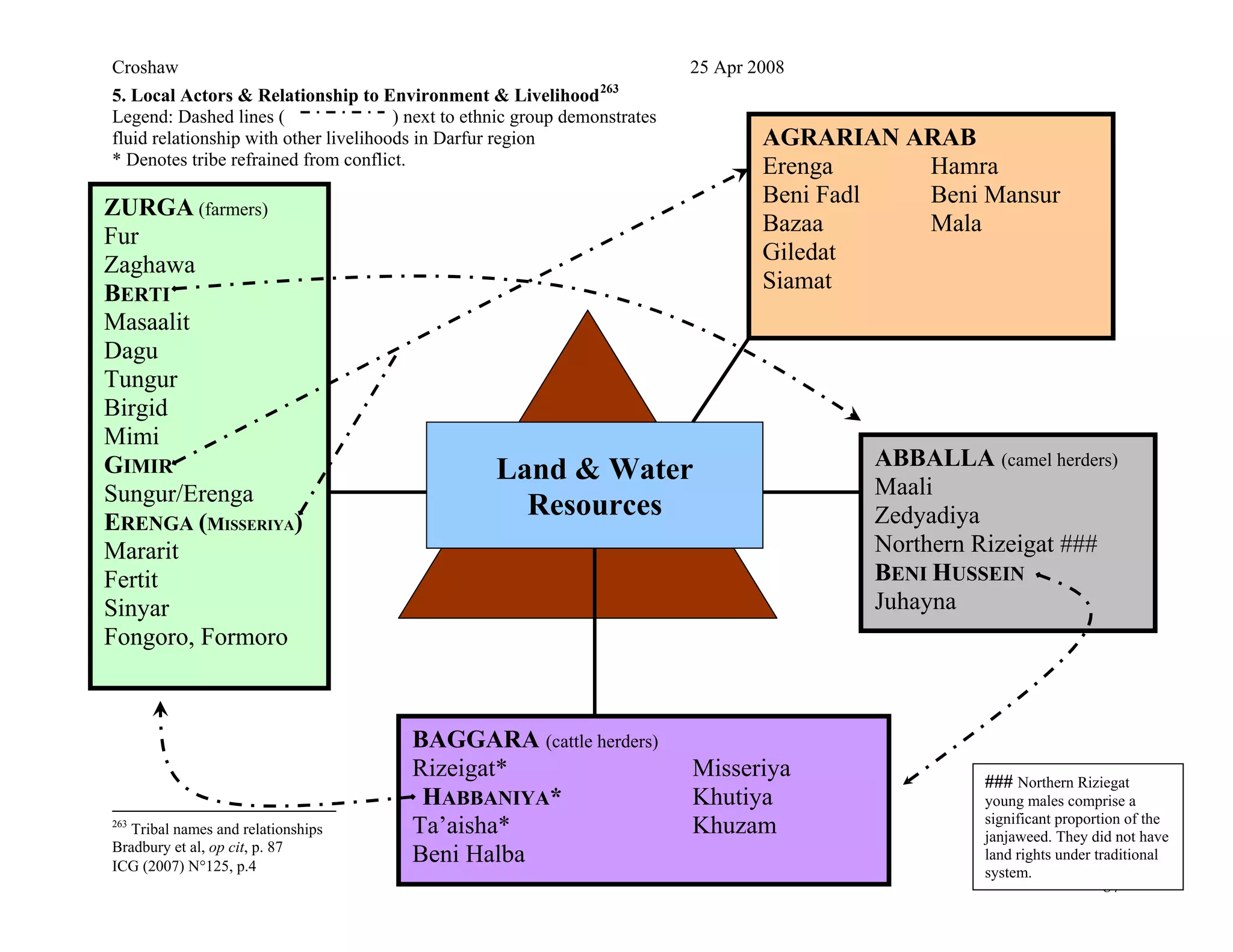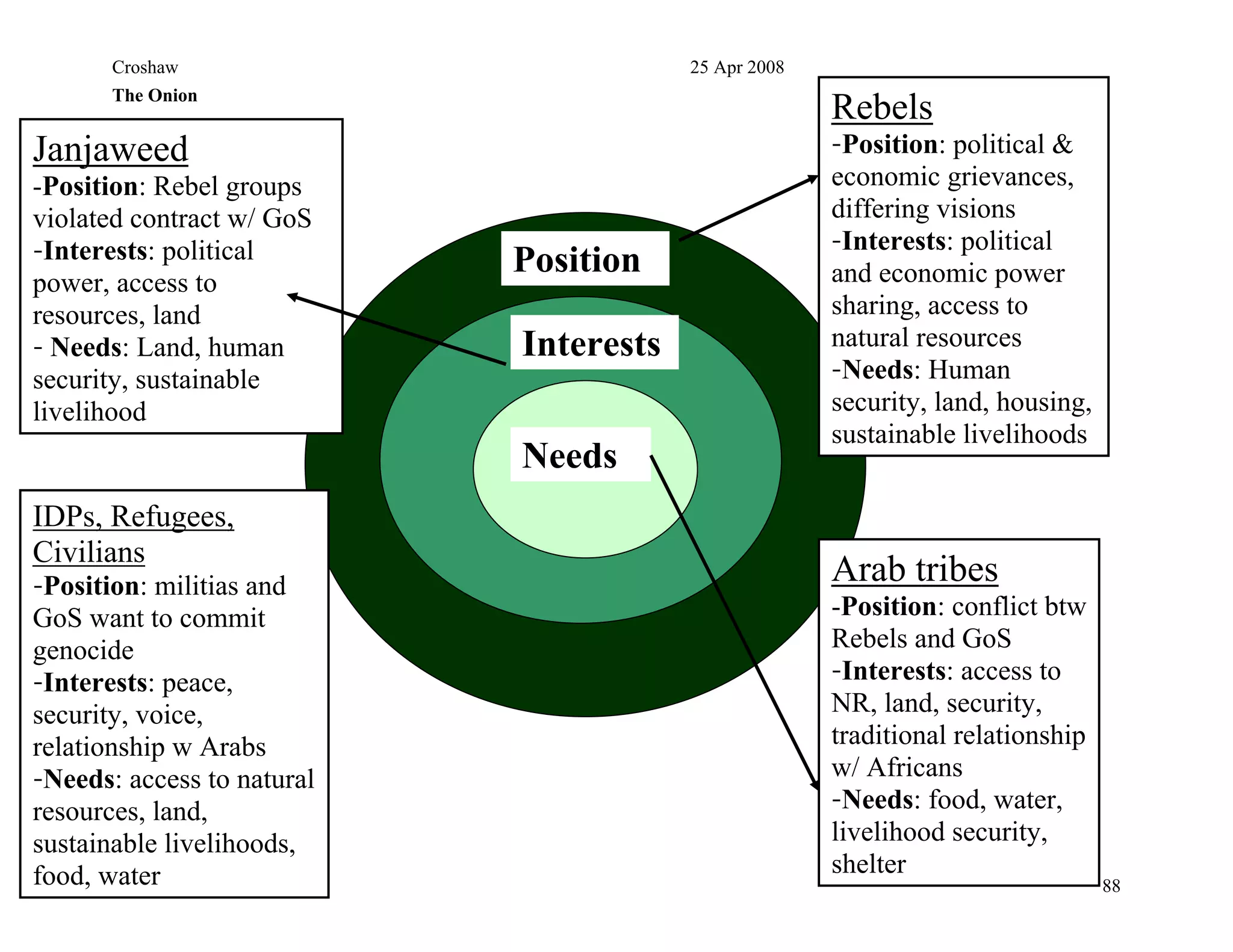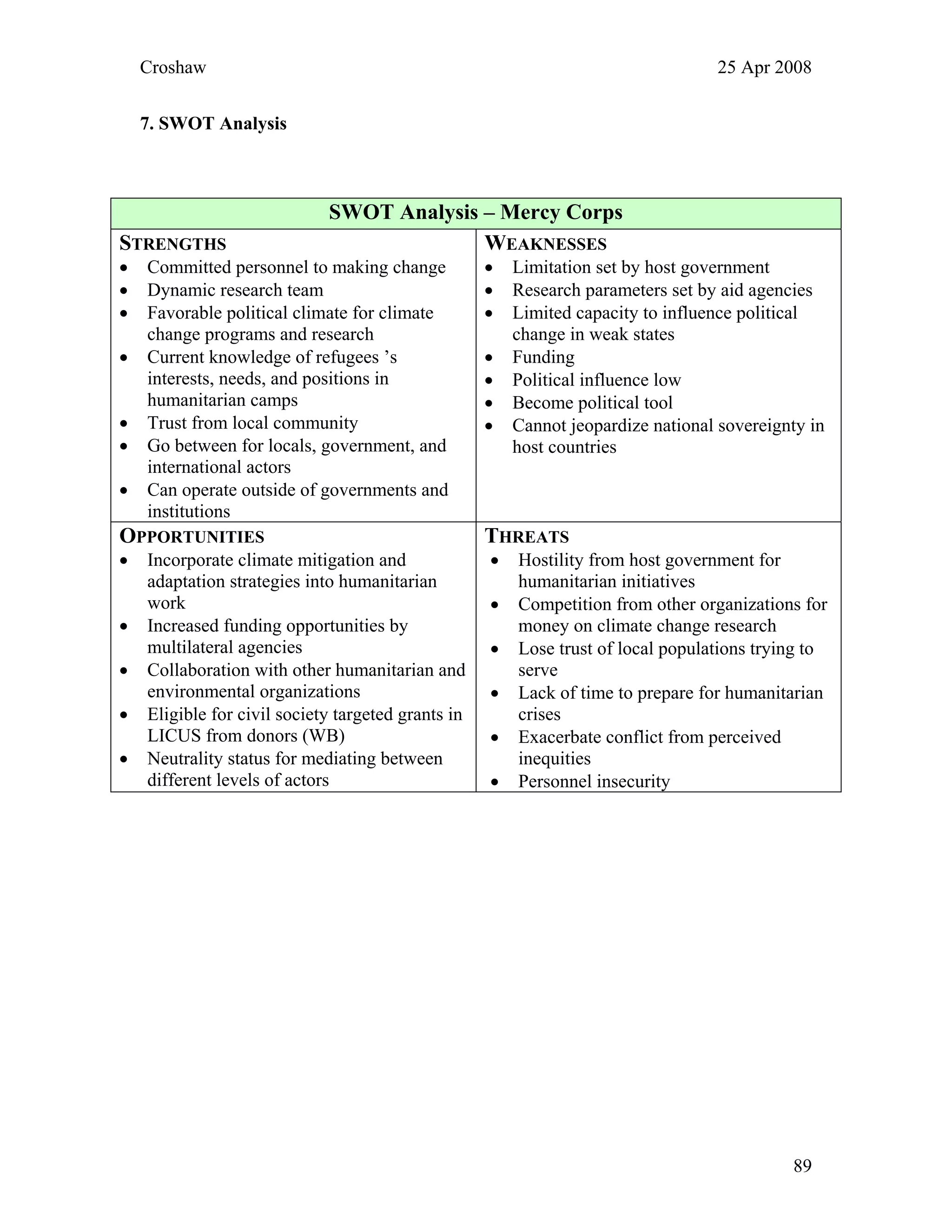This document provides a literature review on the topics of environmental security, resource scarcity, resource curse, climate change and security, and climate change in Africa and Darfur. It discusses the emergence of environmental security as a field looking at linkages between the environment and conflict. Key theories around resource scarcity and how environmental degradation can lead to conflict through mechanisms like resource capture and ecological marginalization are summarized. The document also reviews literature on climate change impacts in Africa and how climate change is already affecting Darfur through issues like desertification, decreased rainfall and land degradation.
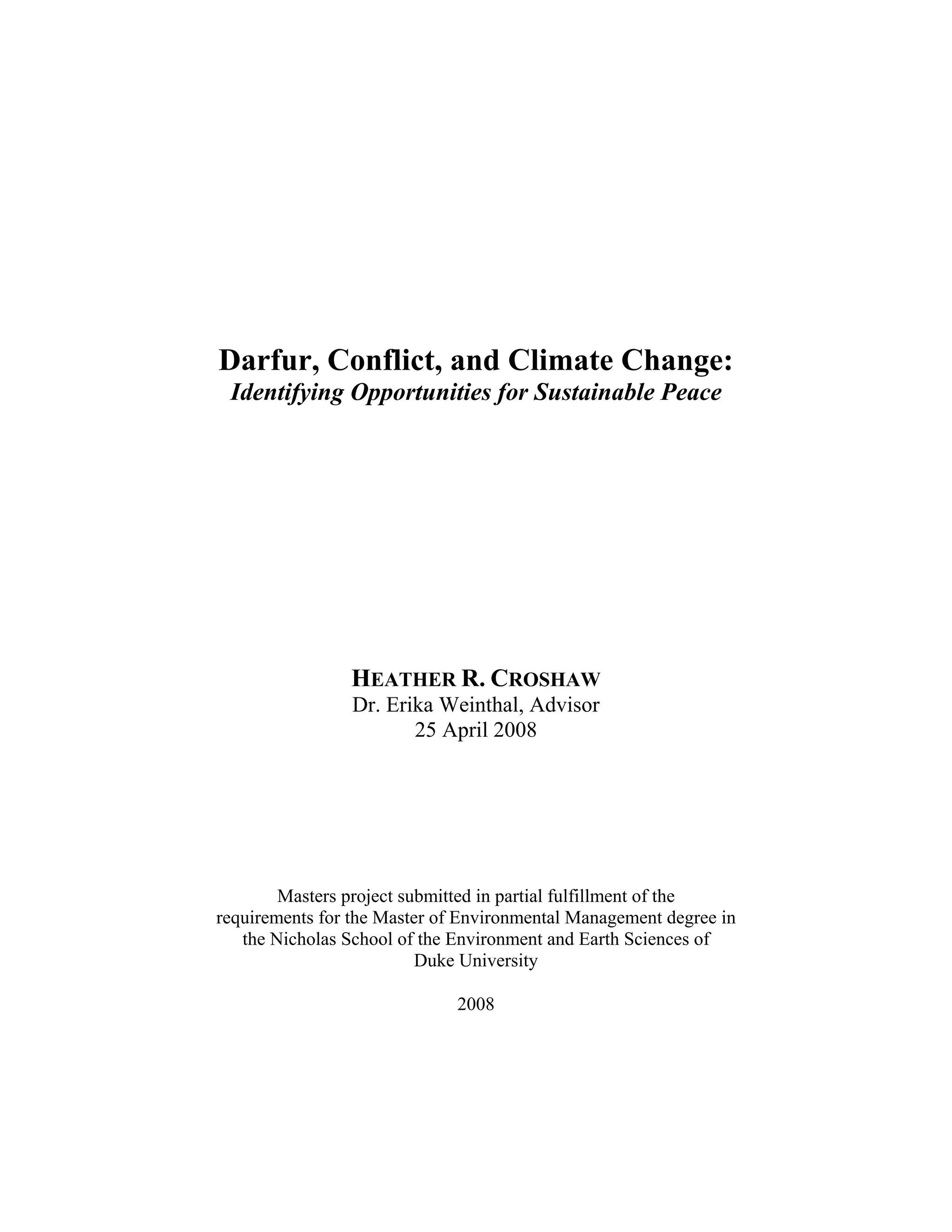
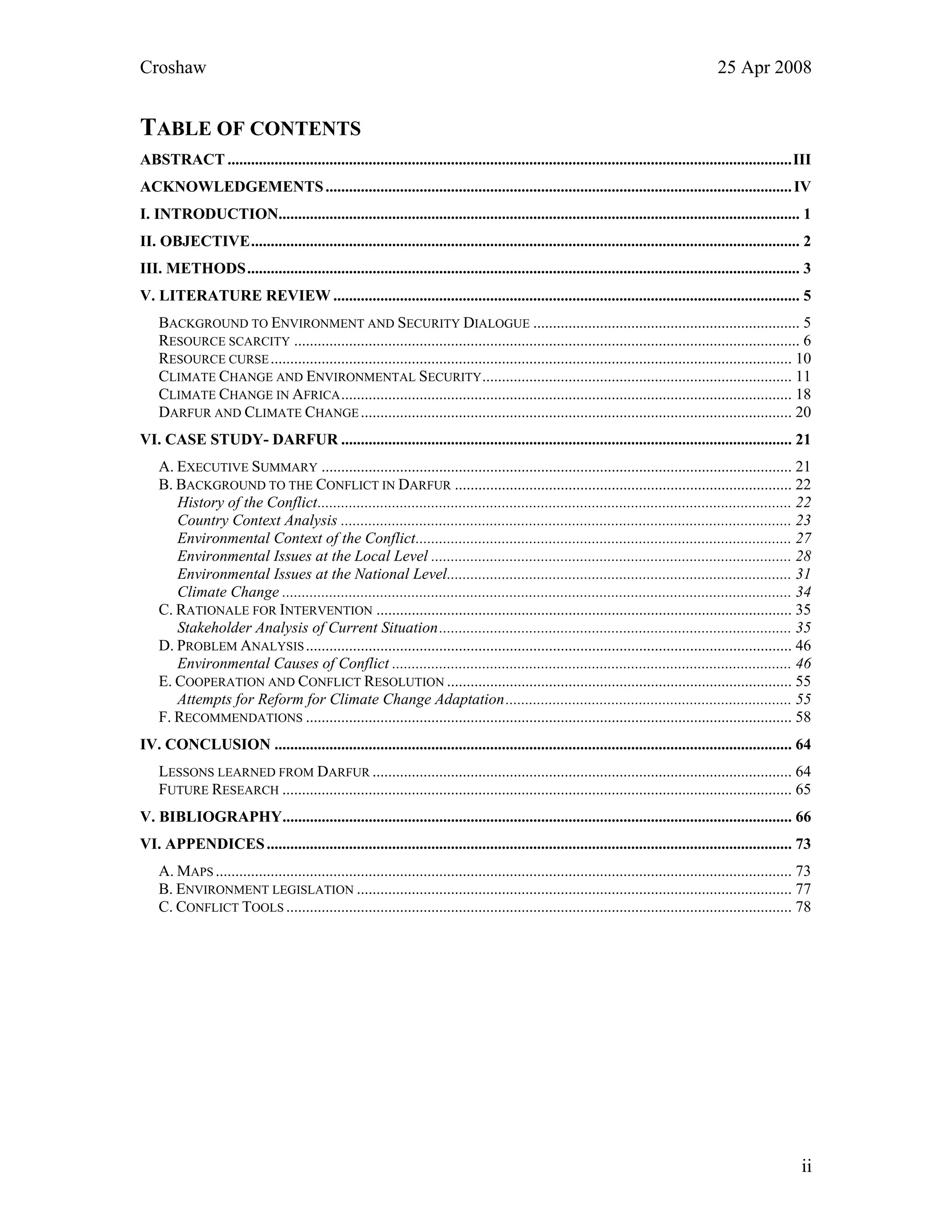

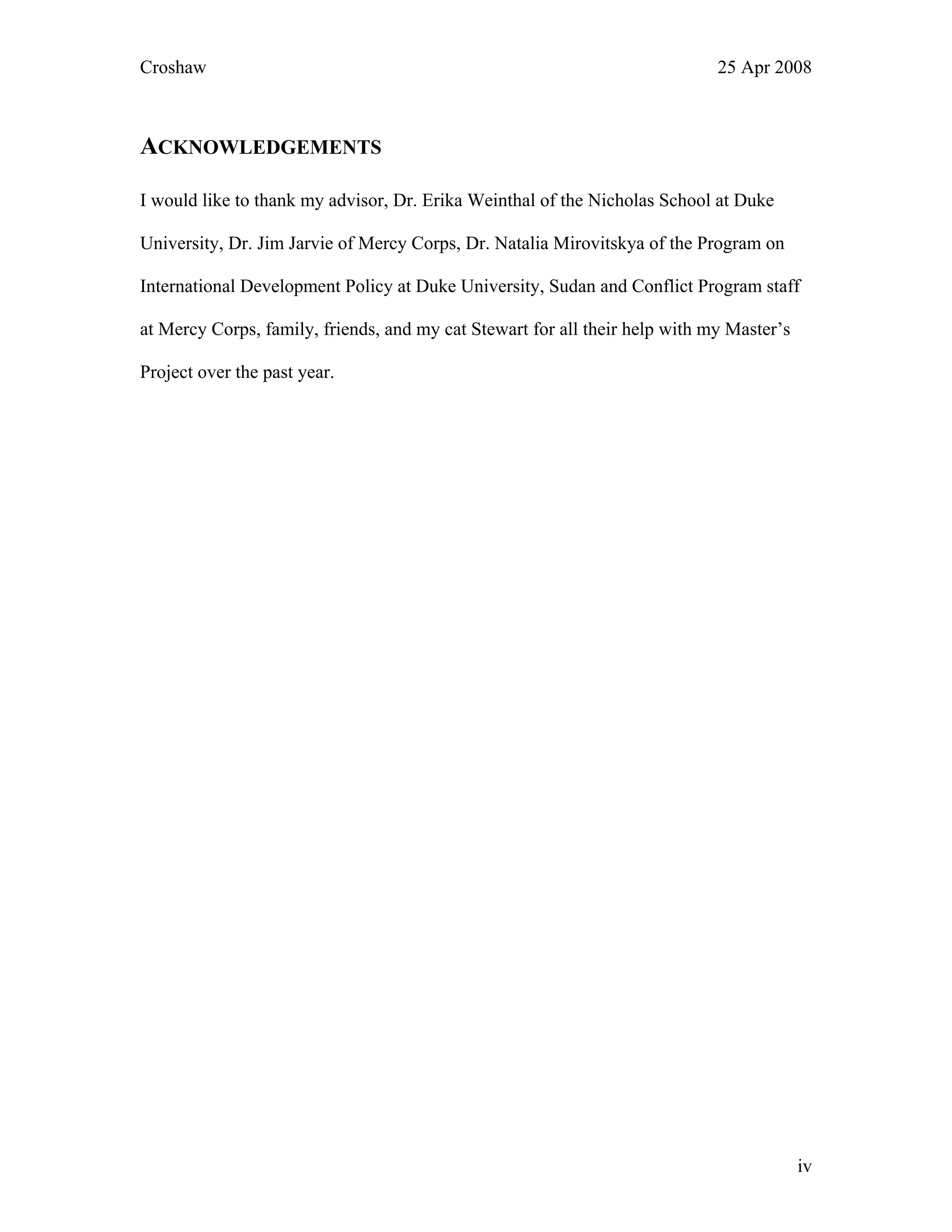

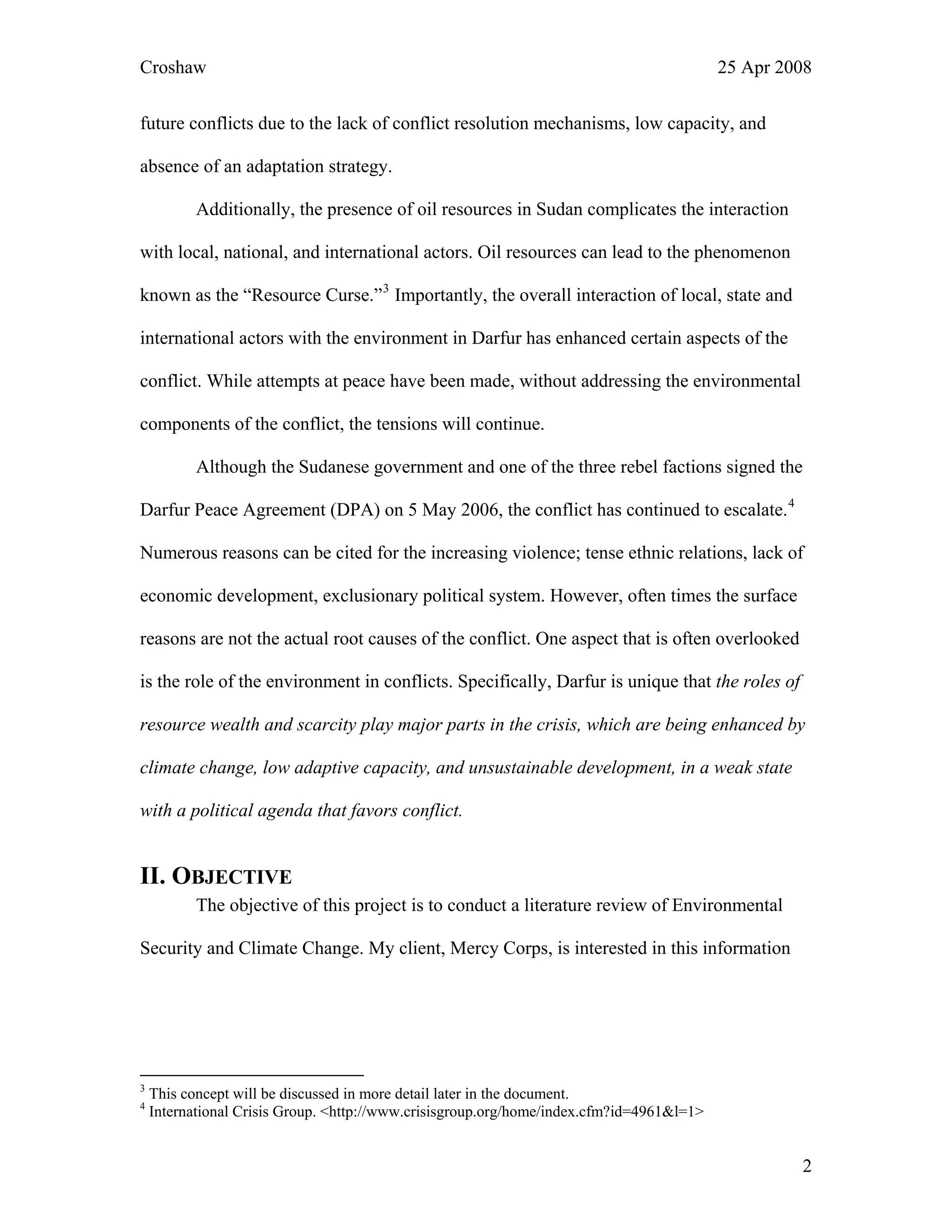
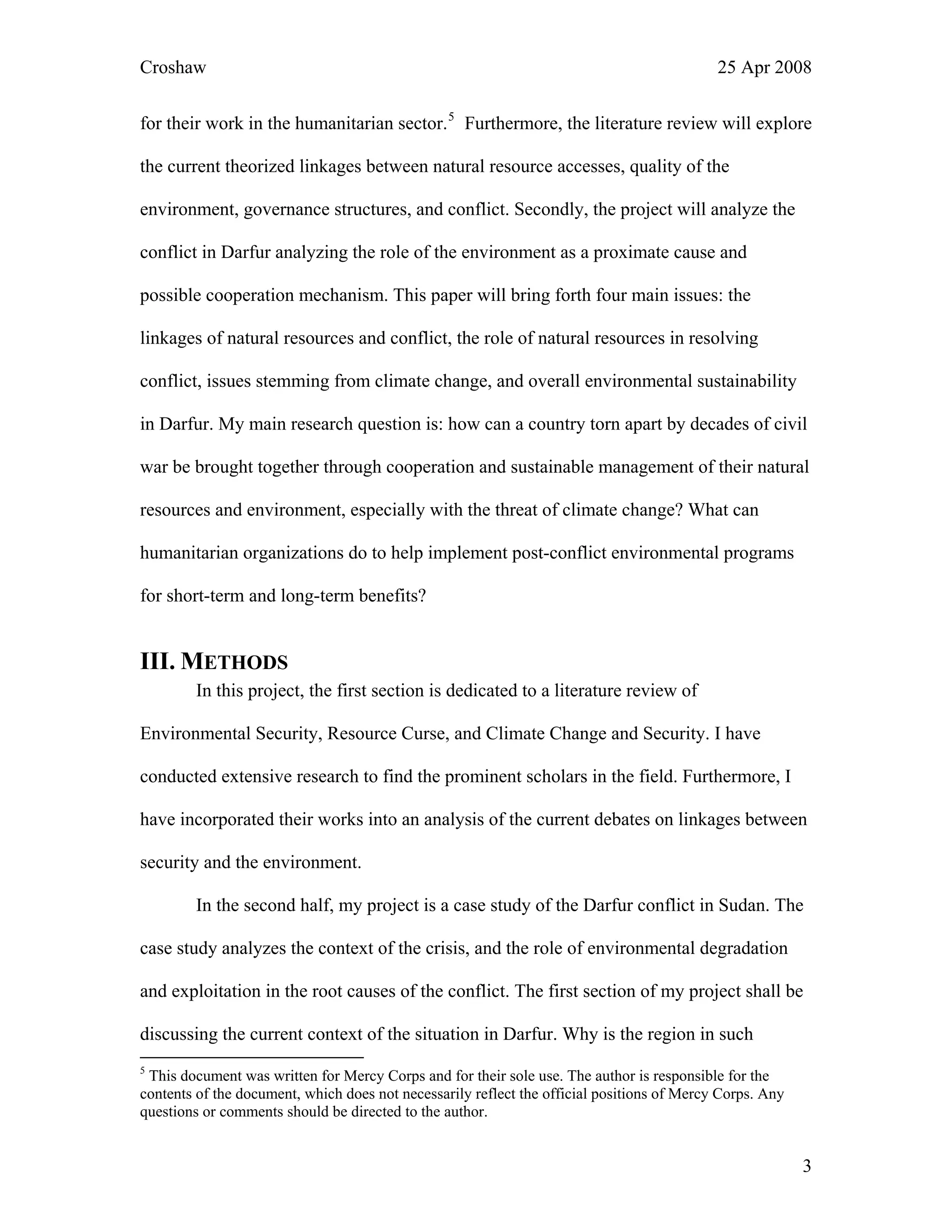

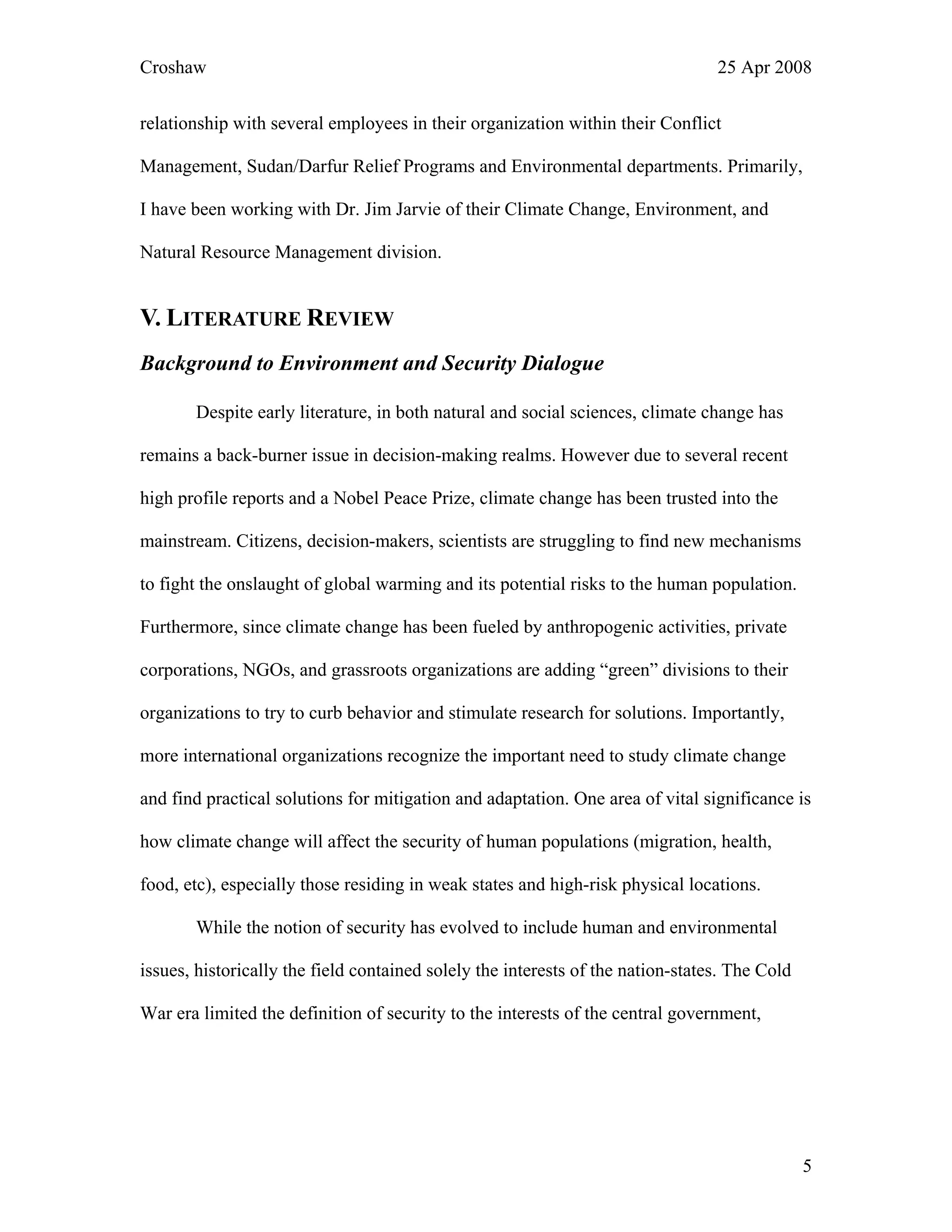
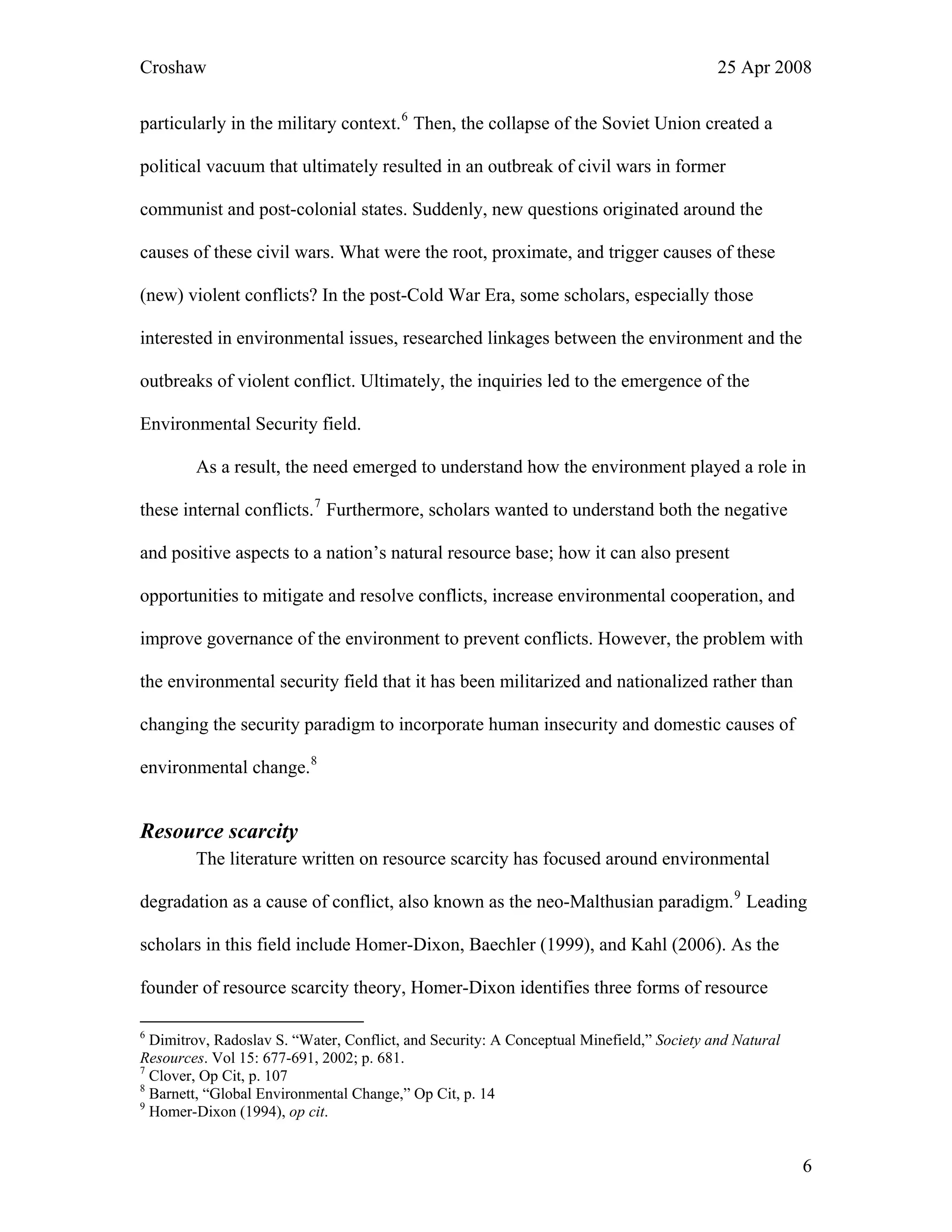
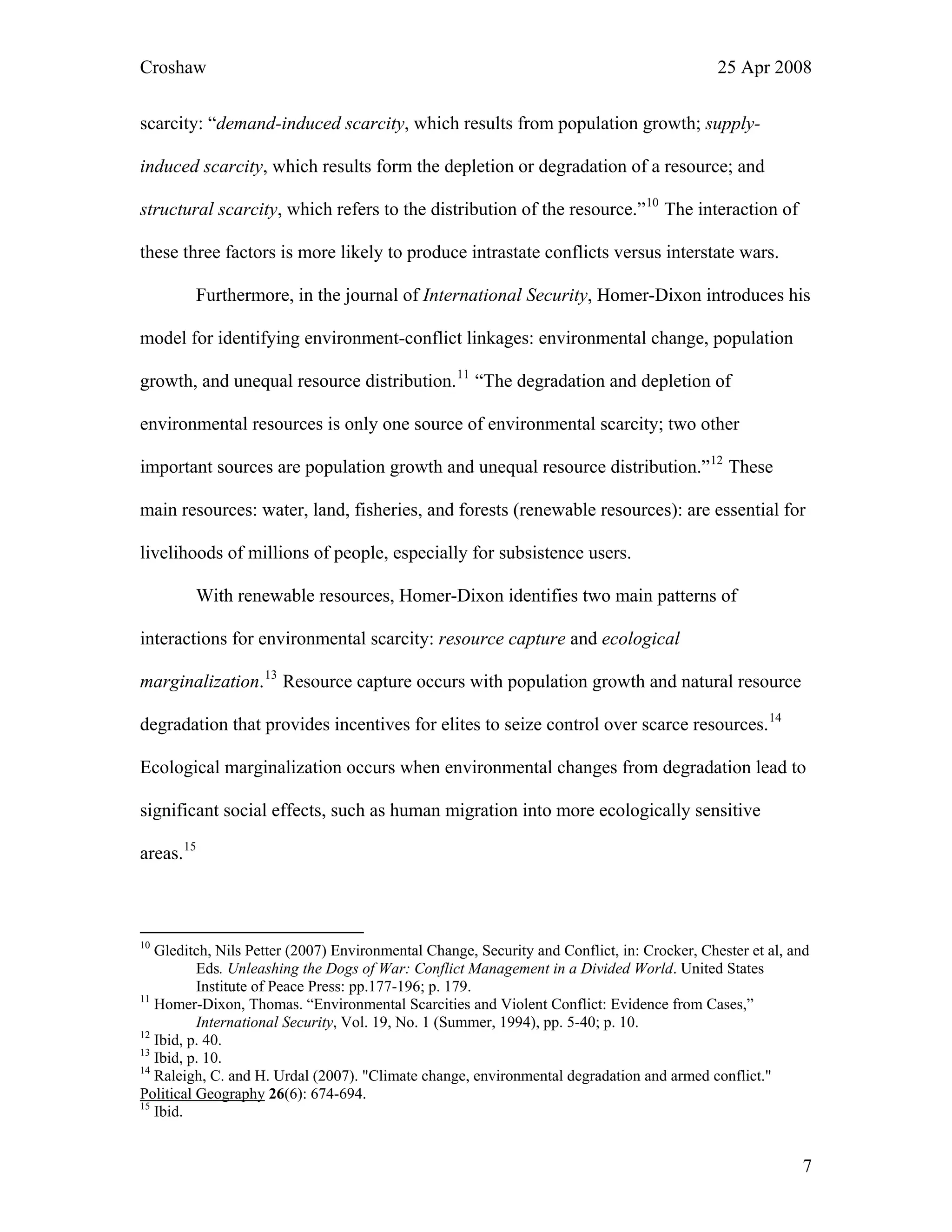
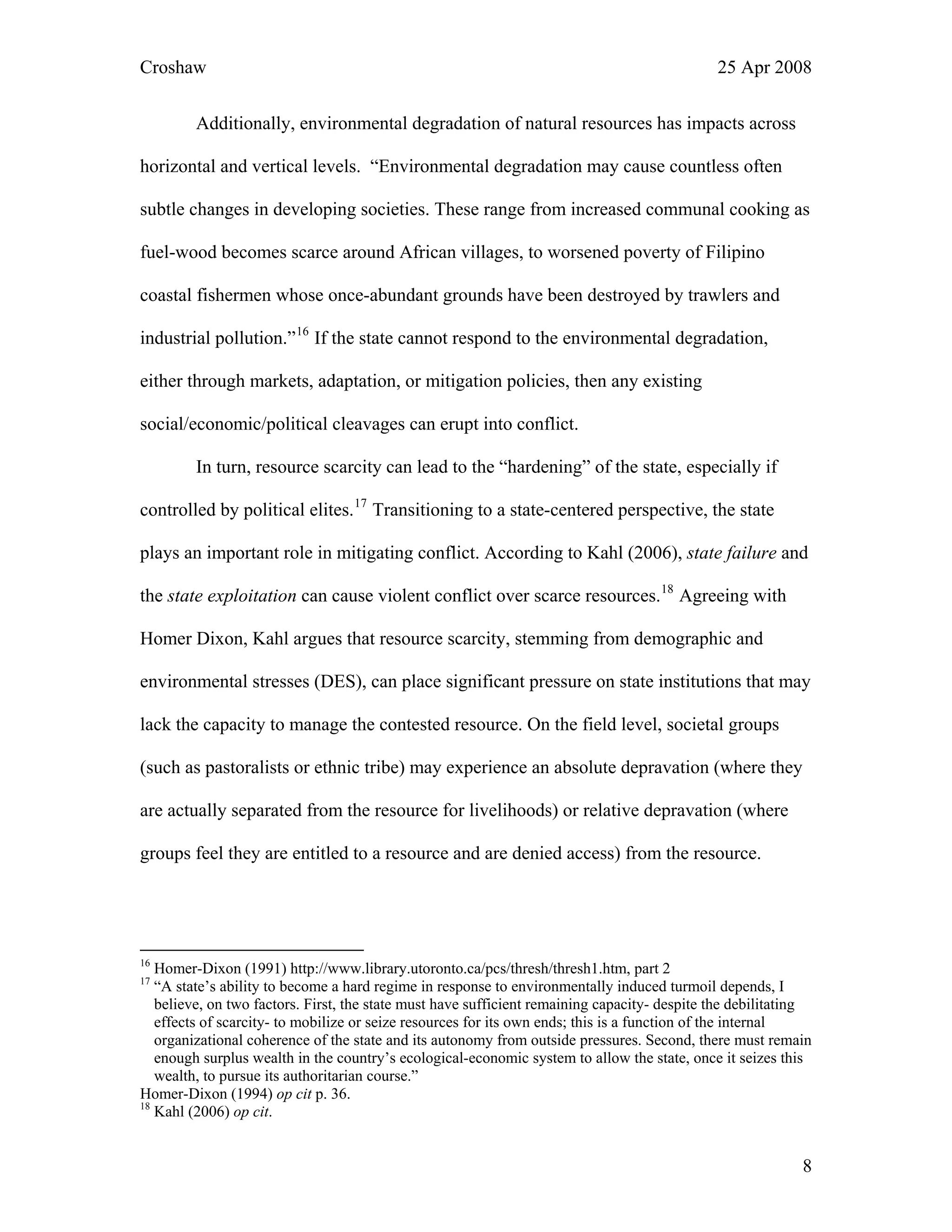
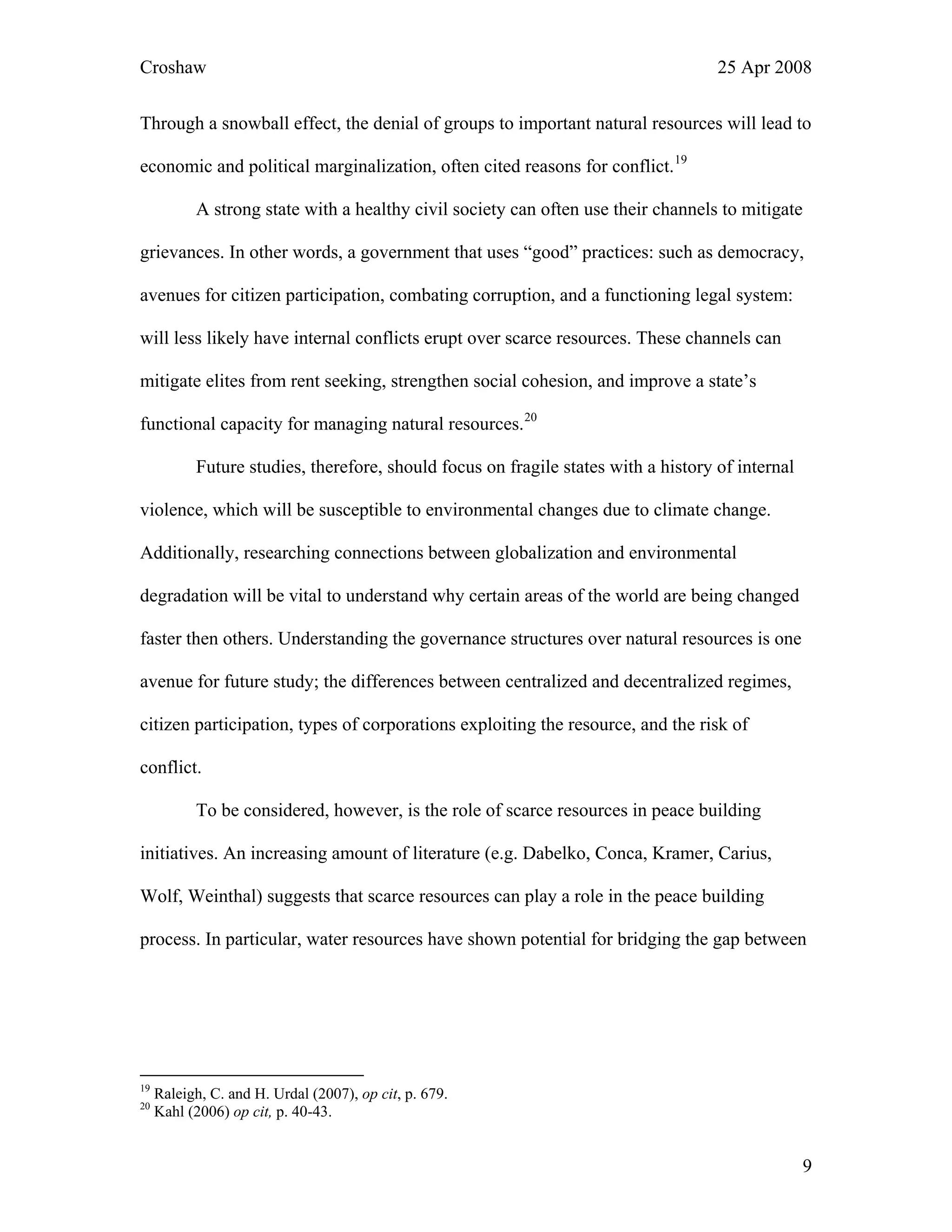
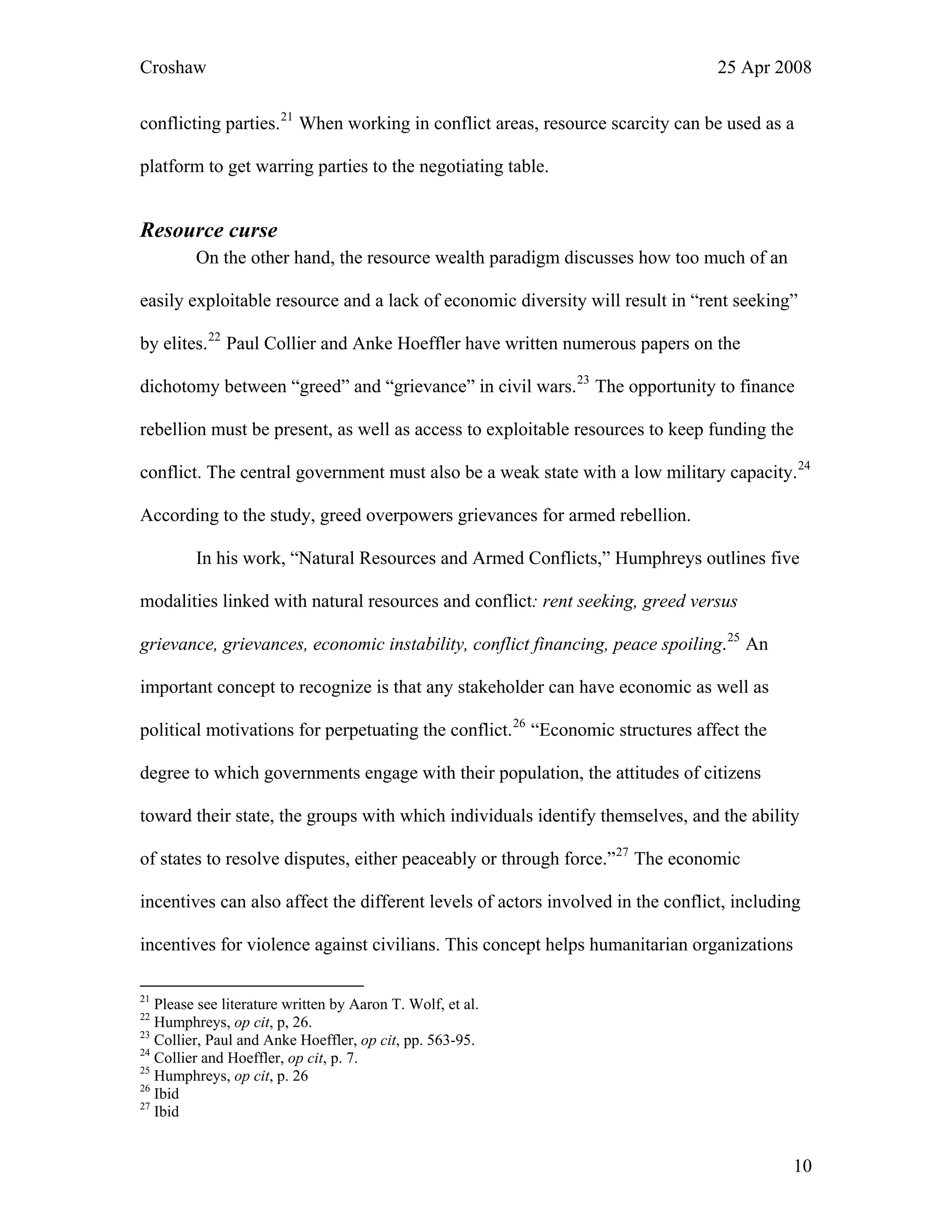
![Croshaw 25 Apr 2008
understand the linkages between the conflict between stakeholders and targeted violence
against their clients.
Climate Change and Environmental Security
In the international policy realm, climate change has gained more attention in the
past several years. With the release of the Fourth Assessment Report of the
Intergovernmental Panel on Climate Change, the scientific community has verified that
the “warming of the climate system is unequivocal, as is now evident from observations
of increases in global average air and ocean temperatures, widespread melting of snow
and ice, and rising global average sea level [emphasis added].”28
Additionally, in 2007,
the publishing of the Stern Review found that the “…the benefits of strong, early action
considerably outweigh the costs.”29
In particular, both reports strongly agree that
developing countries will be the hardest hit by climate change due to lack of financial,
technical, and institutional capacity. Importantly, the Stern review notes: “Climate-related
shocks have sparked violent conflict in the past, and conflict is a serious risk in areas
such as West Africa, the Nile Basin, and Central Asia.”30
Analyzing the linkages between
climate change and conflict has found a renewed interest.
Despite the renewed interest in the climate change and security nexus, the
phenomenon is not new. In the 1970s, Richard Falk’s This Endangered Planet and Lester
Brown’s Redefining National Security both explored the connections between security
28
Intergovernmental Panel on Climate Change. Fourth Assessment Report. Climate Change 2007:
Synthesis Report, Summary for Policymakers. Last accessed 19 Feb. 2008
<http://www.ipcc.ch/pdf/assessment-report/ar4/wg1/ar4-wg1-spm.pdf>, p. 2.
29
Stern Review, p. ii.
30
Stern Review, p. viii.
11](https://image.slidesharecdn.com/9cf9284a-b20c-4b4a-b7ec-c17601a02e45-150317122303-conversion-gate01/75/MP_hrc4_a_200805-15-2048.jpg)
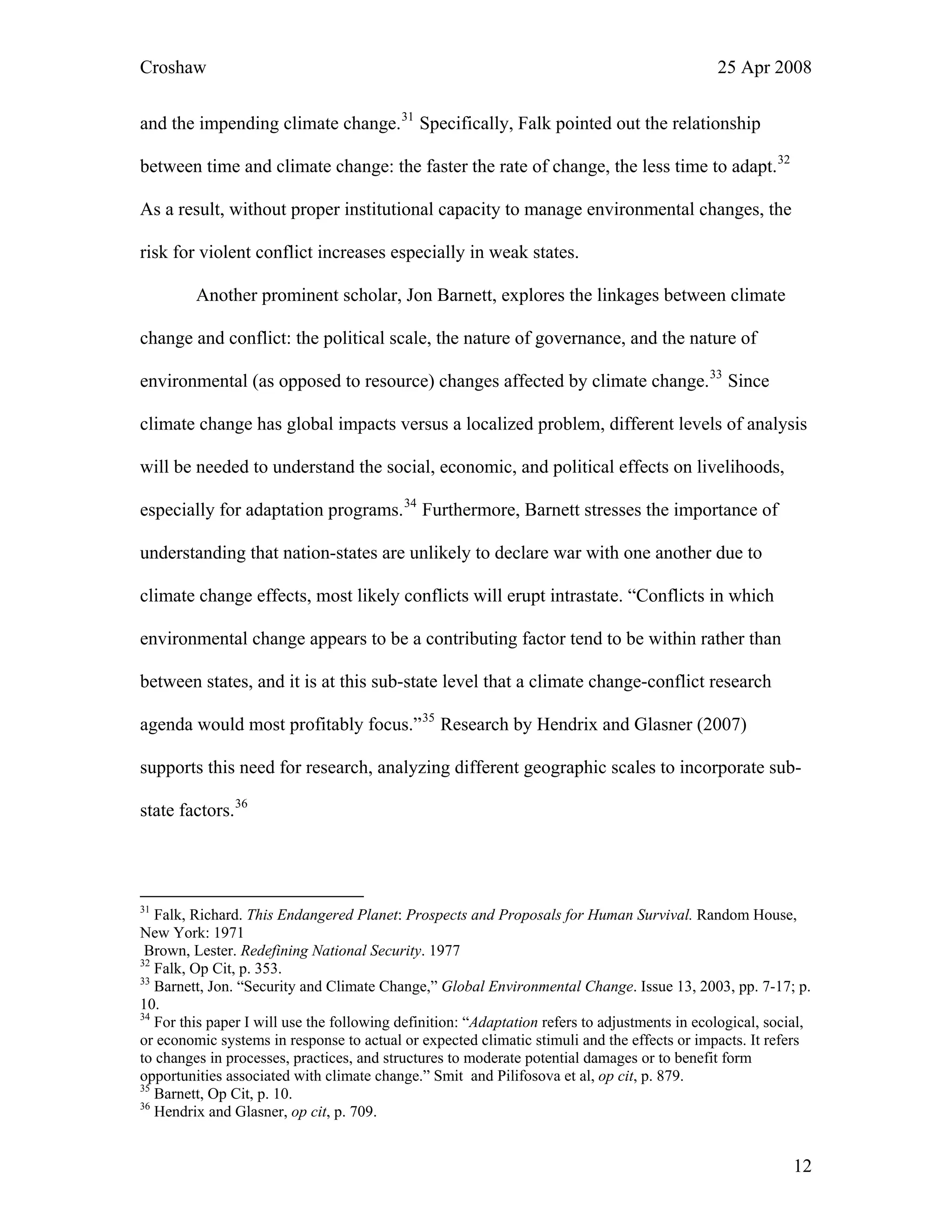

![Croshaw 25 Apr 2008
provide public services. With impending climate change, a state’s capacity for mitigation
and adaptation will be crucial. As a result, targeting weak states is paramount for
preventing climate change related conflicts.
Essentially, climate change will significantly affect livelihood securities as well.
“The impacts of future changes [of climate change] will be felt primarily by resource-
dependent communities through a multitude of primary and secondary effects cascading
through natural and social systems.”44
Some impacts will be gradual, such as
desertification, droughts, or rising sea levels, or some immediate with increased heat
waves or strong storms. Despite the type of environmental change, the underlying issue
remains the same: human livelihood insecurity. An urgent need develops for the state to
increase their role for service delivery and less on their traditional national security
agendas.
…Climate change undermines human security in the present day,
and will increasingly do so in the future. It does this by reducing
people’s access to natural resources that are important to sustain
their livelihoods. Climate change is also likely to undermine the
capacity of states to provide opportunities and services that help
people to sustain their livelihoods, and which help to maintain and
build peace. In certain circumstances, these direct and indirect
impacts of climate change on human security and the state may in
turn increase the risk of violent conflict.45
Therefore, climate change adaptation projects, especially those in weak states,
should focus on increasing the state capacity for conflict prevention. The state will need
to handle significant macro issues such as disaster relief programs, food insecurity from
44
Adger, W. Nei. “Social Capital, Collective Action, and Adaptation to Climate Change,” Economic
Geography. 79(4): 387-404, 2003; p. 387.
45
Barnett, Jon and W. Neil Adger. “Climate change, human security and violent conflict,” Political
Geography. Vol. 26, 2007, pp. 639-655; p. 651.
14](https://image.slidesharecdn.com/9cf9284a-b20c-4b4a-b7ec-c17601a02e45-150317122303-conversion-gate01/75/MP_hrc4_a_200805-18-2048.jpg)
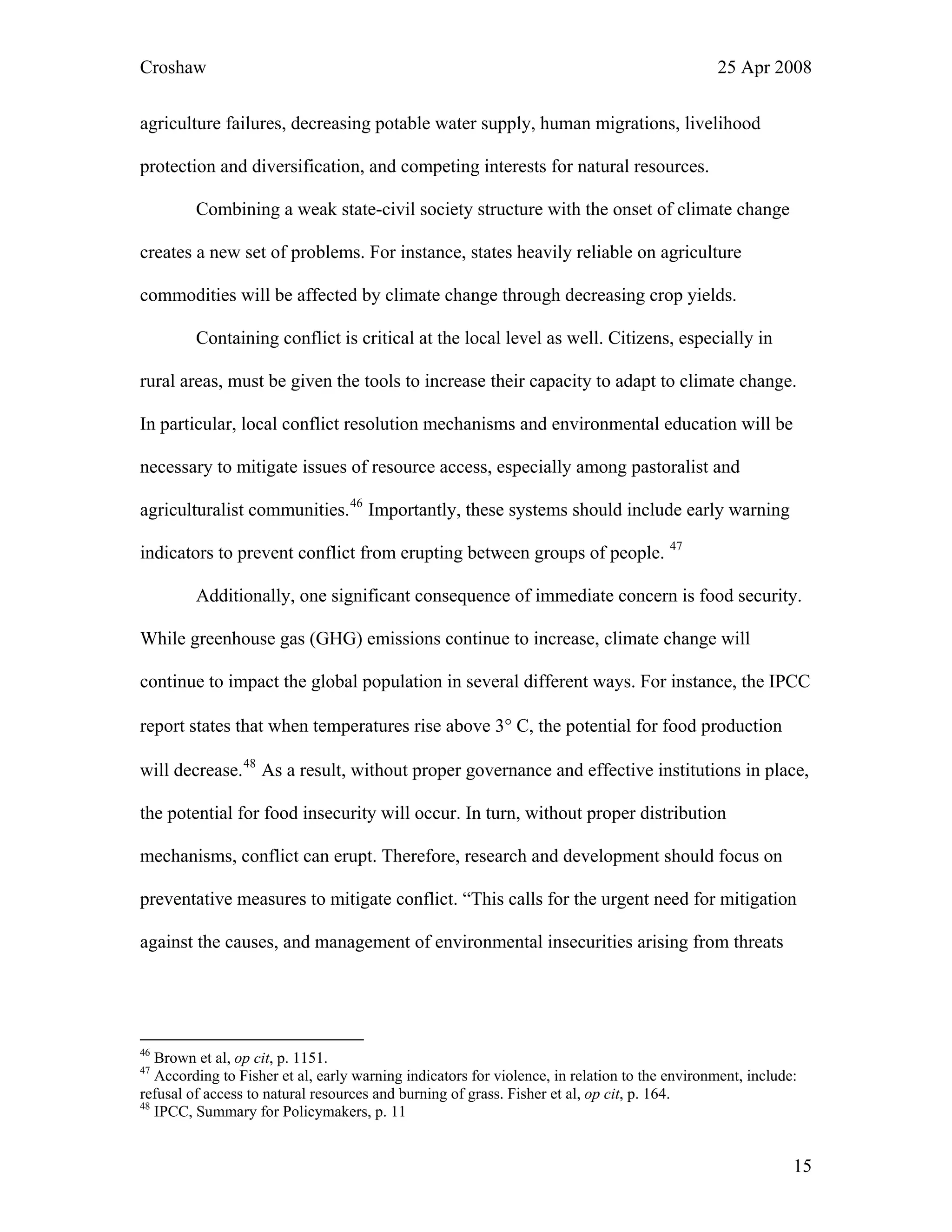
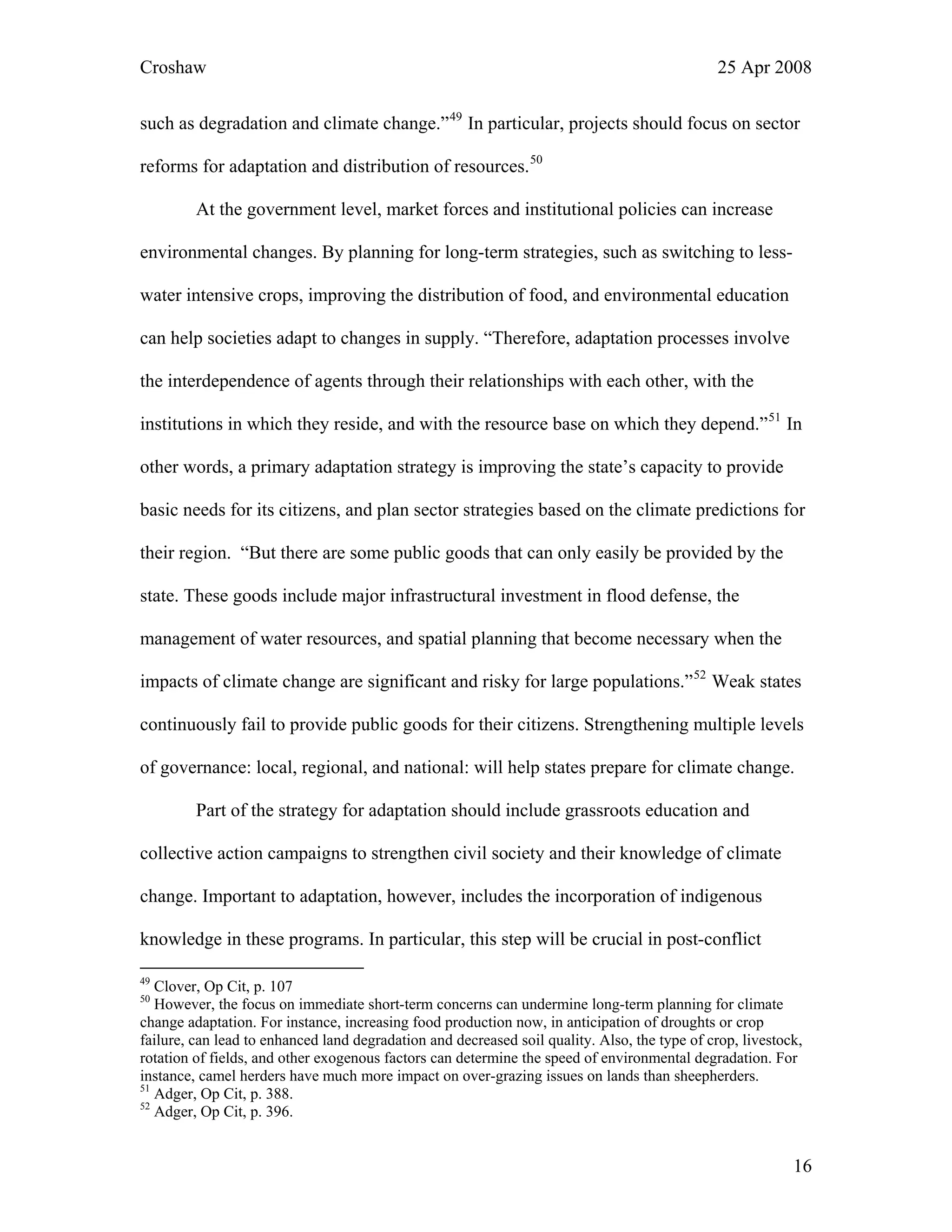
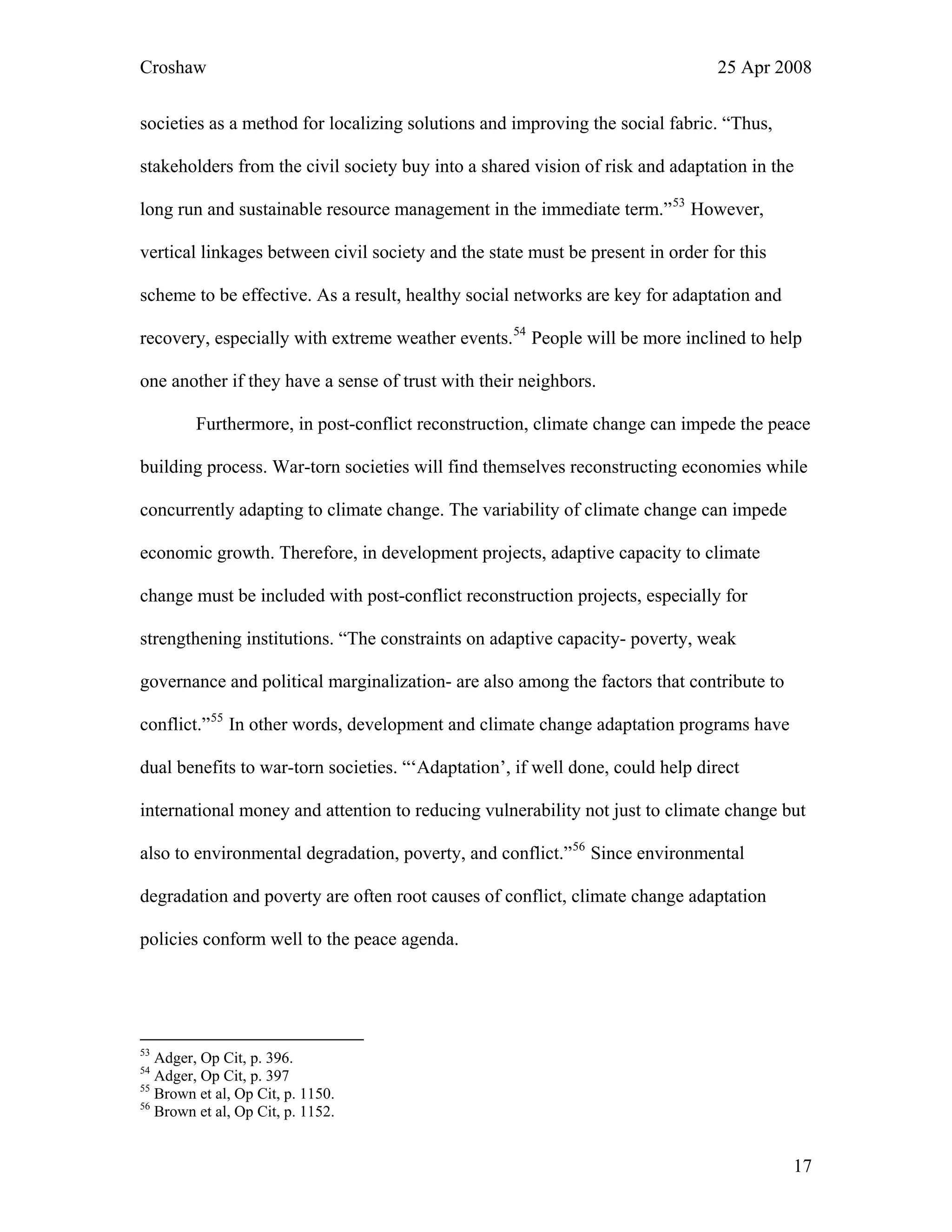
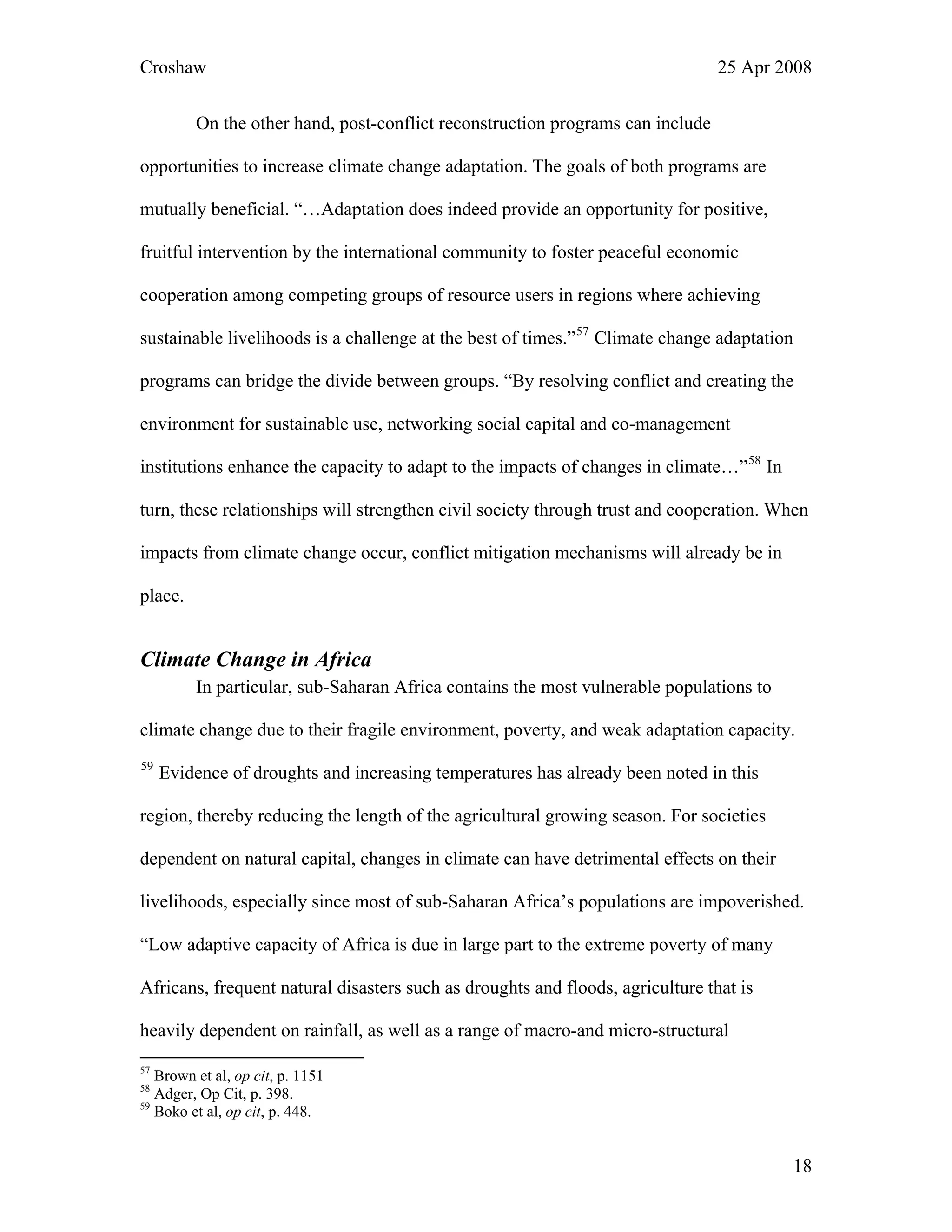
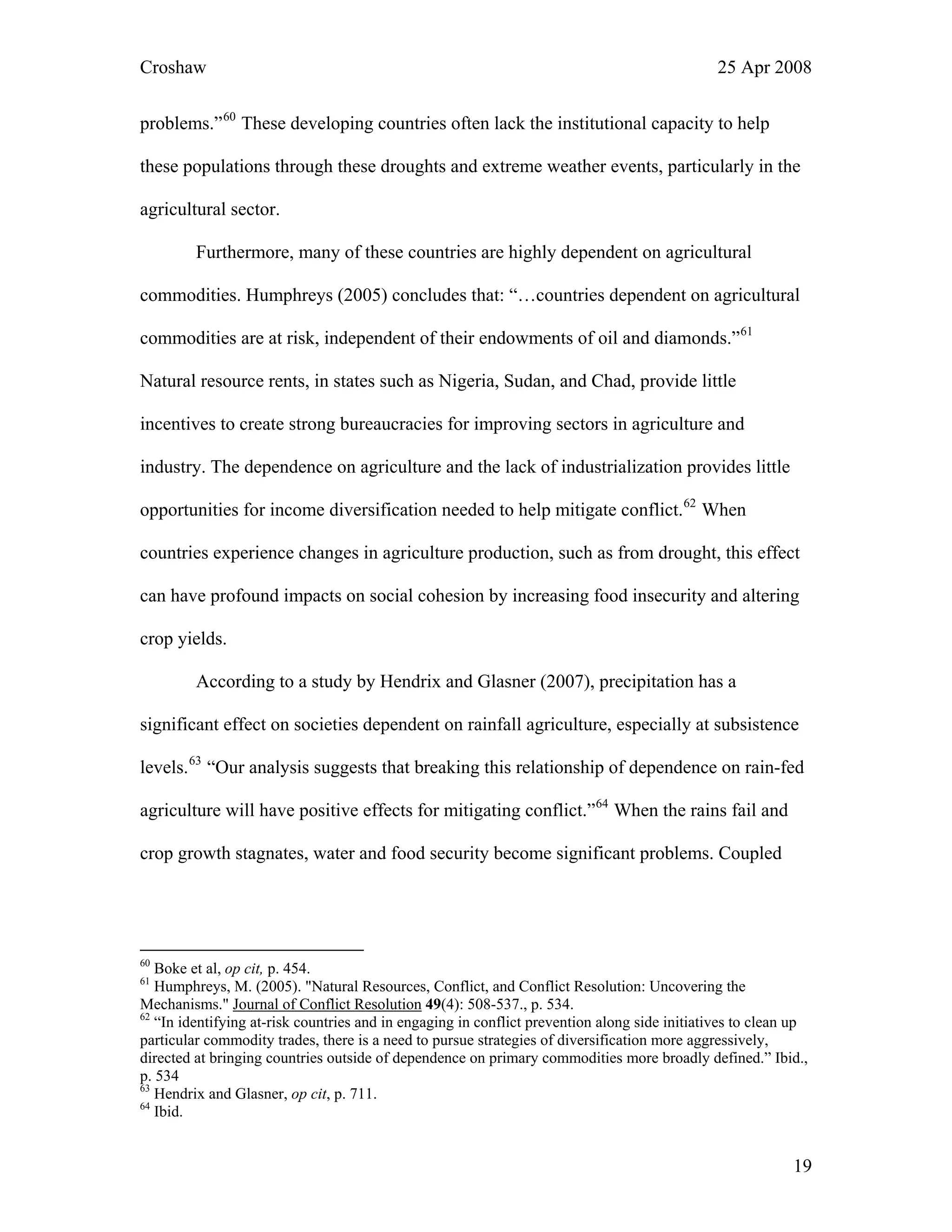
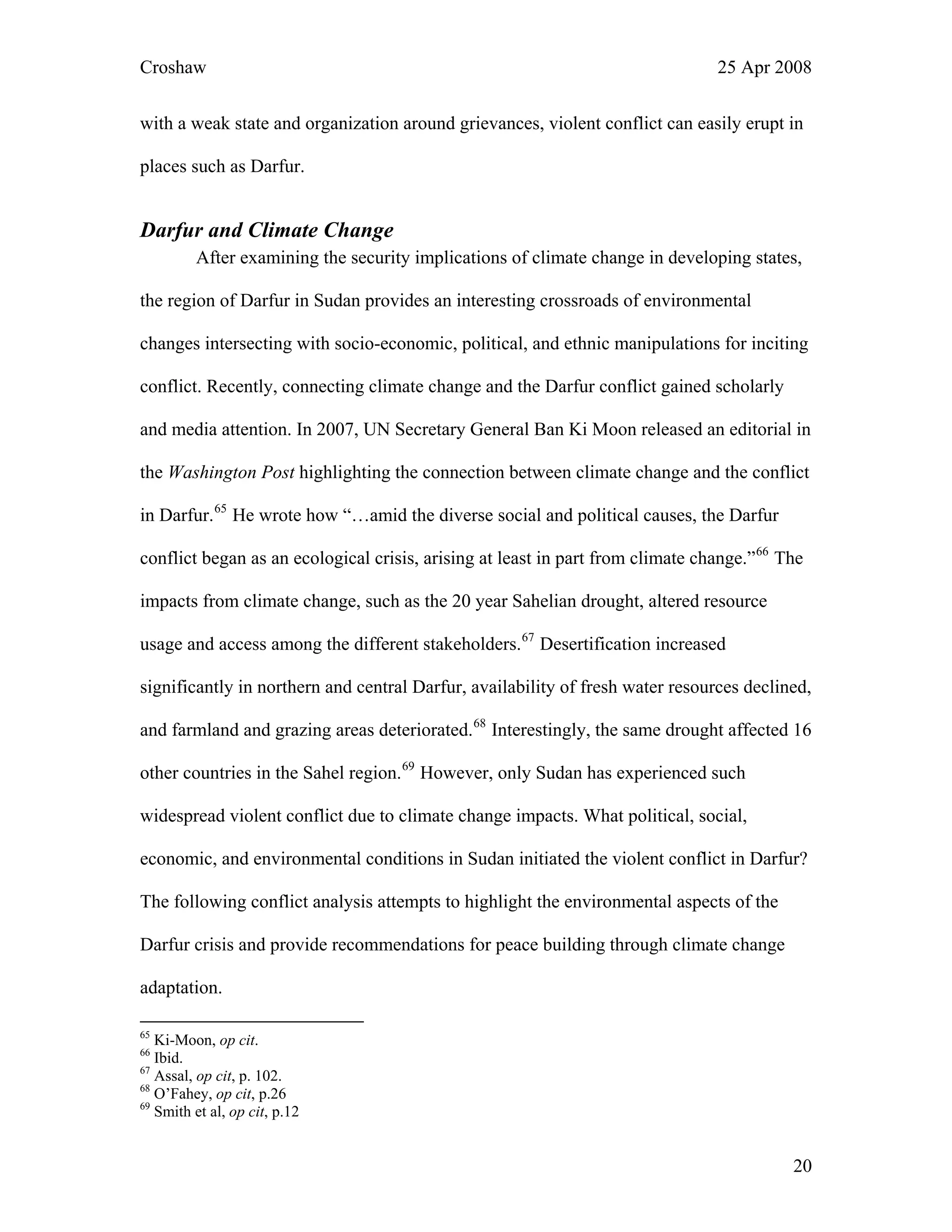
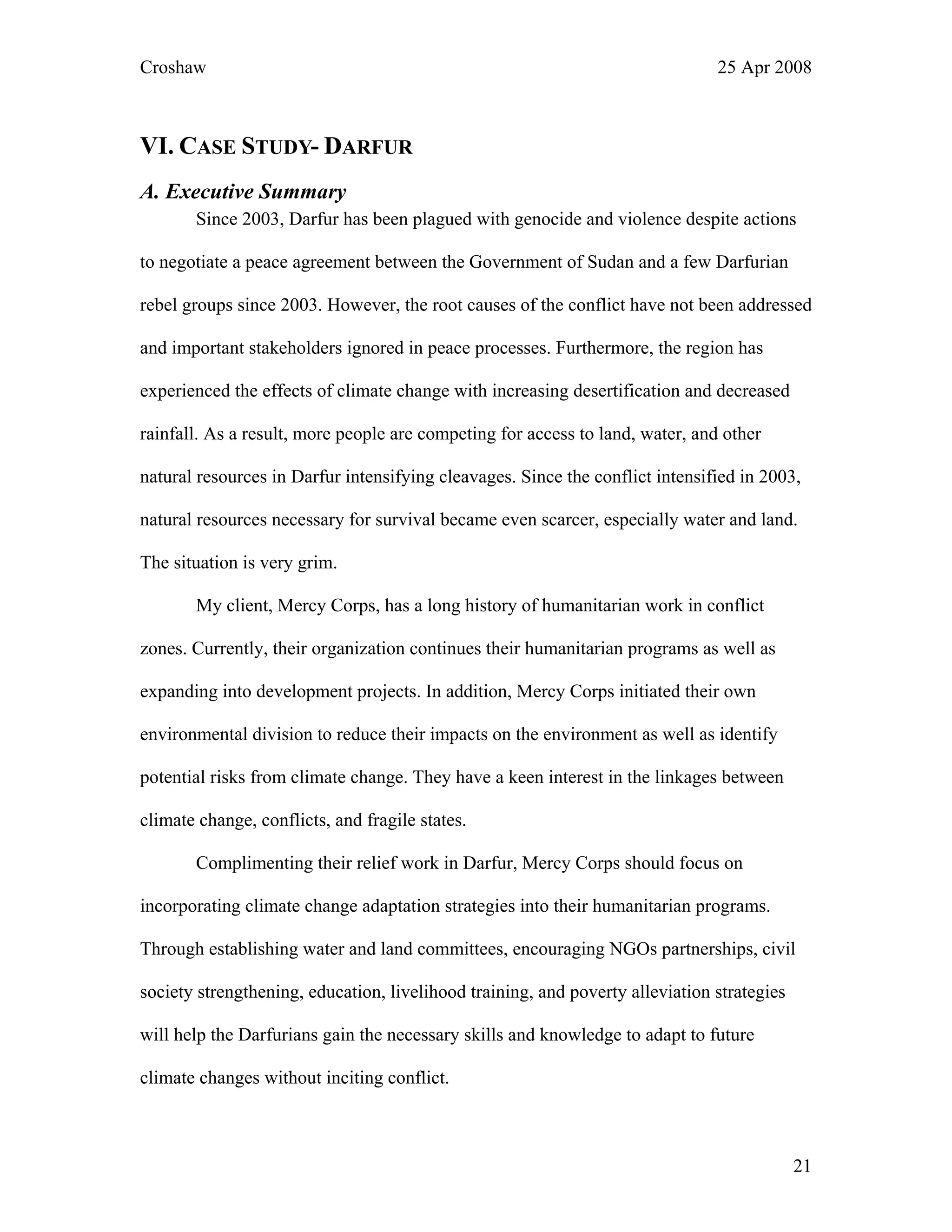
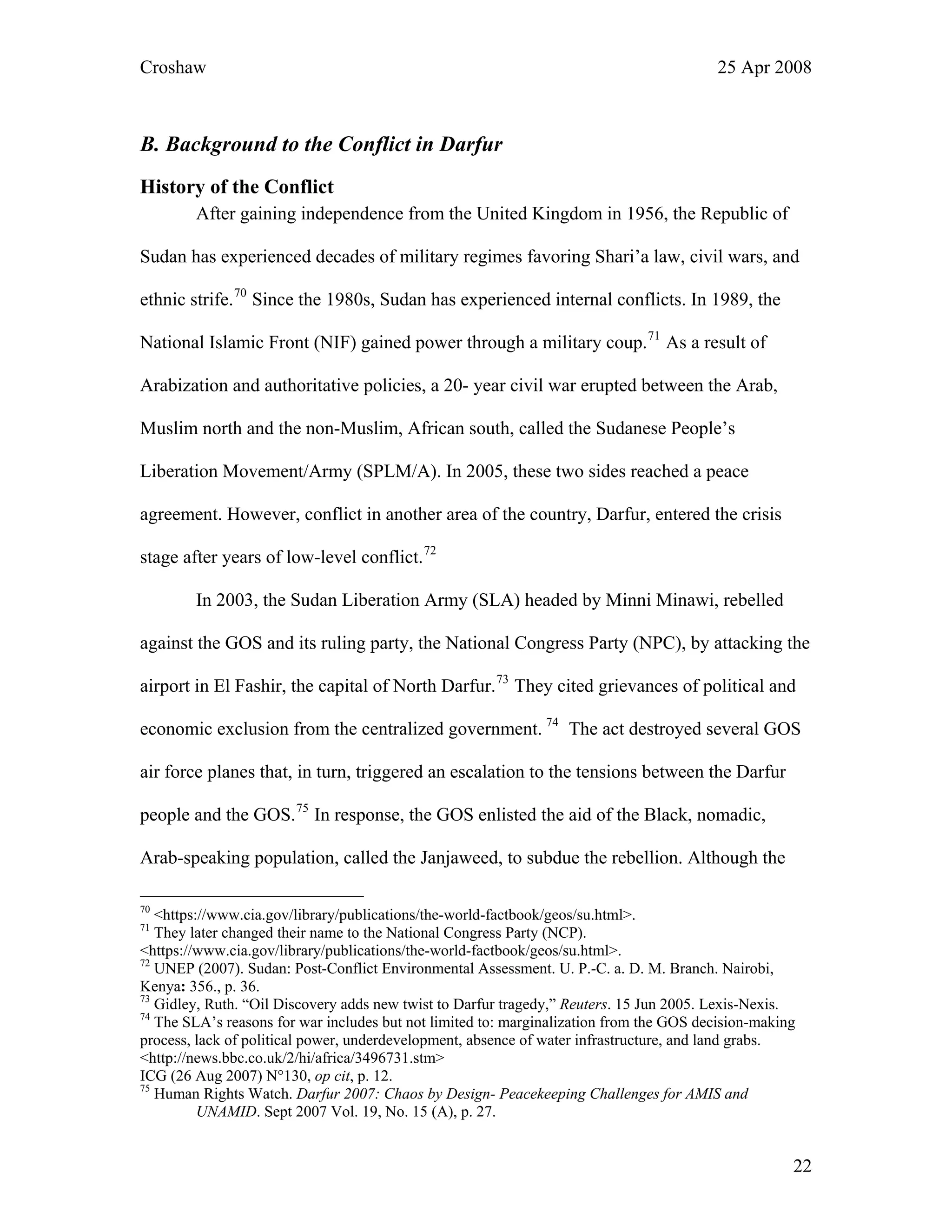
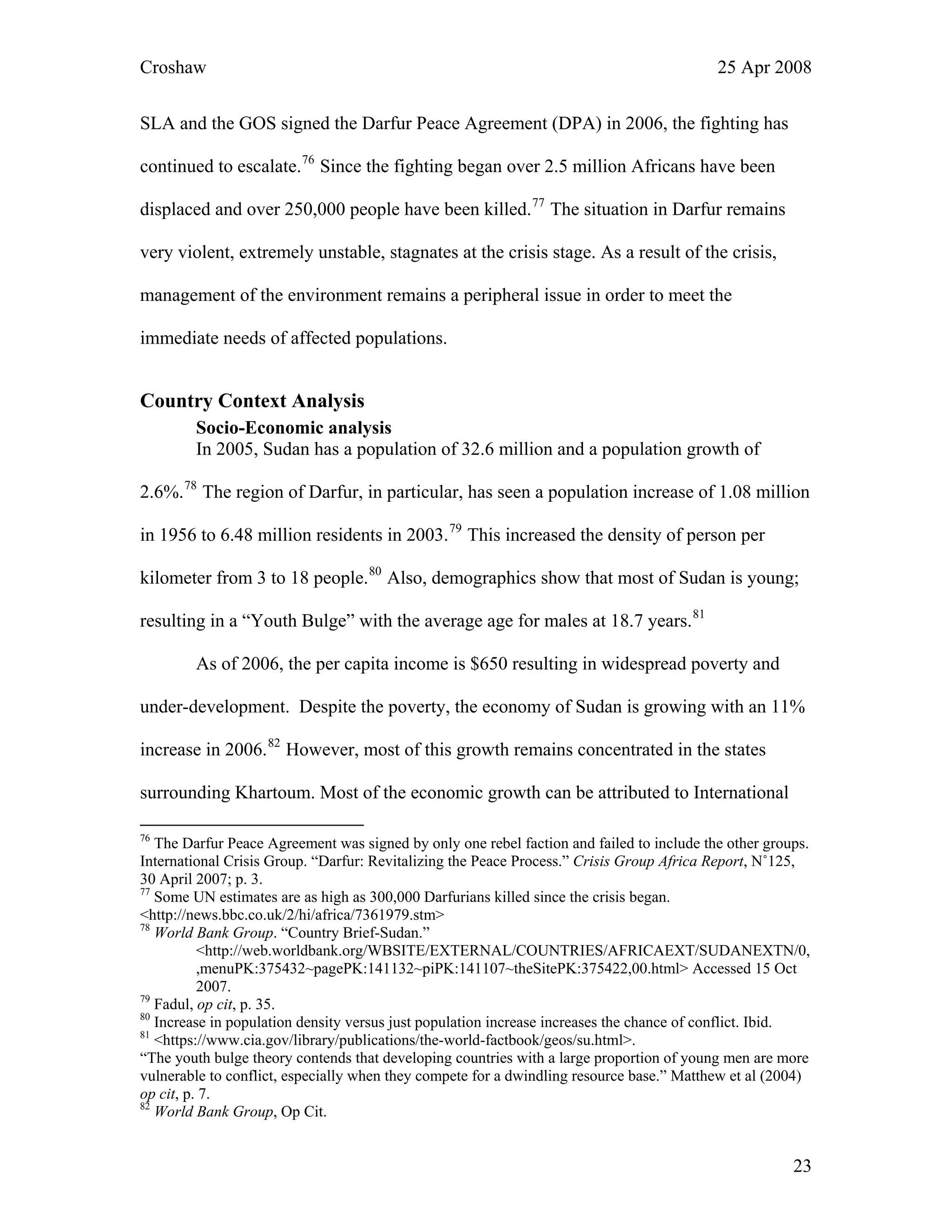
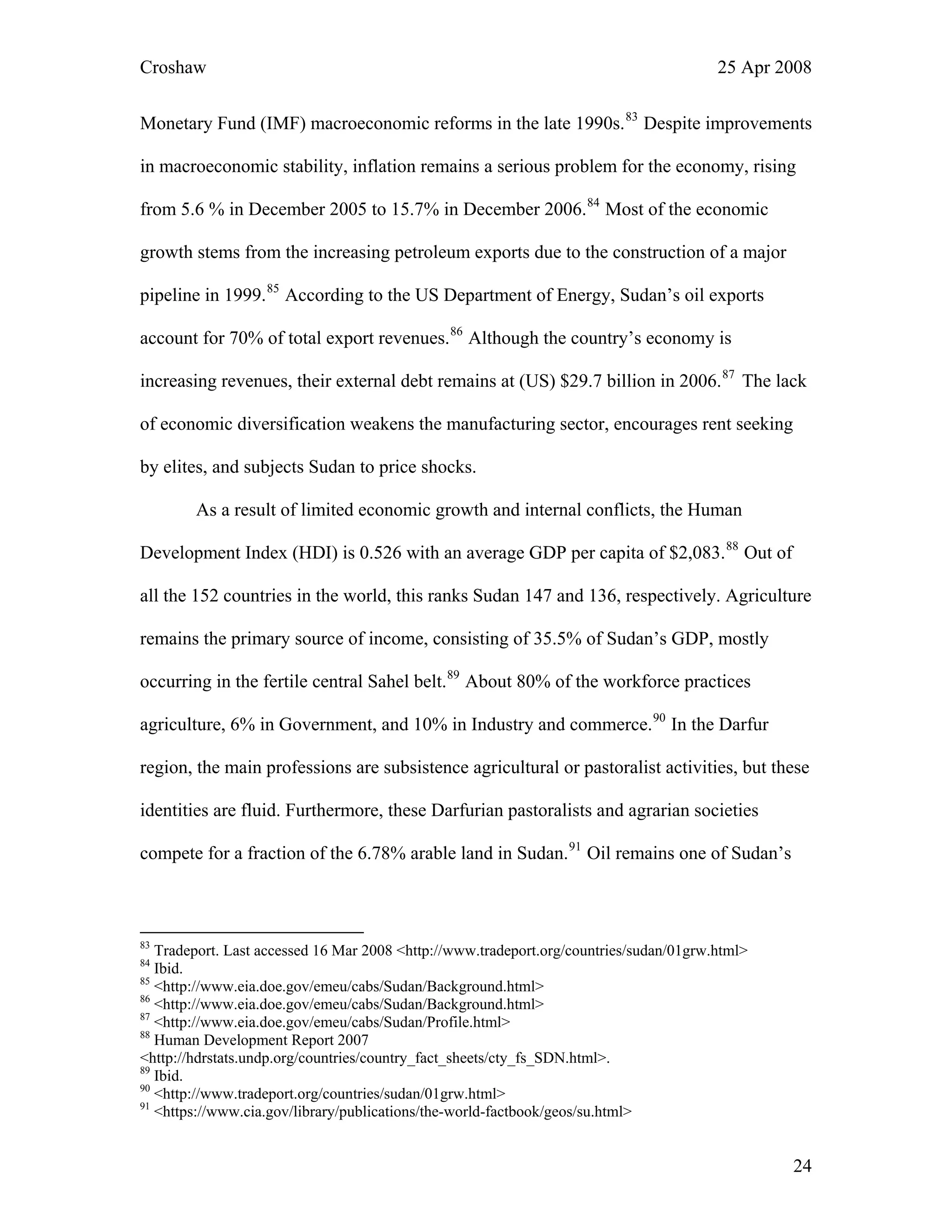
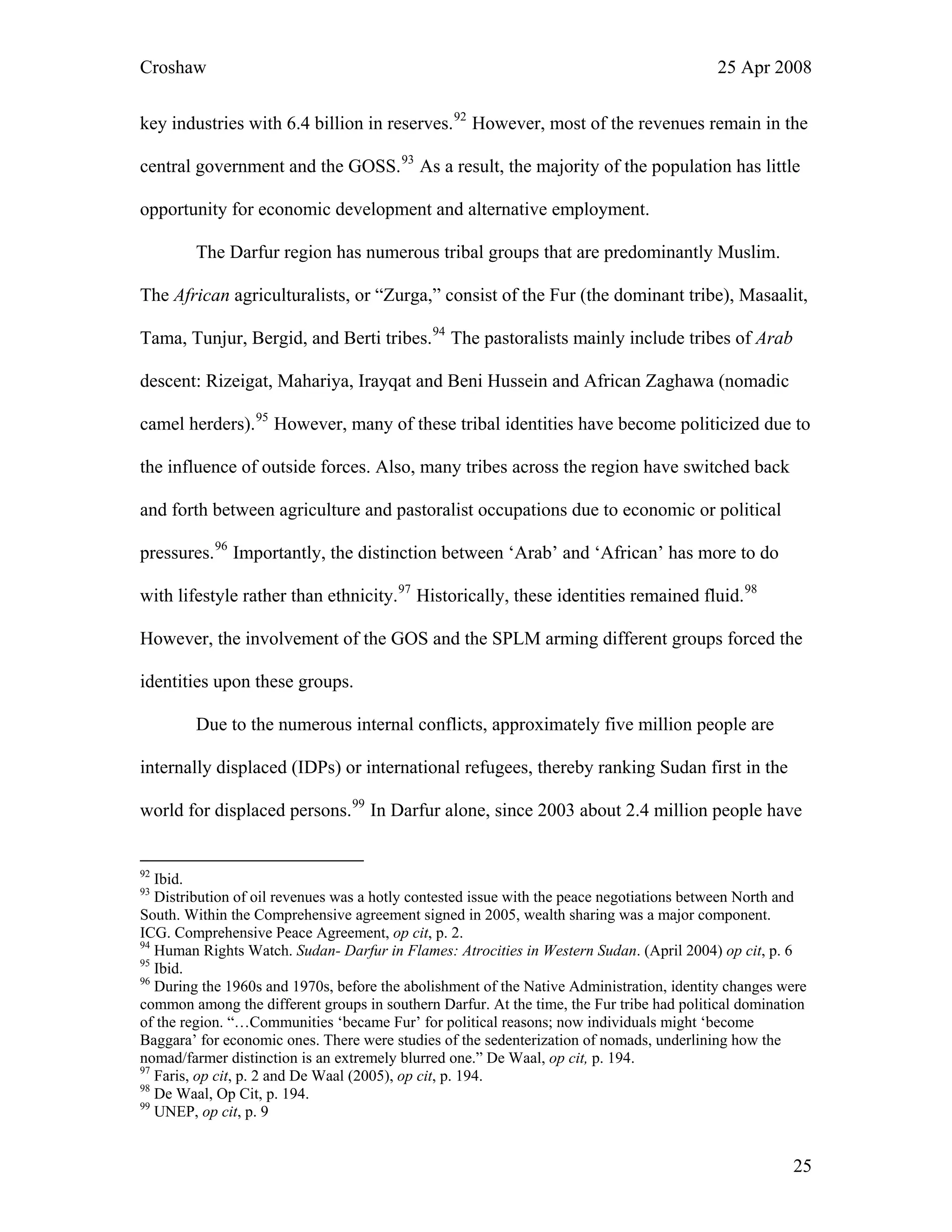
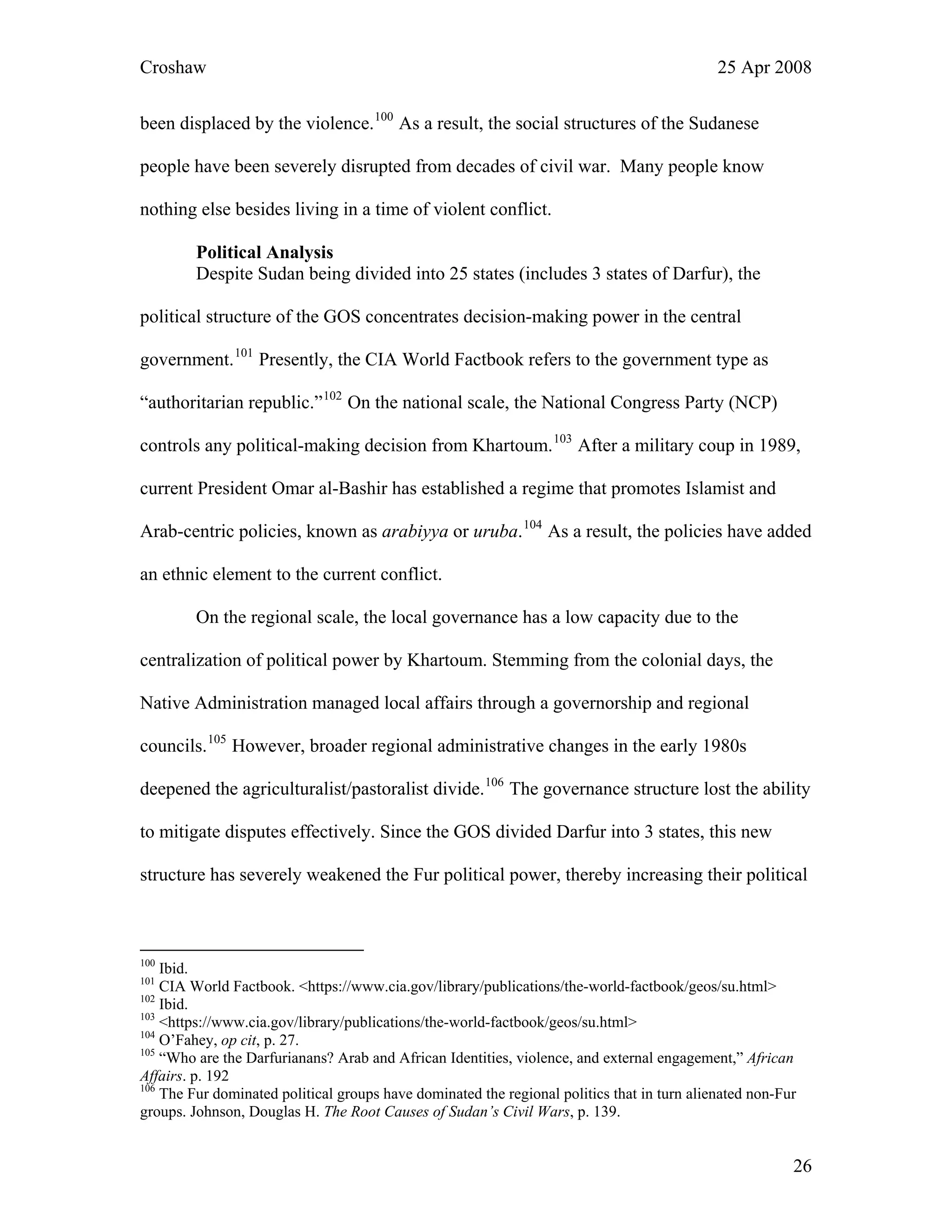

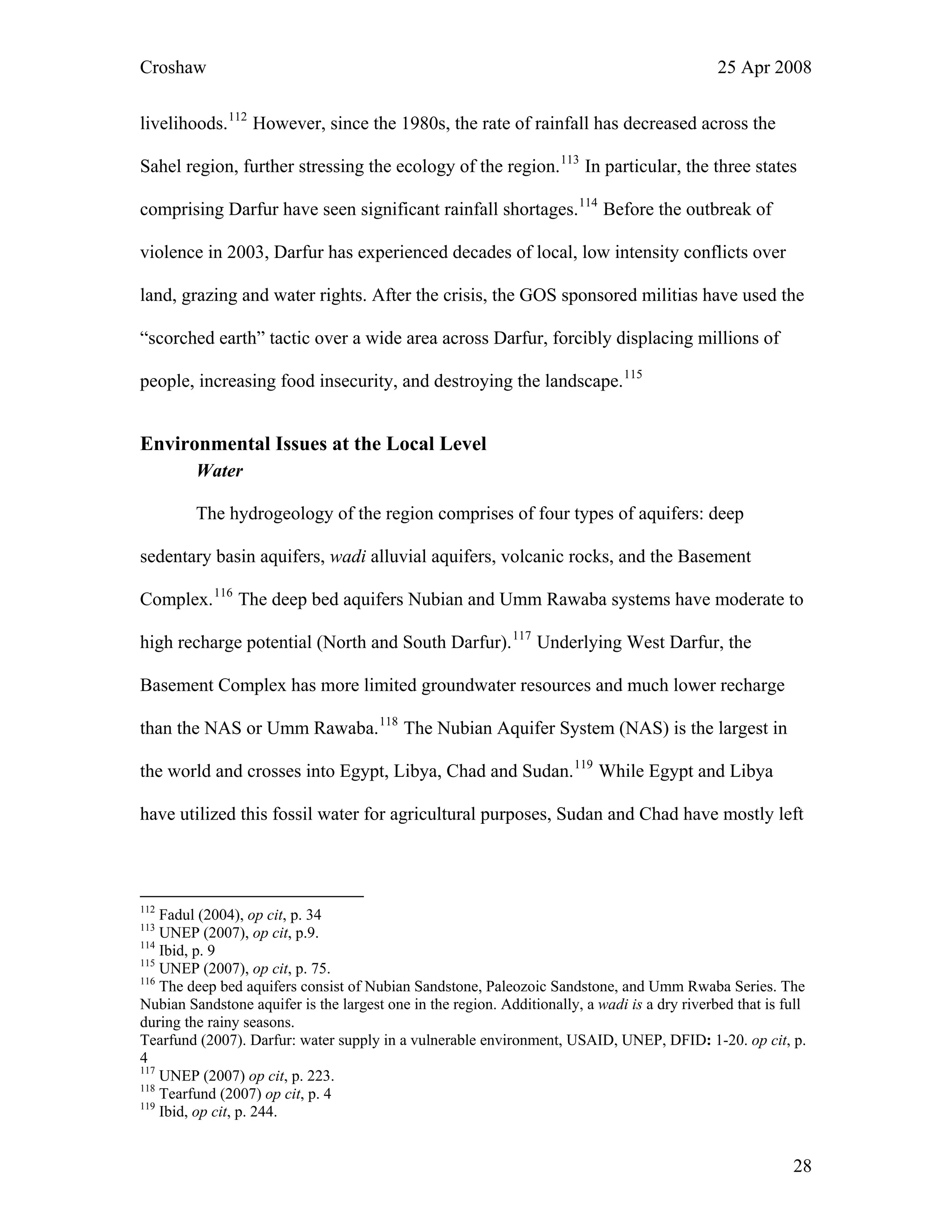
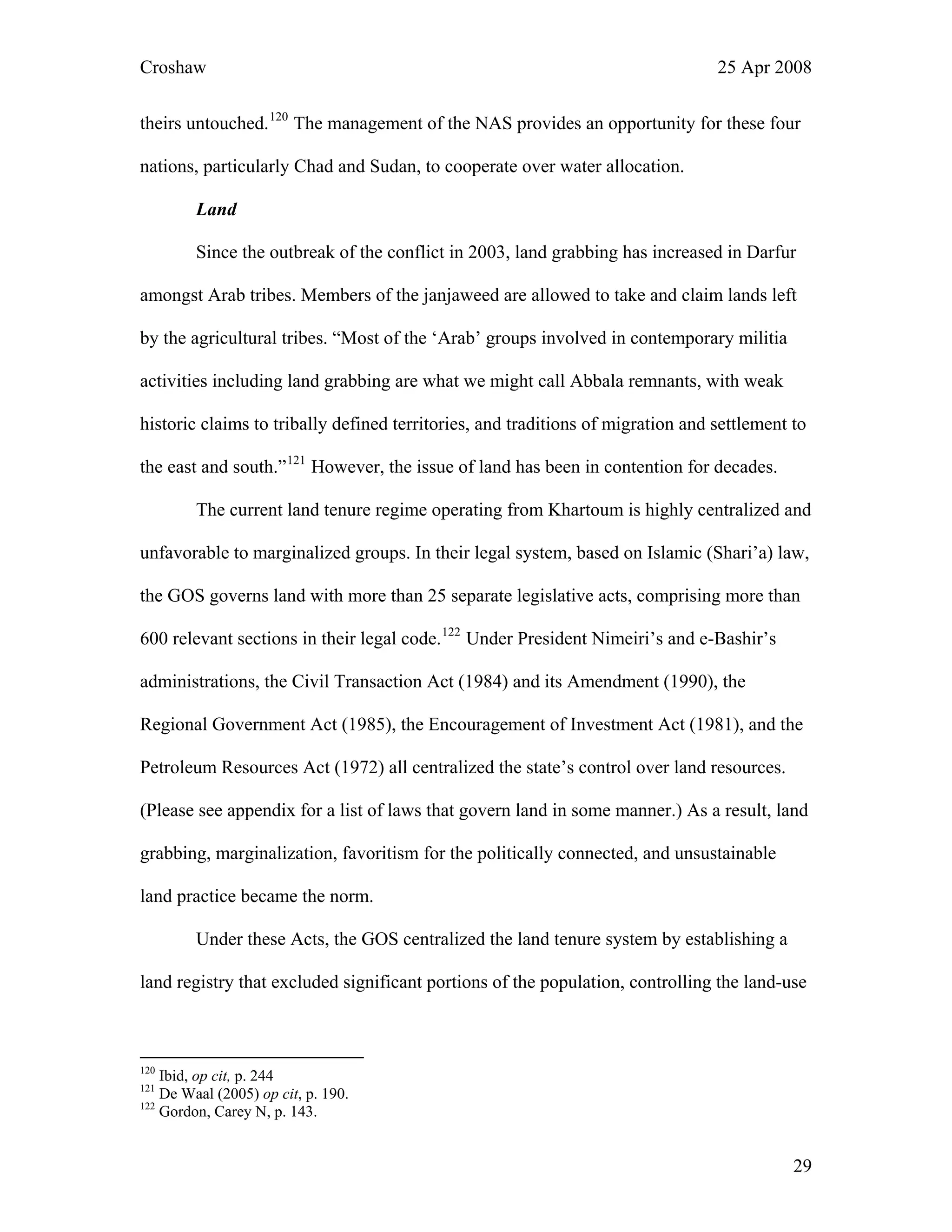

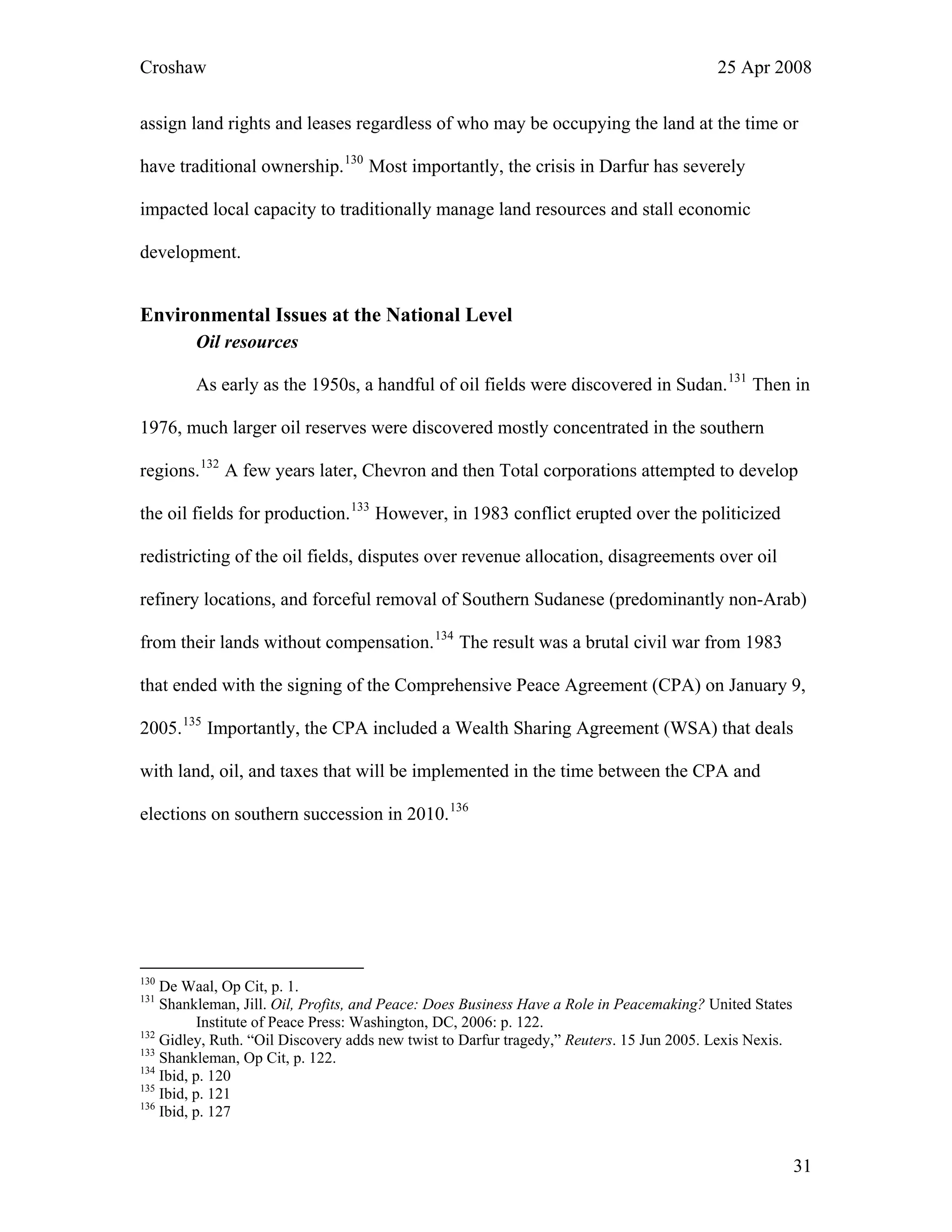
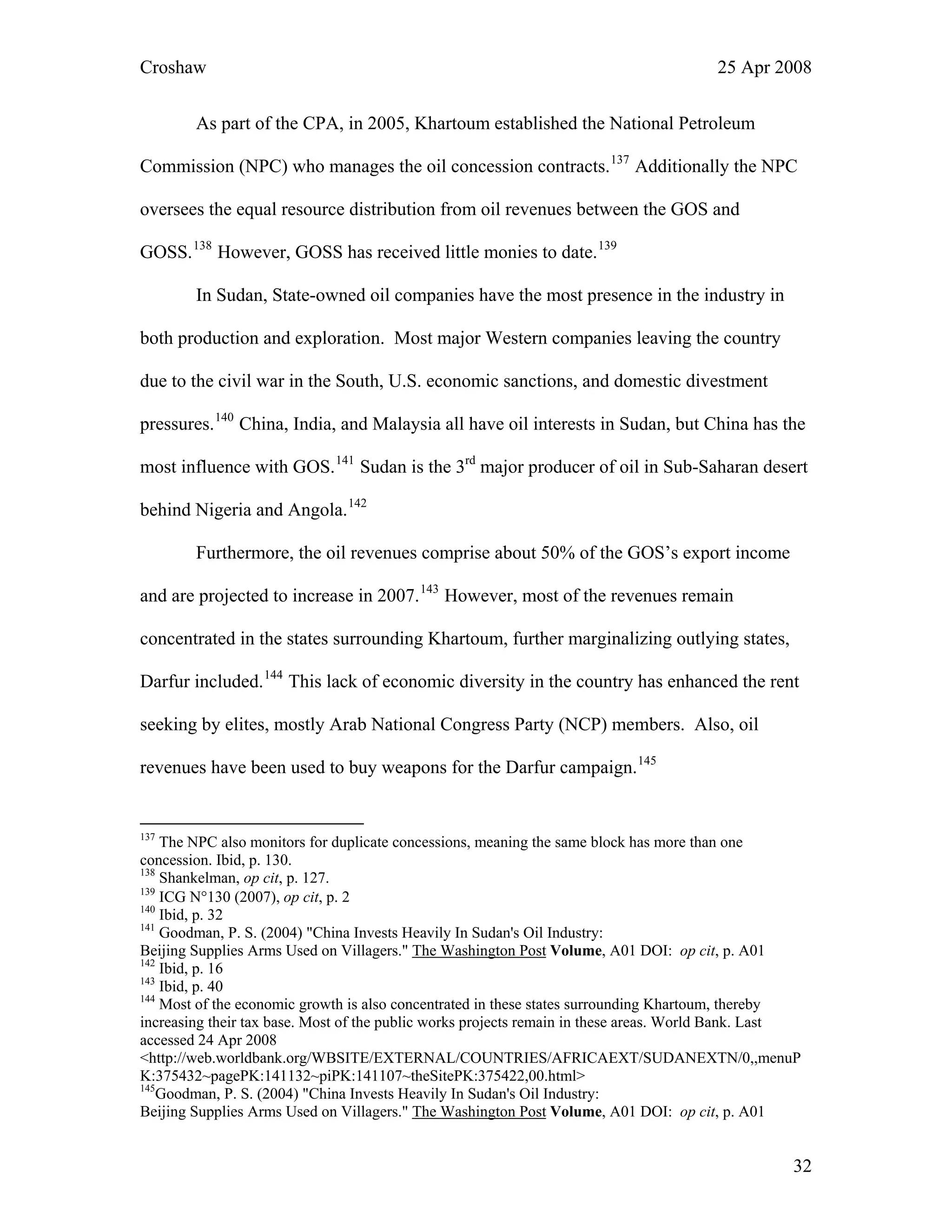
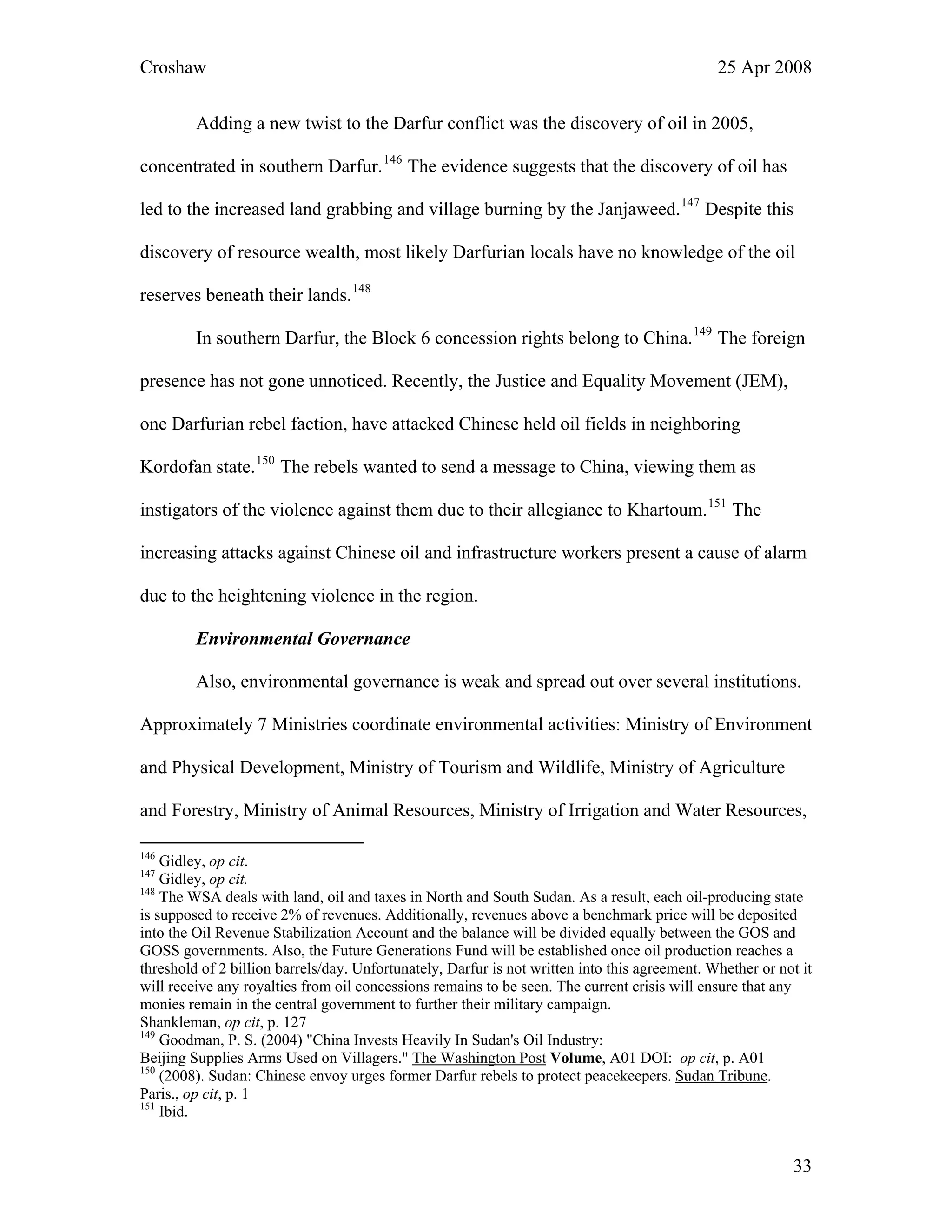
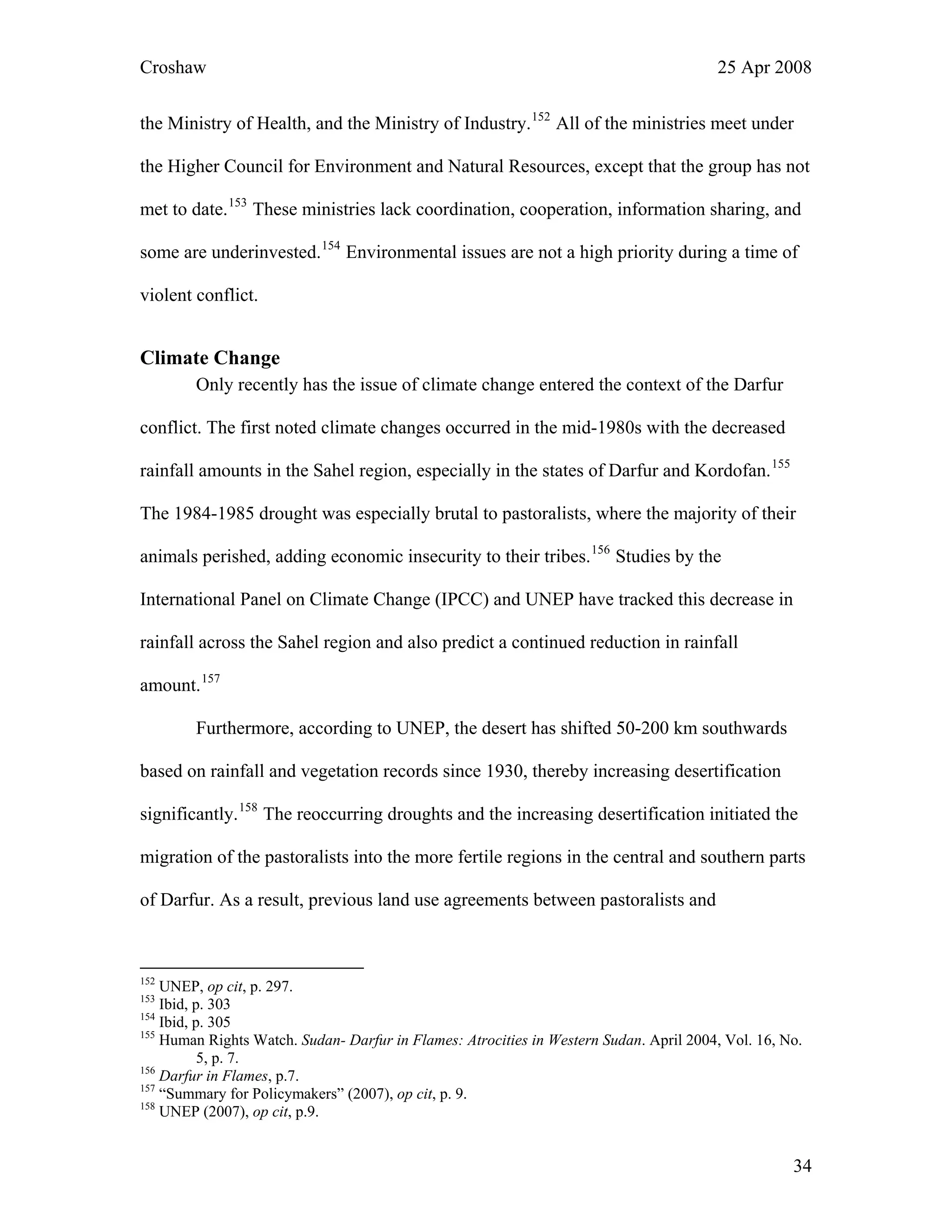
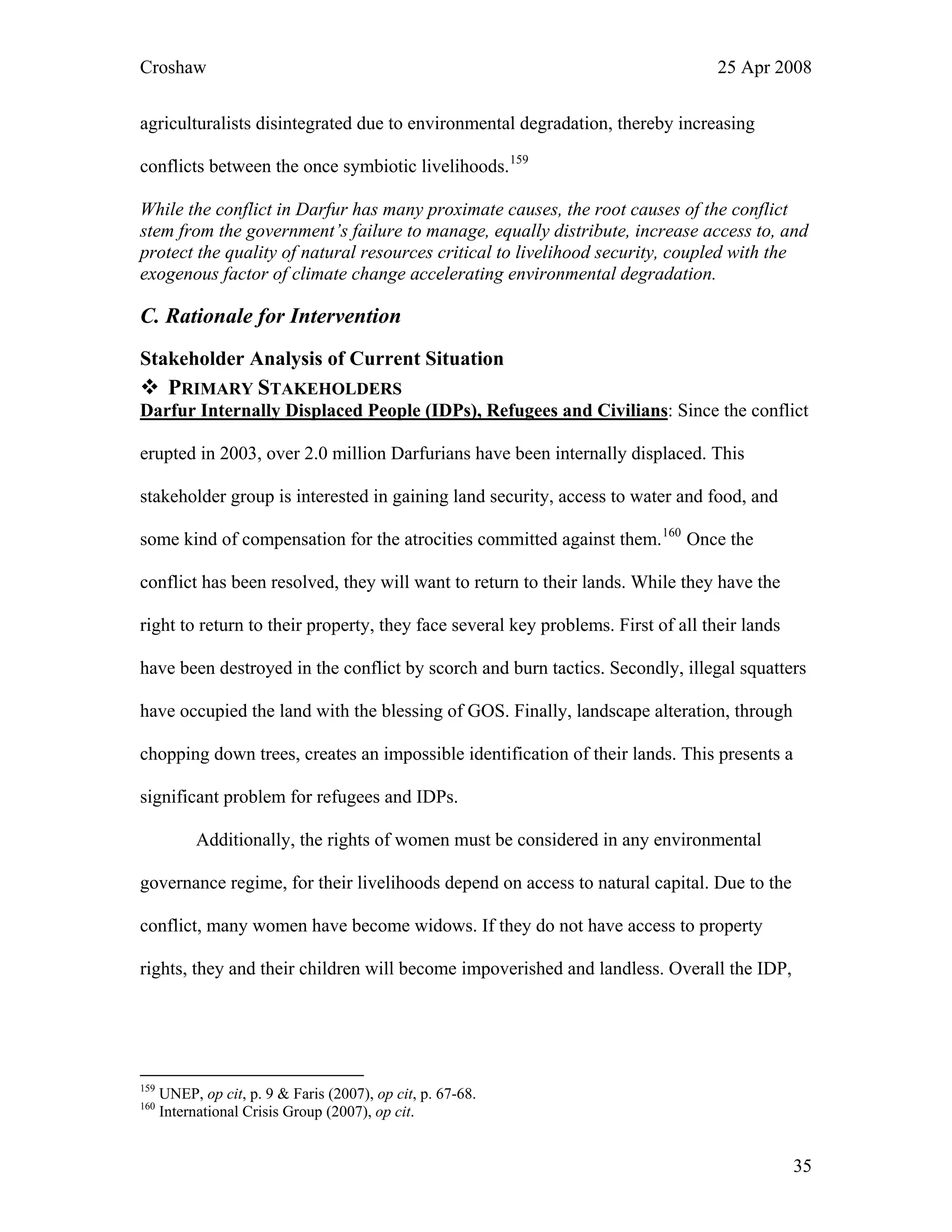

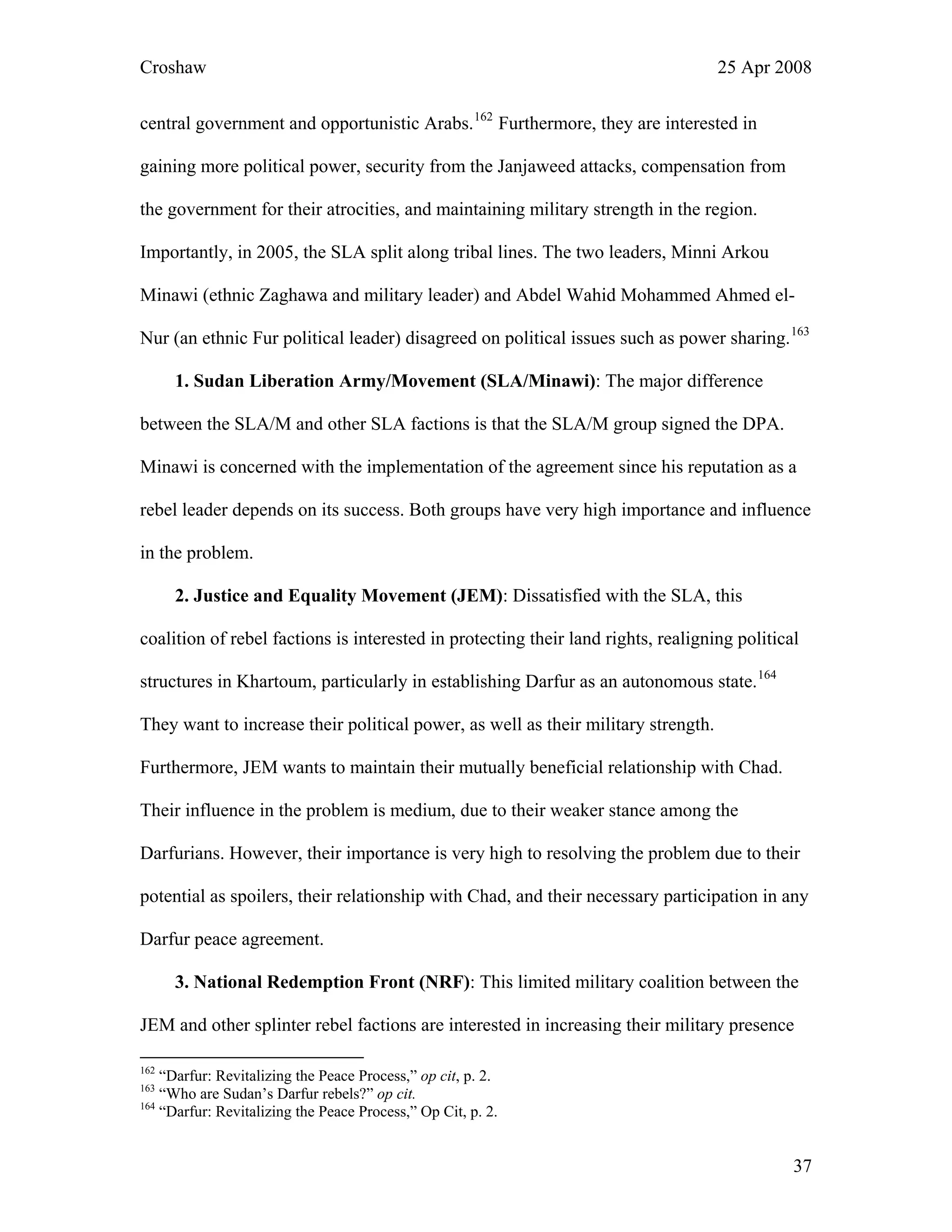
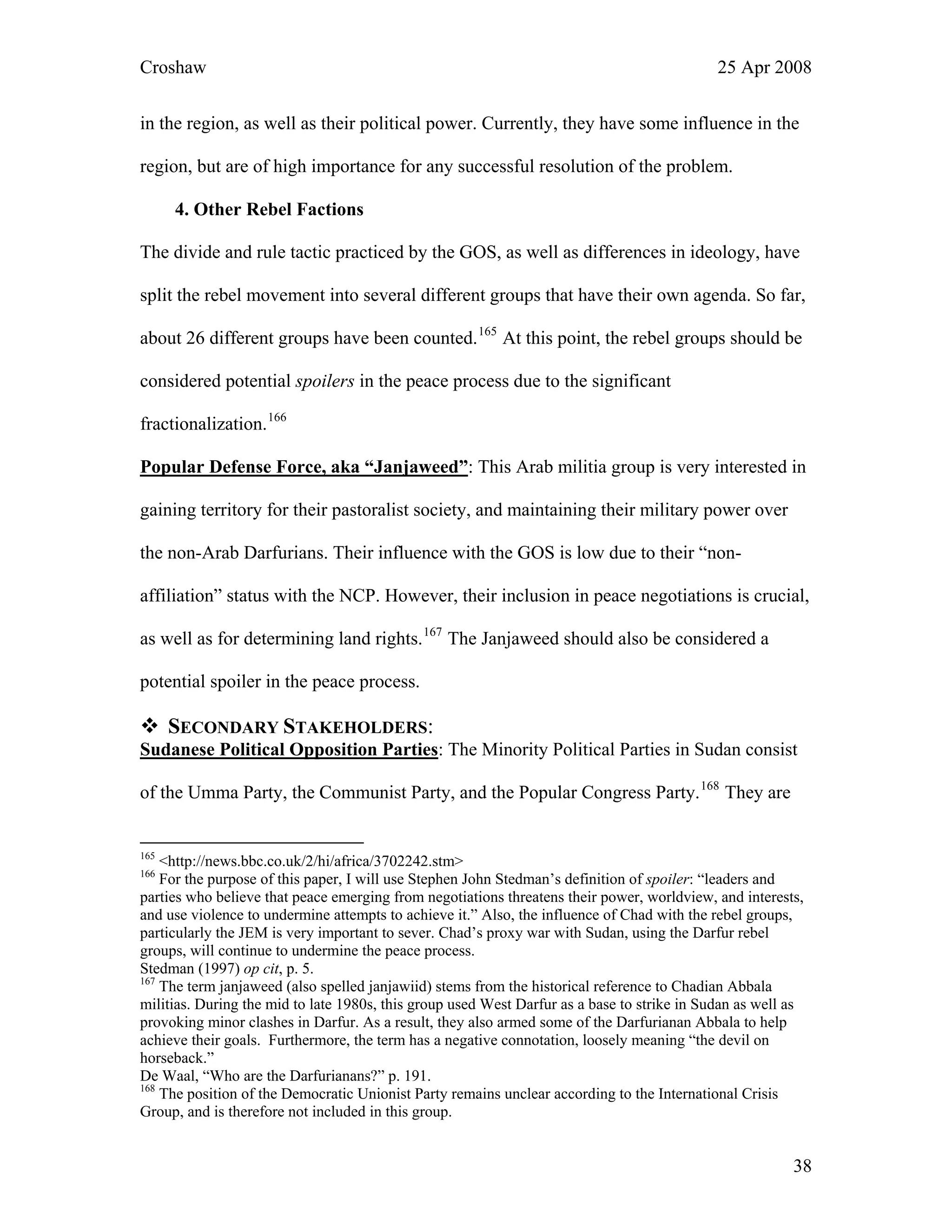
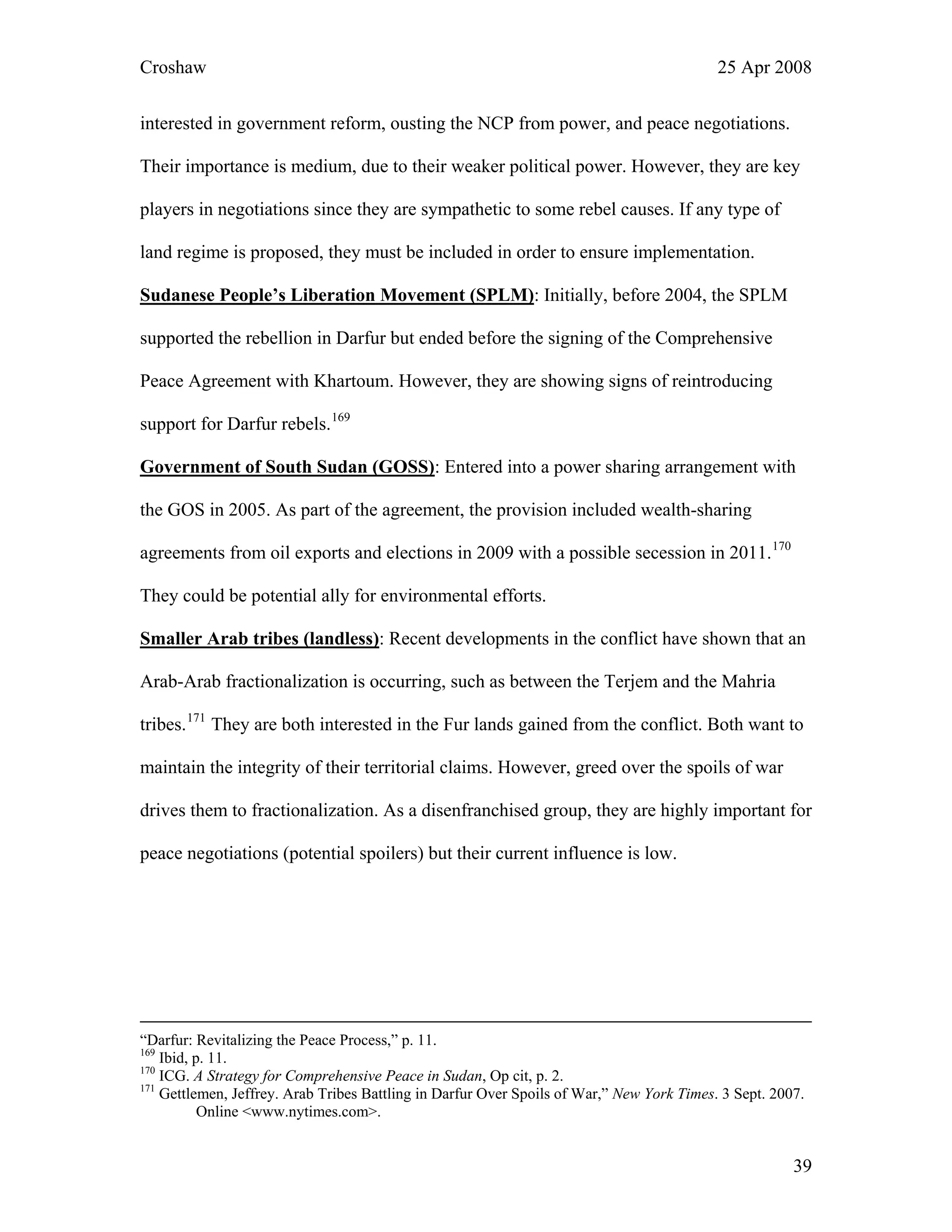
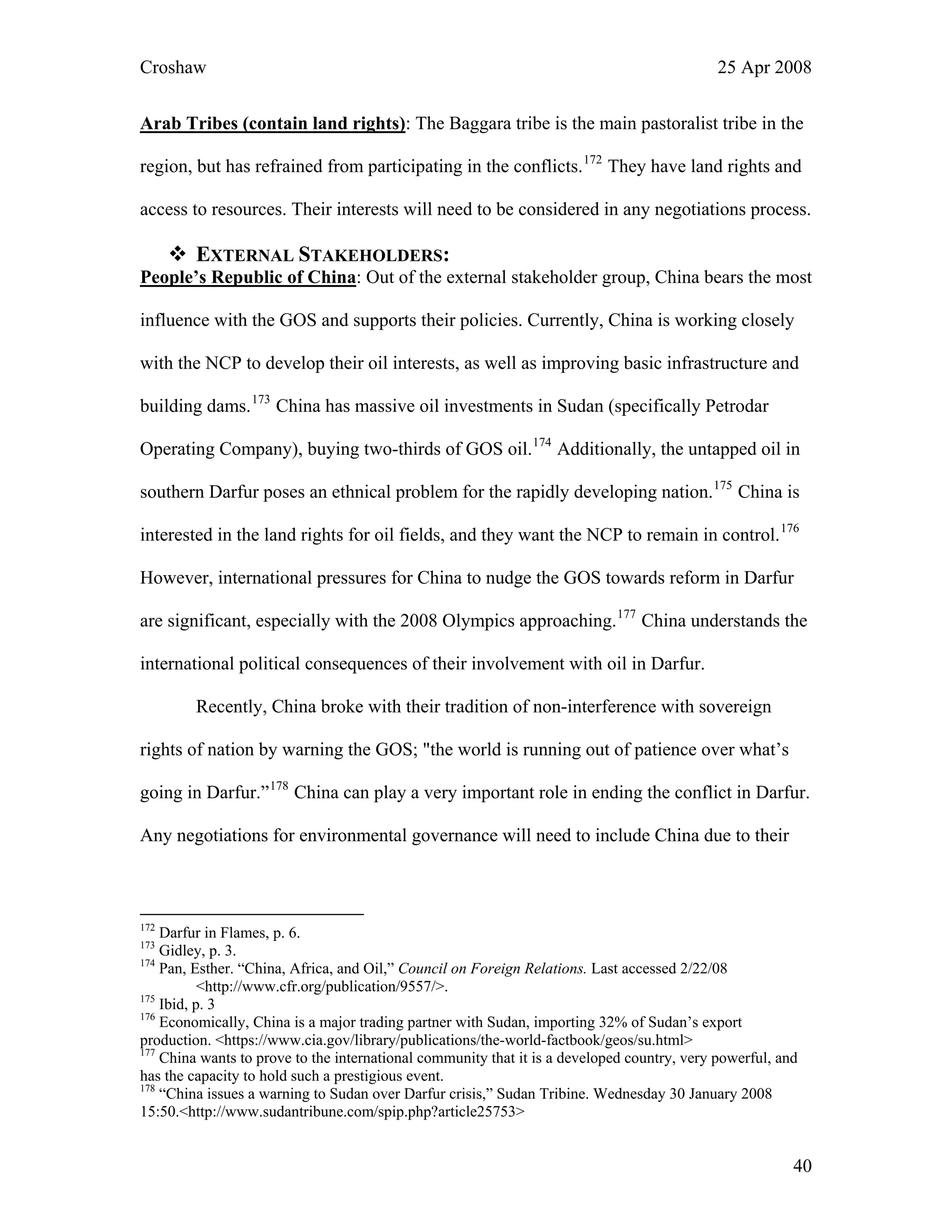
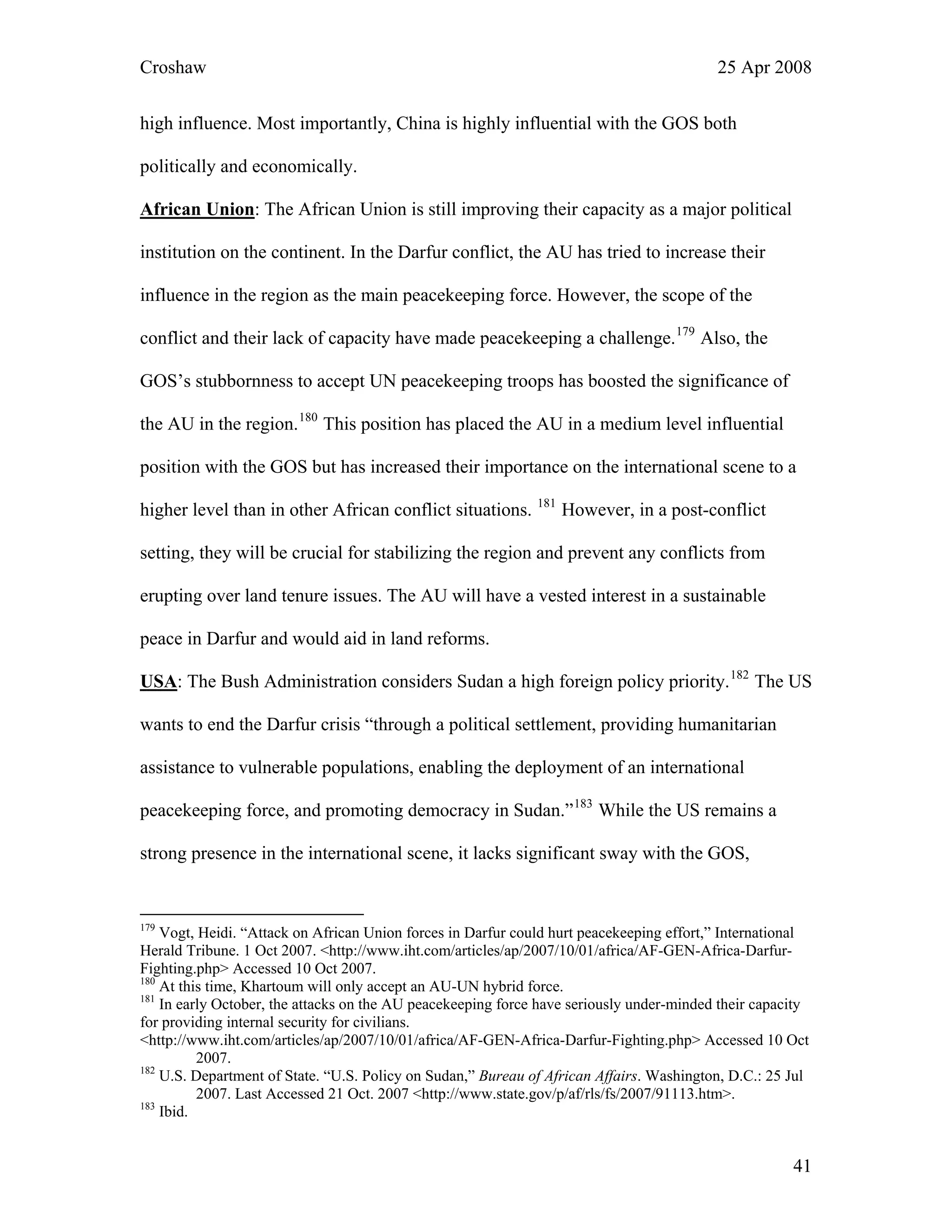
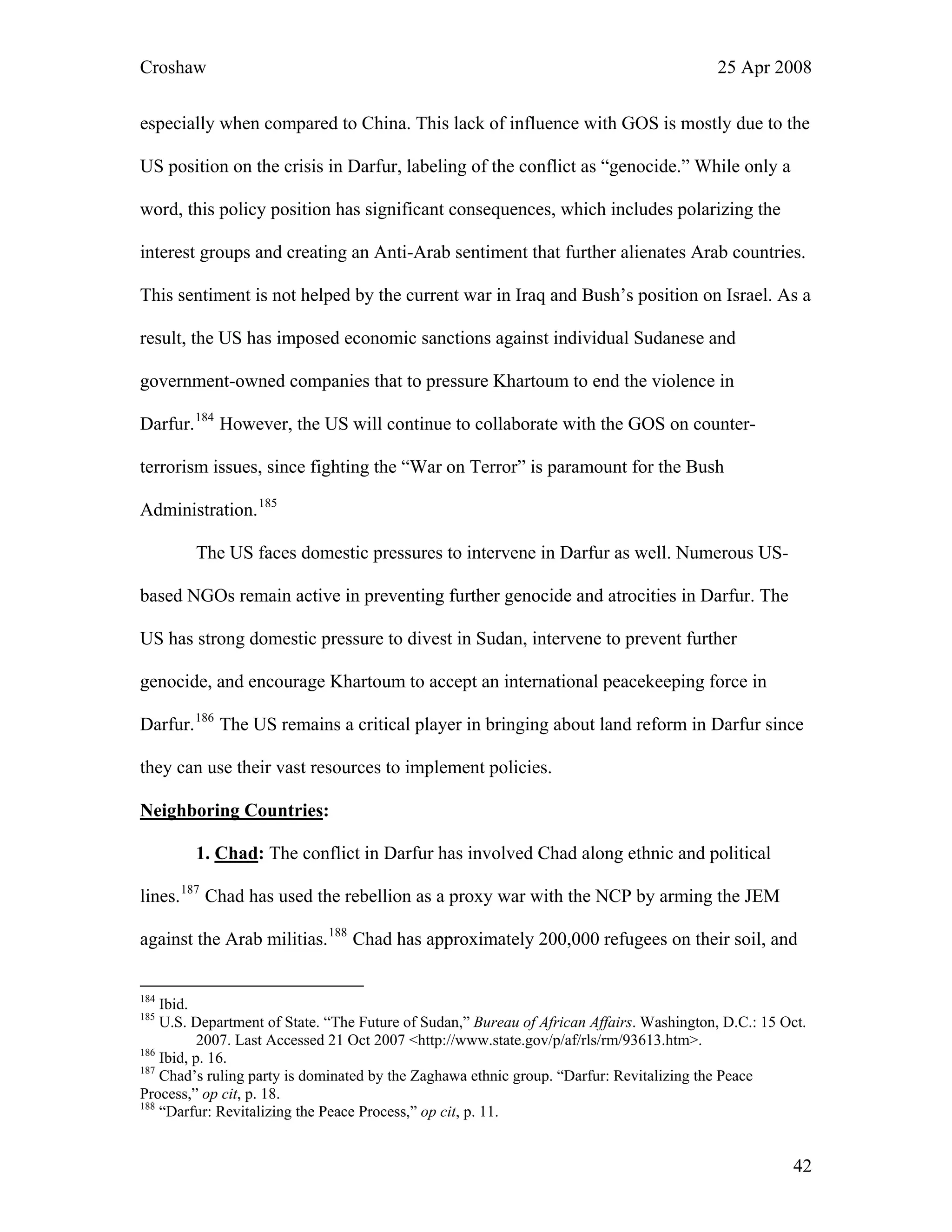

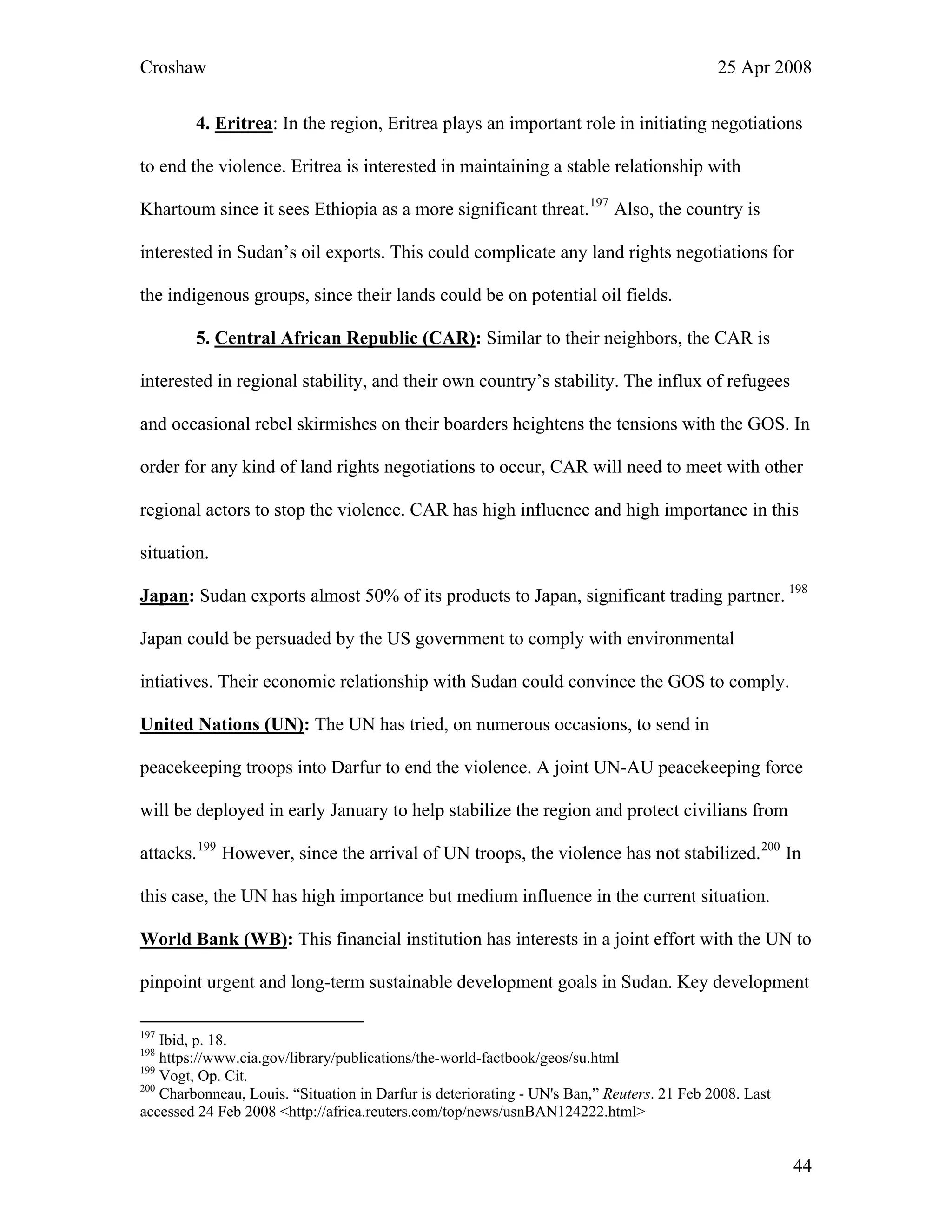
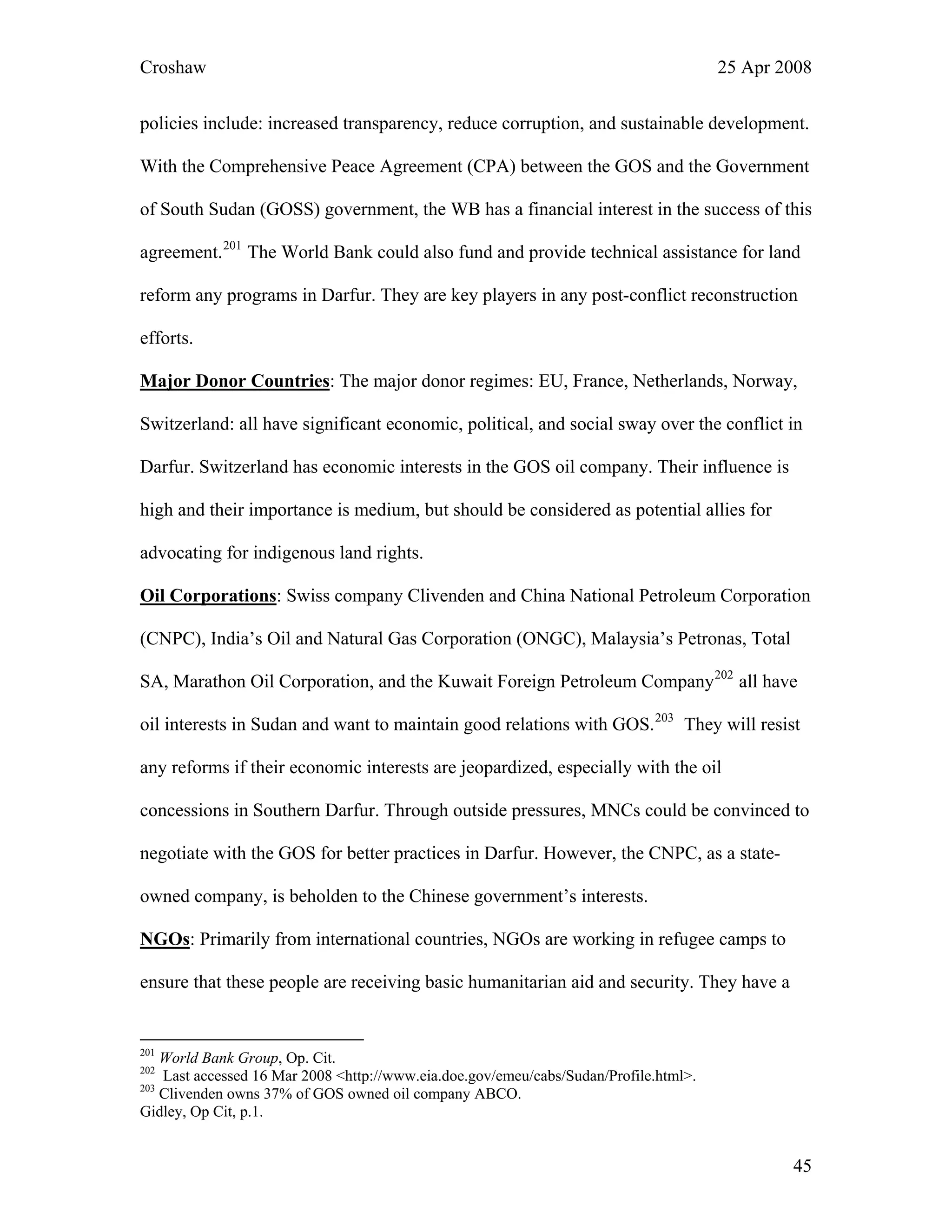
![Croshaw 25 Apr 2008
high interest in the welfare of the refugees, but have low influence with the GOS and
medium importance. They should not be disregarded from the negotiating tables, since
they have the capacity to aid and represent the refugees’ interests. Furthermore,
humanitarian organizations must be very careful with what information leaks to the
international community. They have to maintain a working relationship with the GOS
since they are there at their invitation. Without their presence in Darfur, the humanitarian
situation would quickly deteriorate.
Arab League: With the conflict, the Arab league has played a limited role in bringing
about peace. Sudan, as the gateway between North Africa and East Africa, has decided to
align themselves with the Arabs. As a result, the GOS wants to strengthen their
connection to the Arab league for political, social, economic, and ideological reasons. 204
The Arab League should not be isolated from the peace process. In particular, Saudi
Arabia, being another majority Sunni Muslim country and an import and export partner,
could have significant influence with Khartoum.205
[See Appendix: Conflict Mapping]
D. Problem Analysis
Environmental Causes of Conflict
Weak government institutions: Overall, the GOS suffers from a lack of capacity for
environmental governance due to weak institutions and corruption. Government
corruption and the breakdown of the Native Administration allowed (and even
encouraged) the breakdown of relations between the different ethnic groups in the
204
Johnson, p. 141
205
Tradeport. Sudan. Last Accessed 16 Mar 2008. <http://www.tradeport.org/countries/sudan/01grw.html>
46](https://image.slidesharecdn.com/9cf9284a-b20c-4b4a-b7ec-c17601a02e45-150317122303-conversion-gate01/75/MP_hrc4_a_200805-50-2048.jpg)

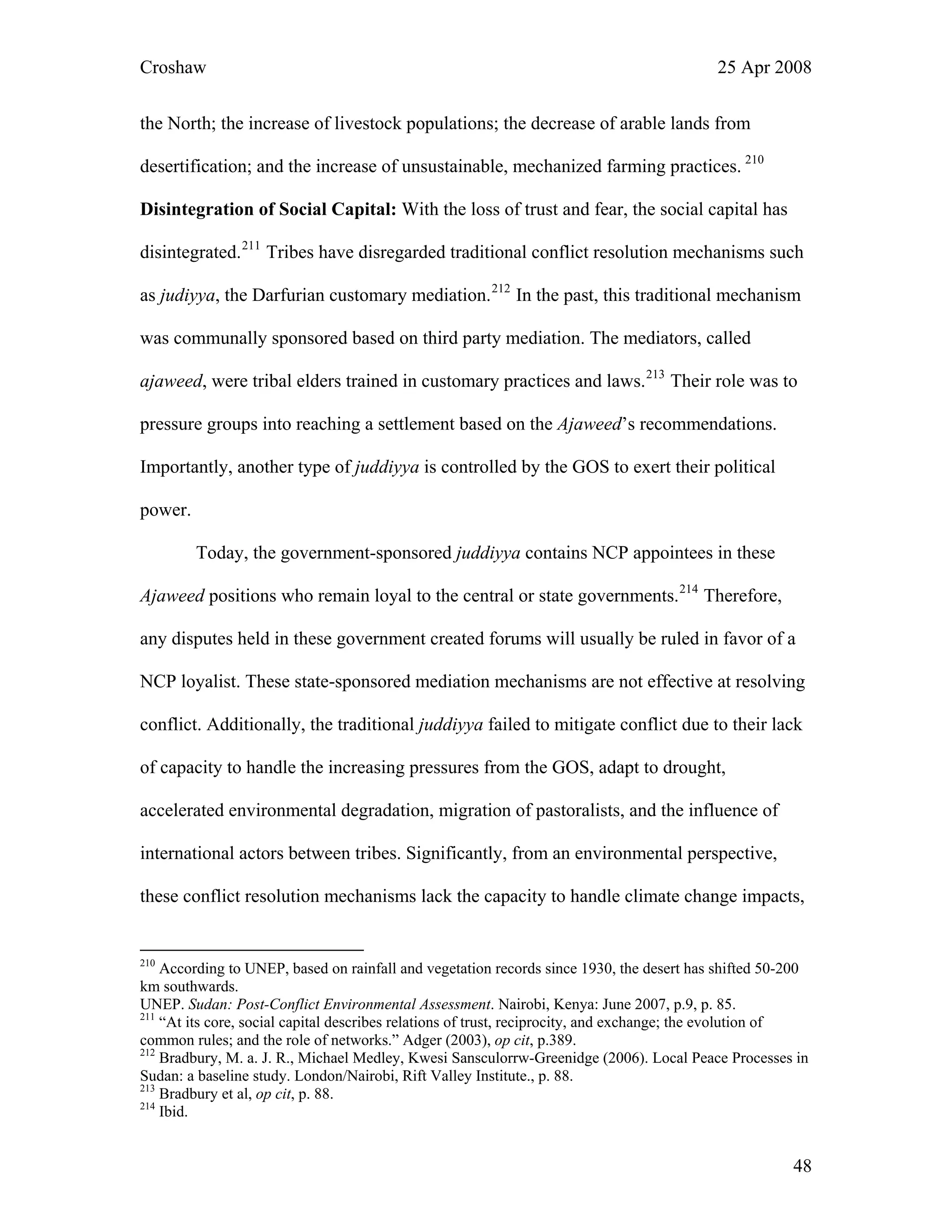
![Croshaw 25 Apr 2008
particularly droughts. Those closest to natural capital, particularly land and water, will be
most vulnerable. Without strong social capital to mitigate tensions, conflict will erupt as
it has in Darfur.
Resource Curse: On the national scale, the resource wealth situation, or “resource curse”
has contributed to the root causes of the conflict in Darfur by weakening the central
government regime due to rent seeking and state exploitation. Aspects of the oil
concession system still contribute to the tensions between the different stakeholders for
several reasons. The oil concession system is highly centralized and controlled by
Khartoum. Oil concession documents, called production-sharing agreements (PSA) are
not always publicly available either through the government or the corporation.
Generally, oil contracts propagate conflict due to their lack of transparency about which
companies are involved in the concessions, no disclosure of length of contracts, how to
allocate the revenues, and the impact on environmental and social arenas.215
Land Tenure Conflicts: Additionally, weak institutions perpetuate environmental-based
conflicts due to the inability to define property rights of lands. When the state fails to
define property rights, the unclear boundaries lead to increased tensions. Conflicts can
arise over differences between types of property rights between the state and the
indigenous groups, and even what it means to “own” land.
As a result, Darfur suffers from the resource capture of valuable arable land by
political elites based in the capital, Khartoum and their Arab allies.216
“…[E]xclusionary
states, state elites and their allies have both the power and the incentive to exploit
215
Shankleman, op cit, p. 29
216
Additionally, weak political institutions perpetuate environmental based conflicts due to the inability to
define property rights of lands. When the state fails to define property rights, the unclear boundaries lead
to increased tensions. Conflicts can arise over differences between types of property rights between the
state and the indigenous groups, and even what it means to “own” land.
49](https://image.slidesharecdn.com/9cf9284a-b20c-4b4a-b7ec-c17601a02e45-150317122303-conversion-gate01/75/MP_hrc4_a_200805-53-2048.jpg)
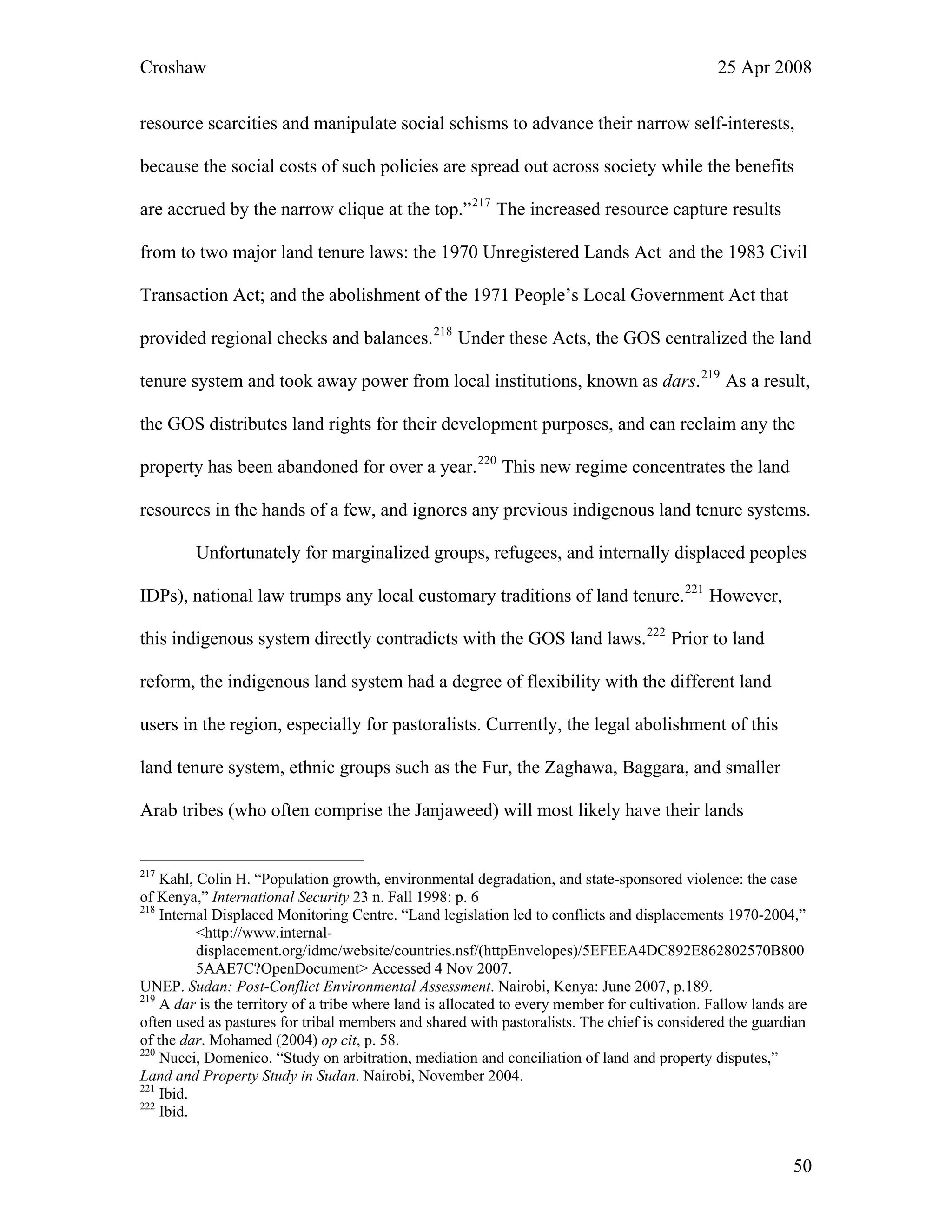
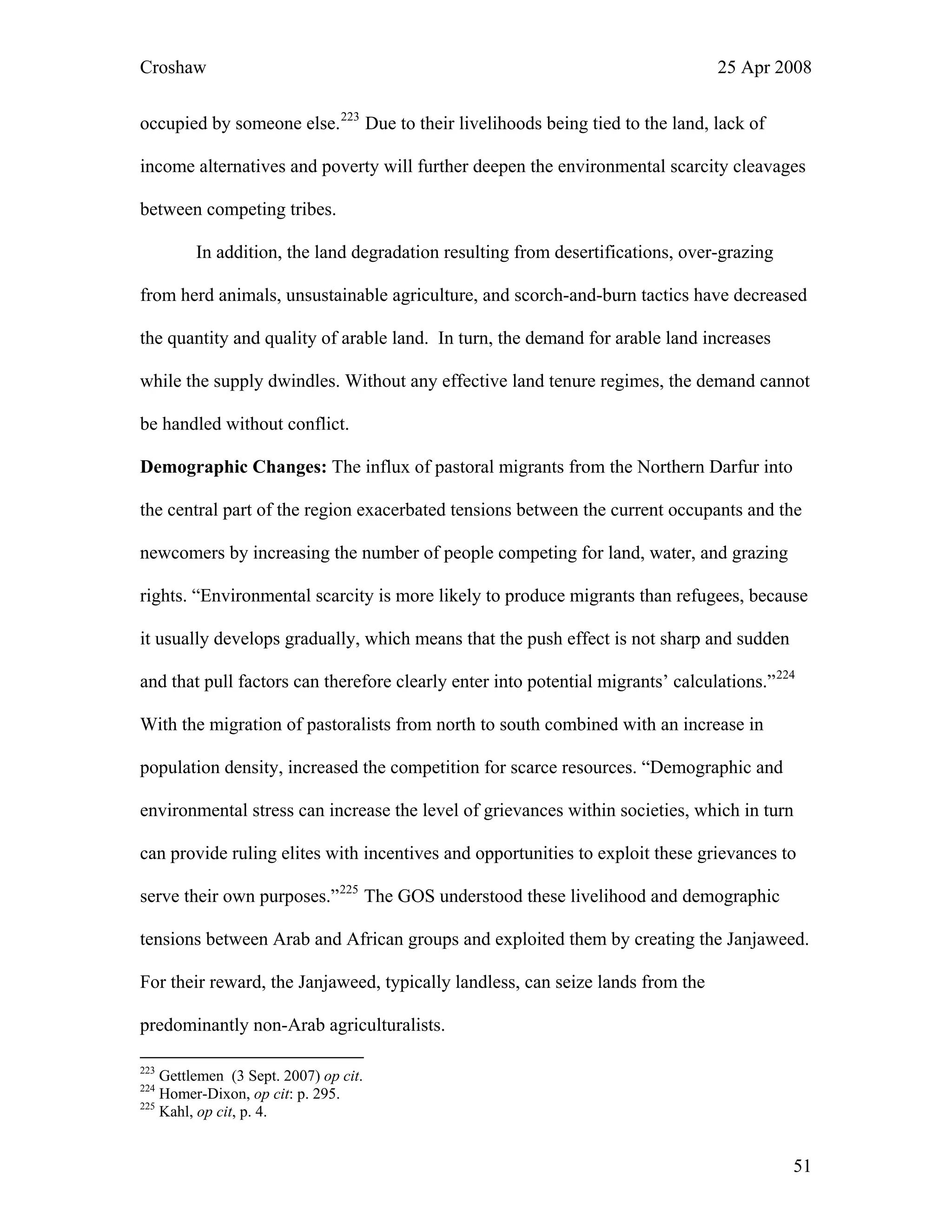
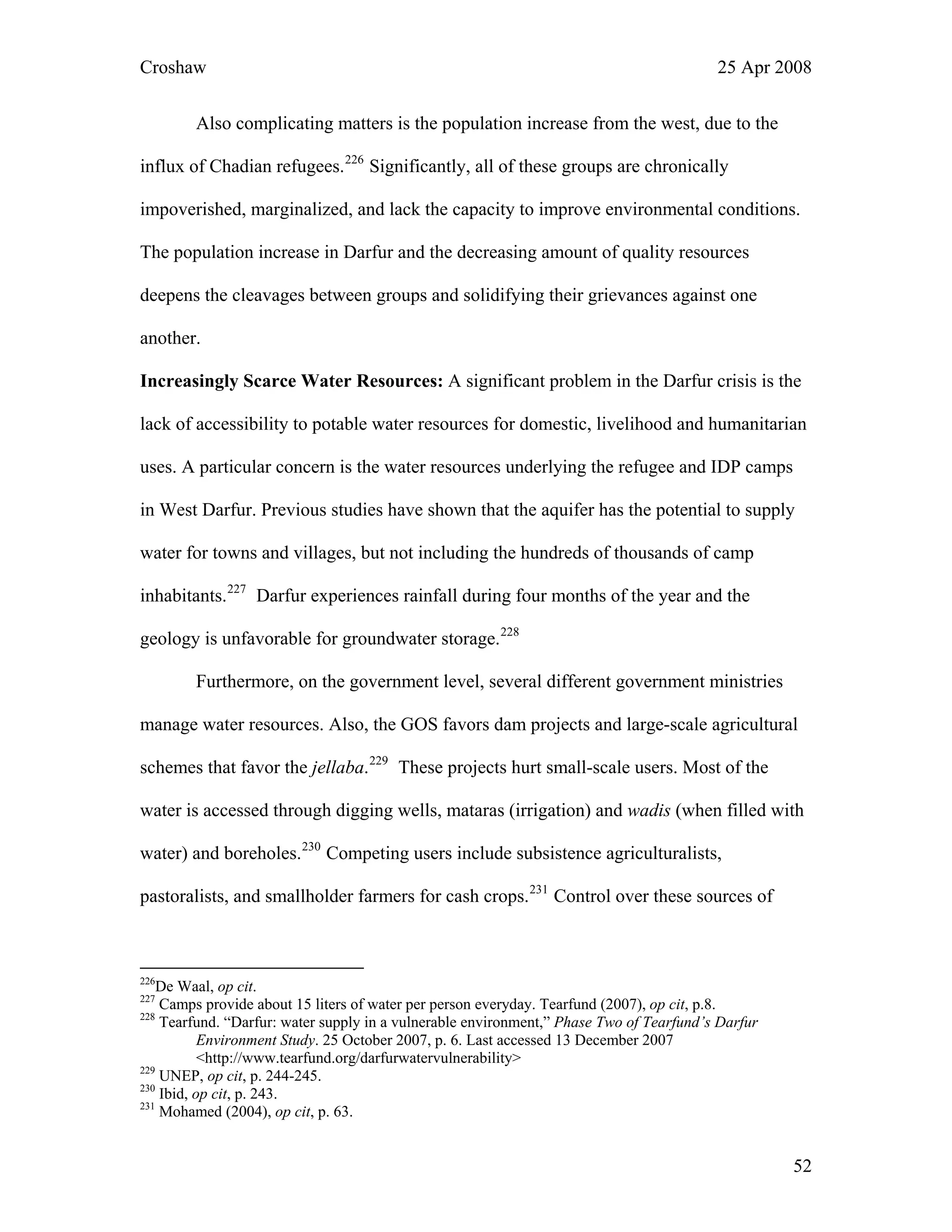
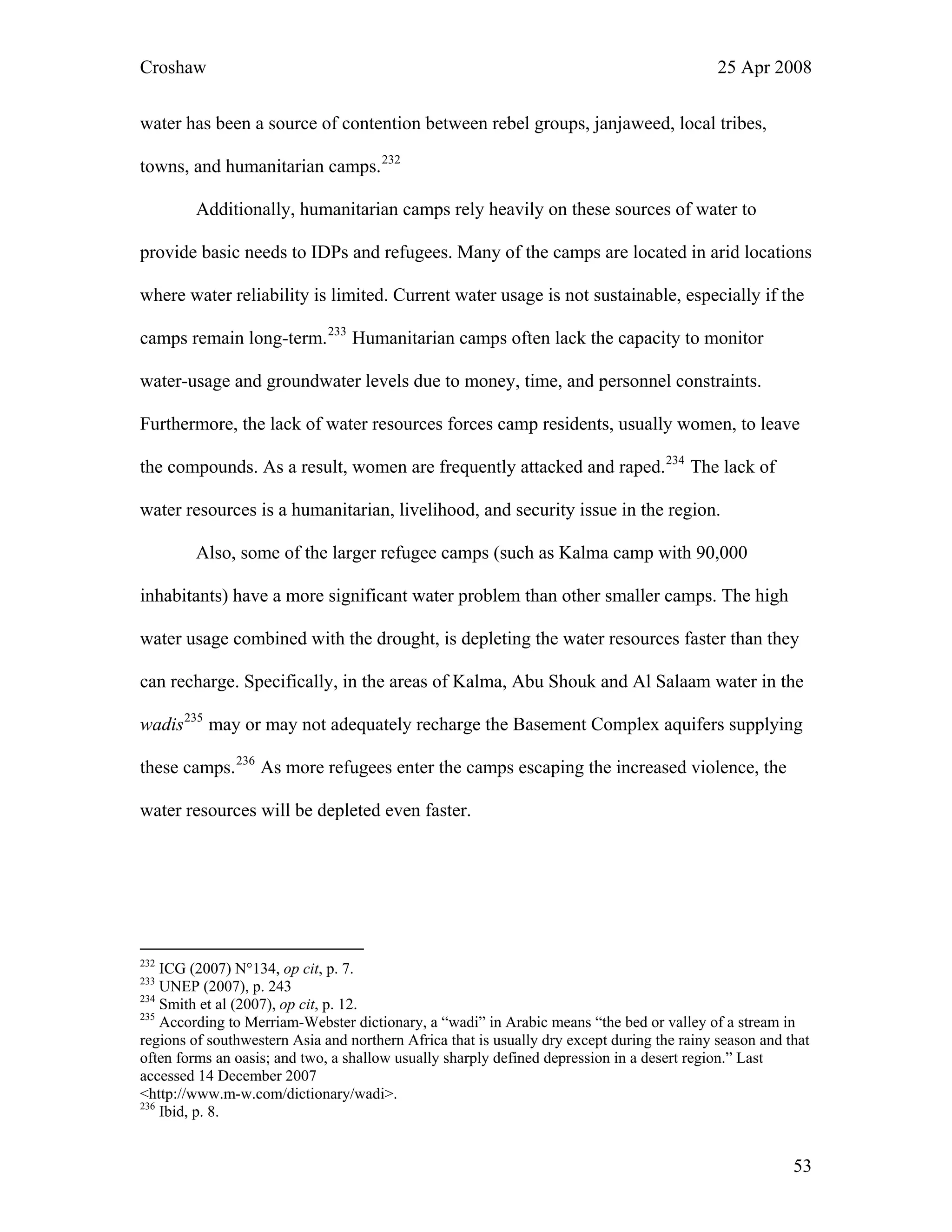
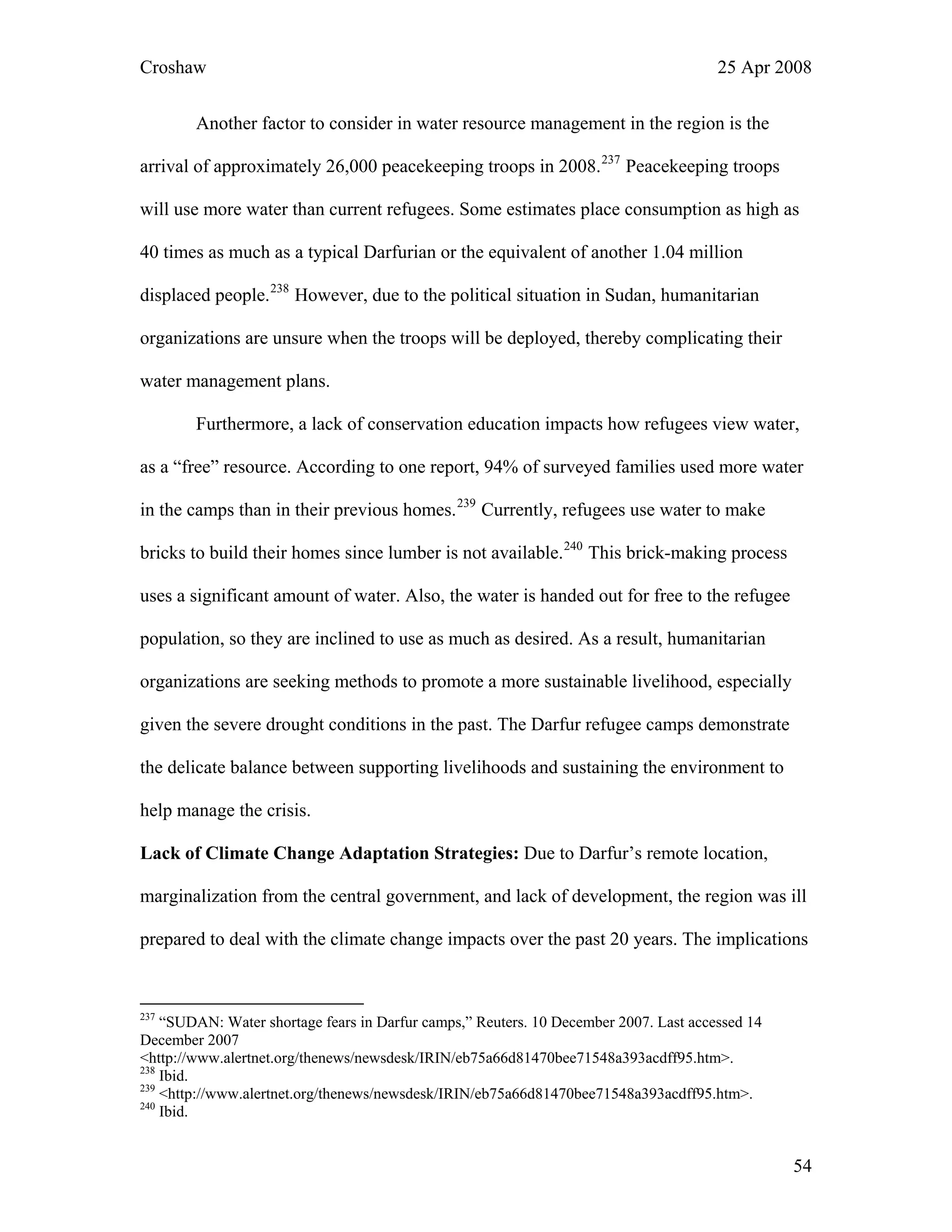
![Croshaw 25 Apr 2008
were seen was early as the 1980s. Social scientist Dr. Alex de Waal met with an Arab
sheikh, Hilal Abdalla, who described the breakdown of relations between pastoralists and
farmers due to the drought and decreased supply of arable land.241
“Farmers who had
once hosted his tribe and his camels were now blocking their migration; the land could no
longer support both herder and farmer.”242
By blocking the migration of pastoralists,
many of them lost their stock and turned to farming on marginal lands. In past climate
cycles, these tribes were able to adapt their practices to the environmental conditions.
However, in the 21st
century, the presence of international actors, the GOS, globalization,
arms trade, and market forces discourages the use of traditional livelihood practices to
cope with climate variations. “…[I]n future environmental security research will have to
conceptualize its research agenda in awareness of the potential disruptions of climate
change and myriad other ecological factors in an increasingly artificial global
‘environment.’”243
As a result, the climate change factor decreased the feeling of human
security for both the agricultural and pastoralist tribes, creating cleavages. Climate
change will continue to alter the landscape, water availability, and traditional
relationships across Darfur. Unfortunately, climate change will hit the poorest hardest as
it had in Darfur.
E. Cooperation and Conflict Resolution
Attempts for Reform for Climate Change Adaptation
Challenges
Due to the scope and complexity of the conflict in Darfur, finding methods for
peace building will be challenging. On the national level, the limited capacity of the
241
Faris, op cit, p. 63.
242
Faris, op cit, p. 63.
243
Dalby, Op Cit: p. 14
55](https://image.slidesharecdn.com/9cf9284a-b20c-4b4a-b7ec-c17601a02e45-150317122303-conversion-gate01/75/MP_hrc4_a_200805-59-2048.jpg)
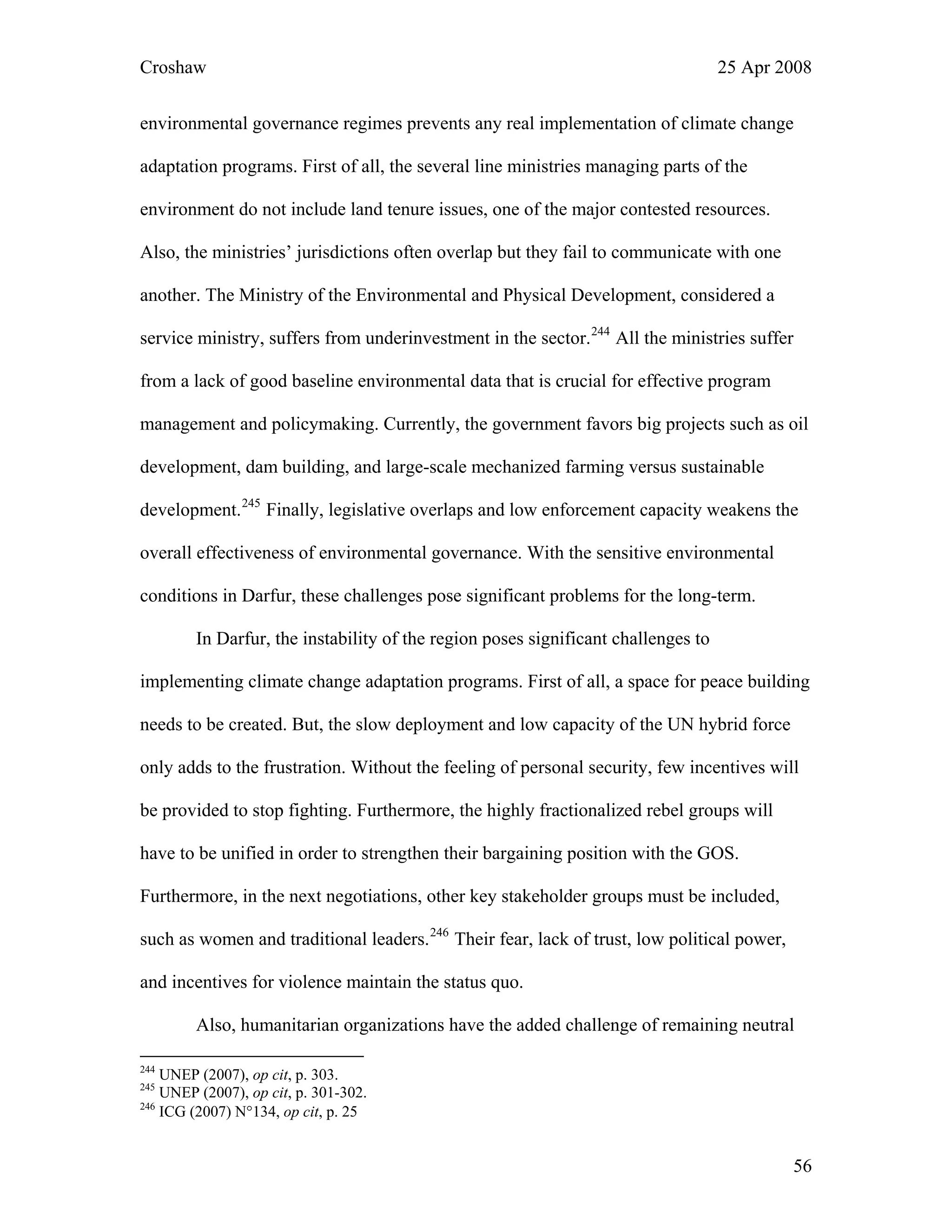
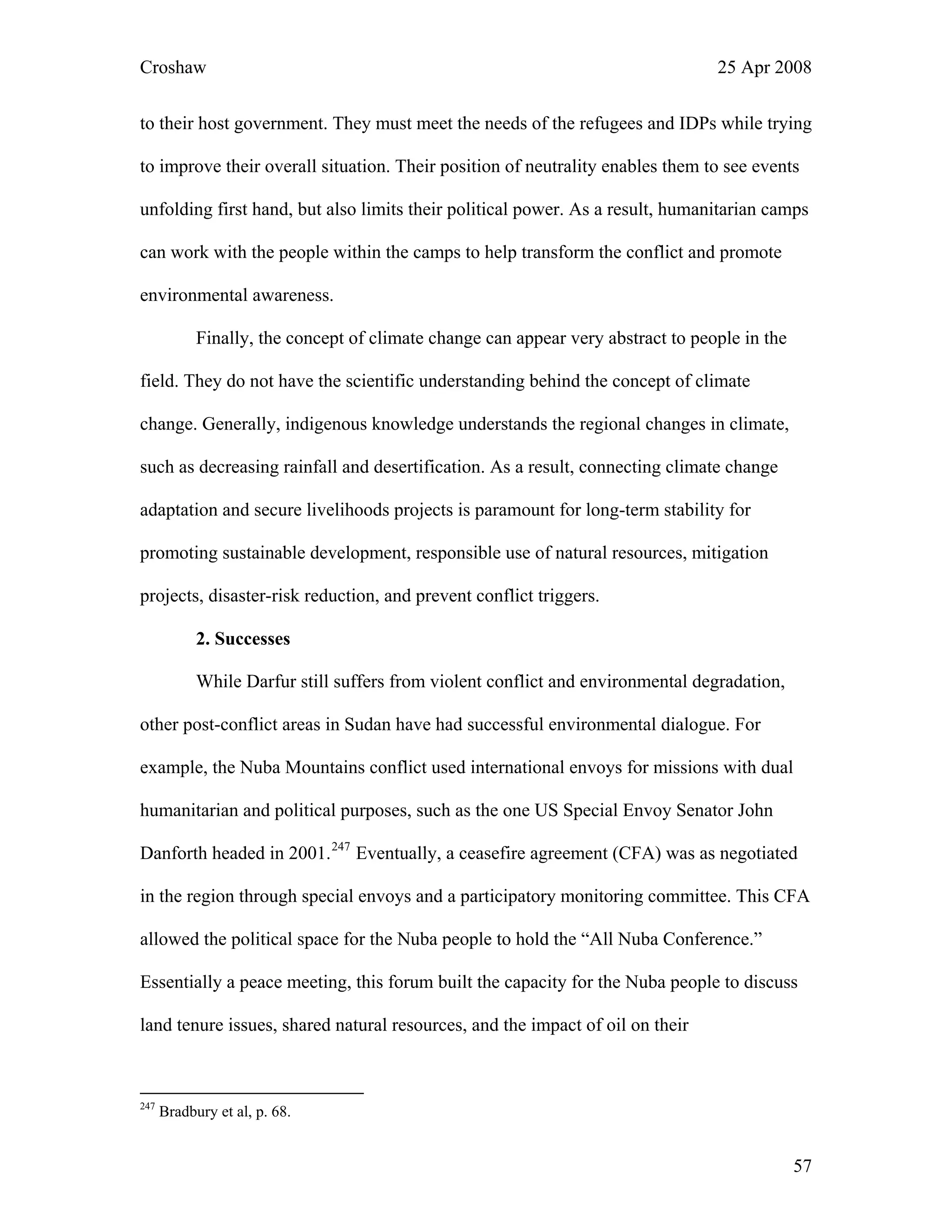
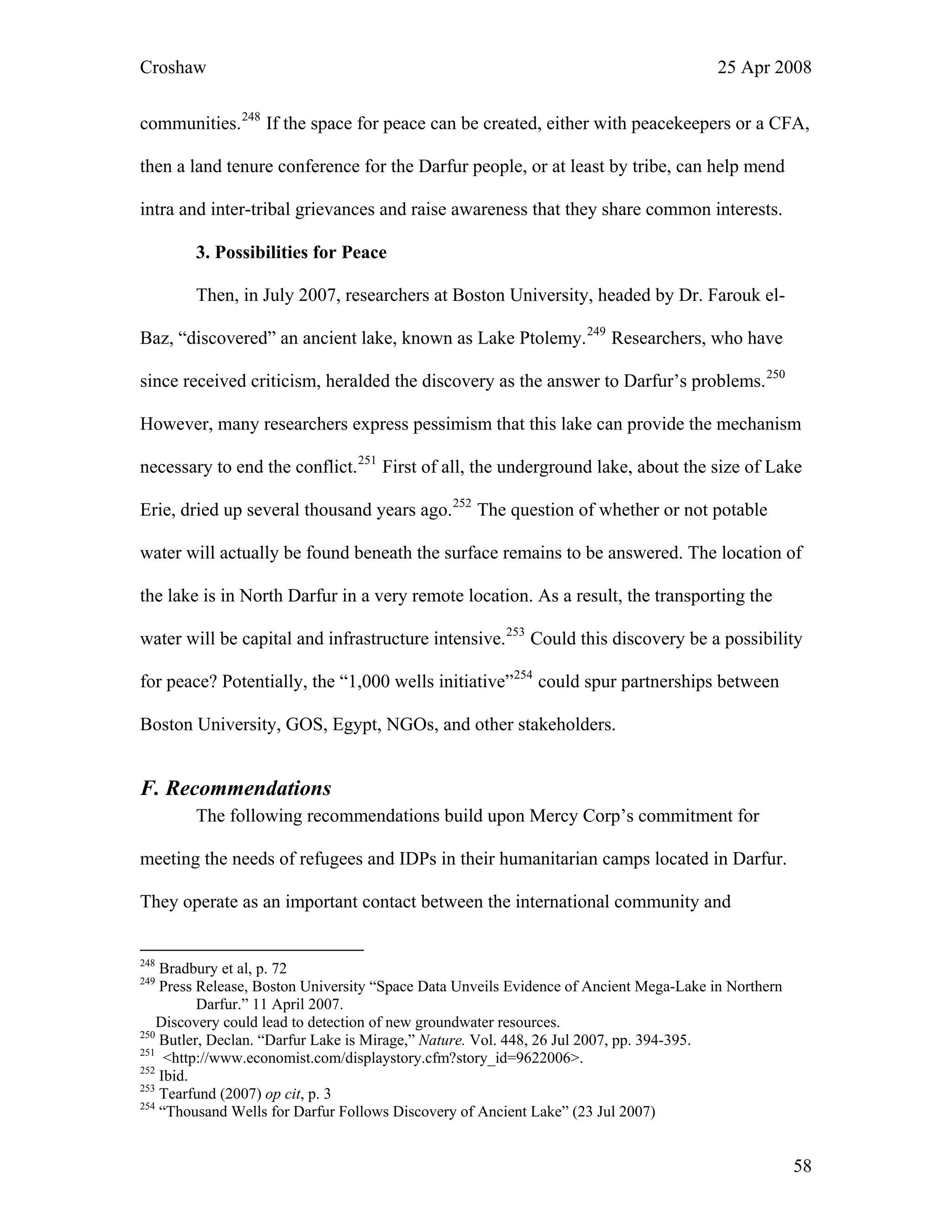
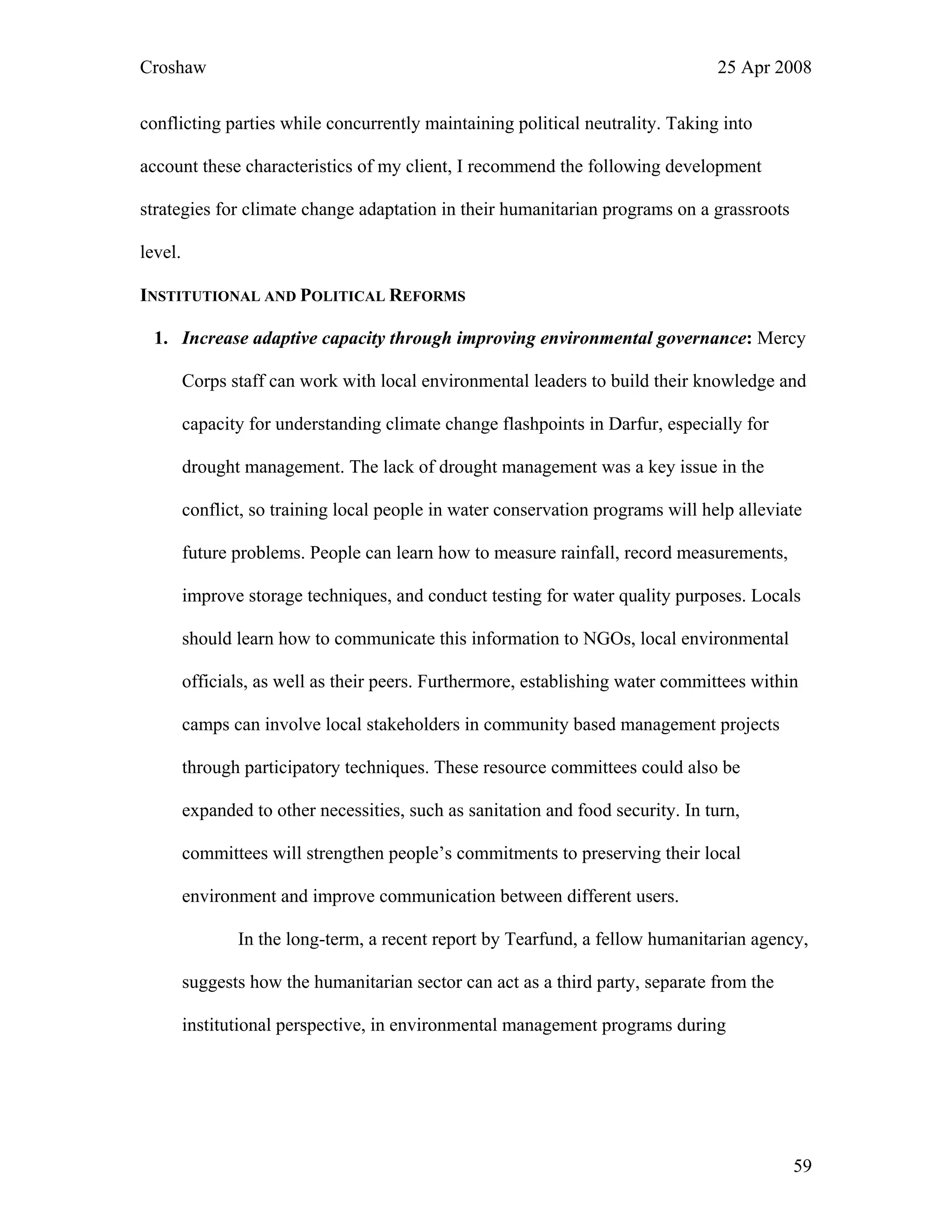
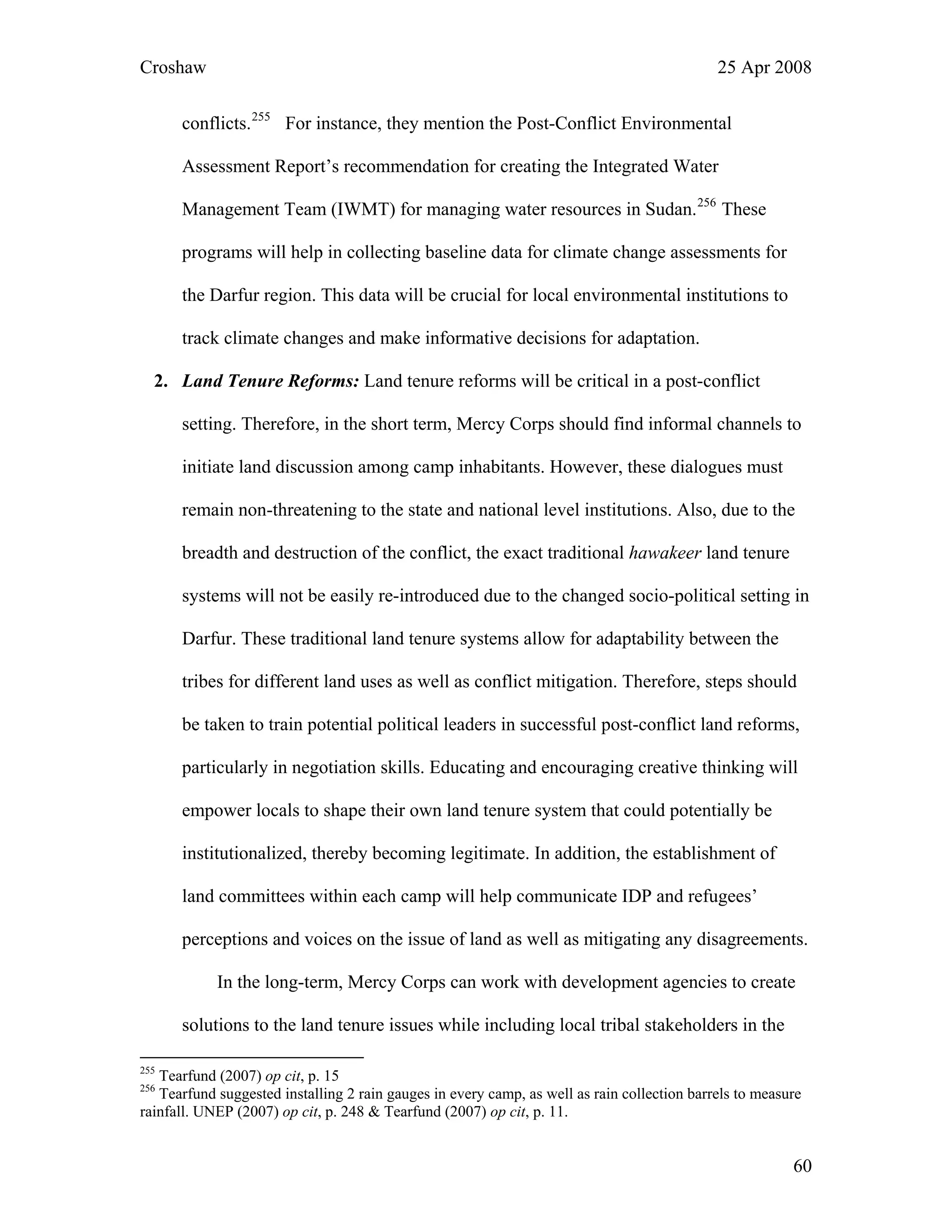


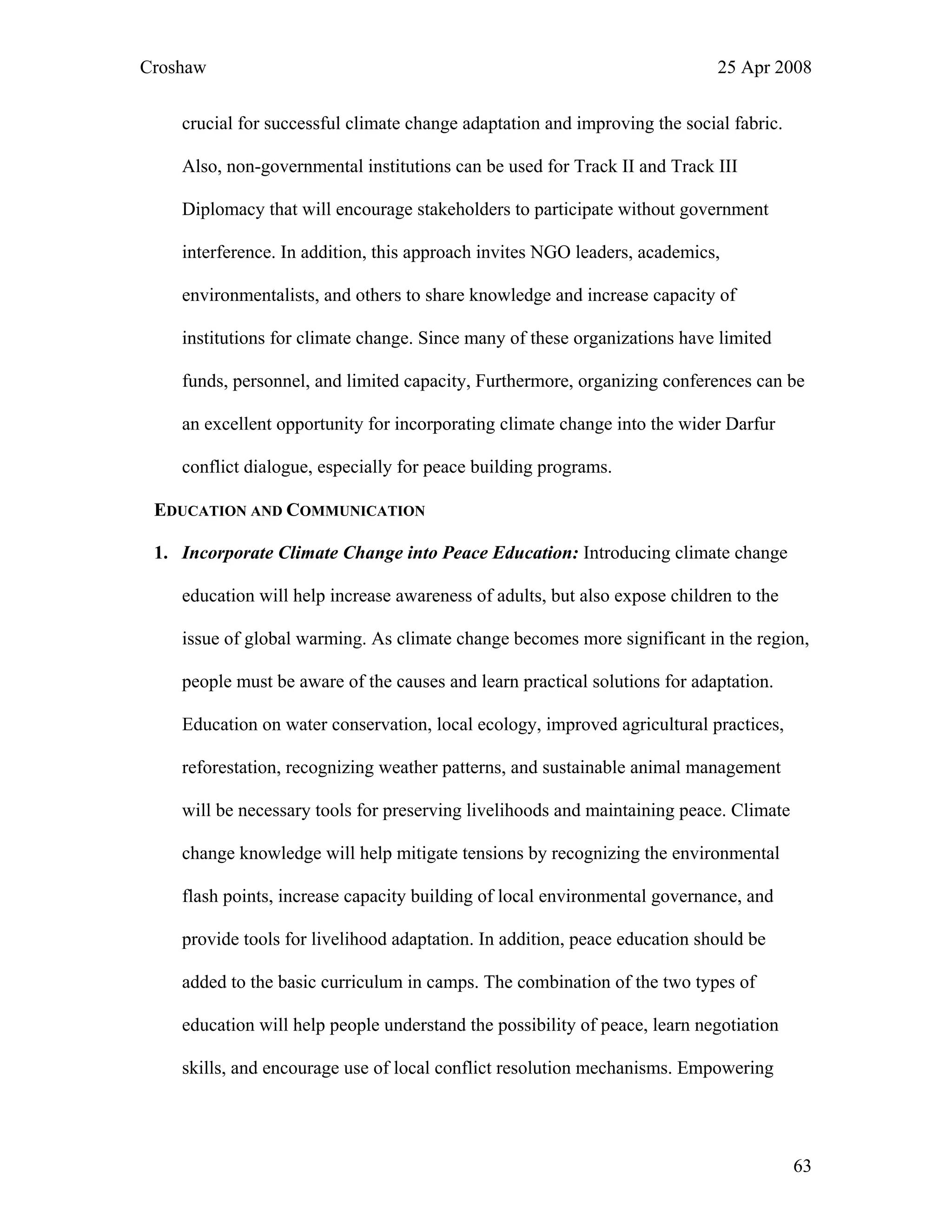
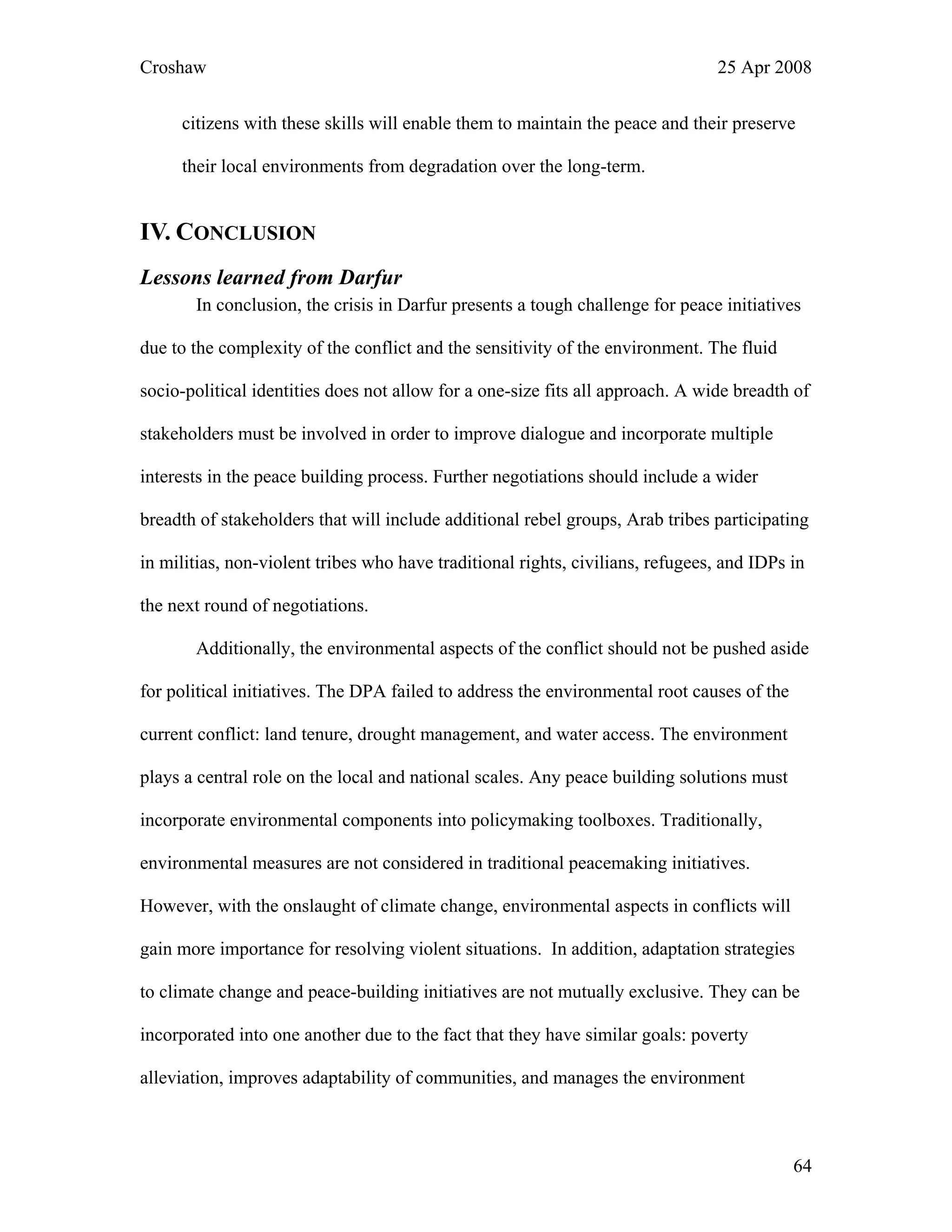
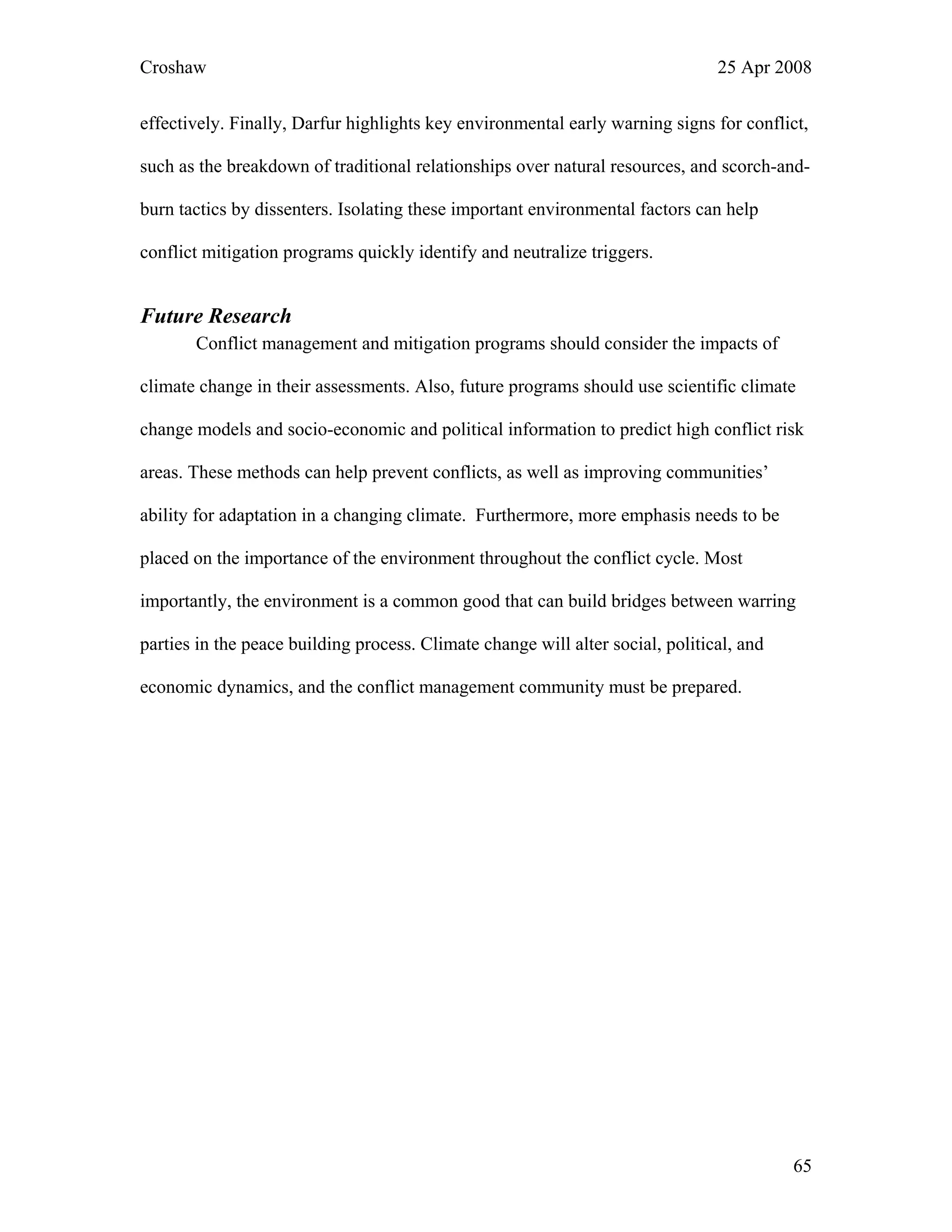
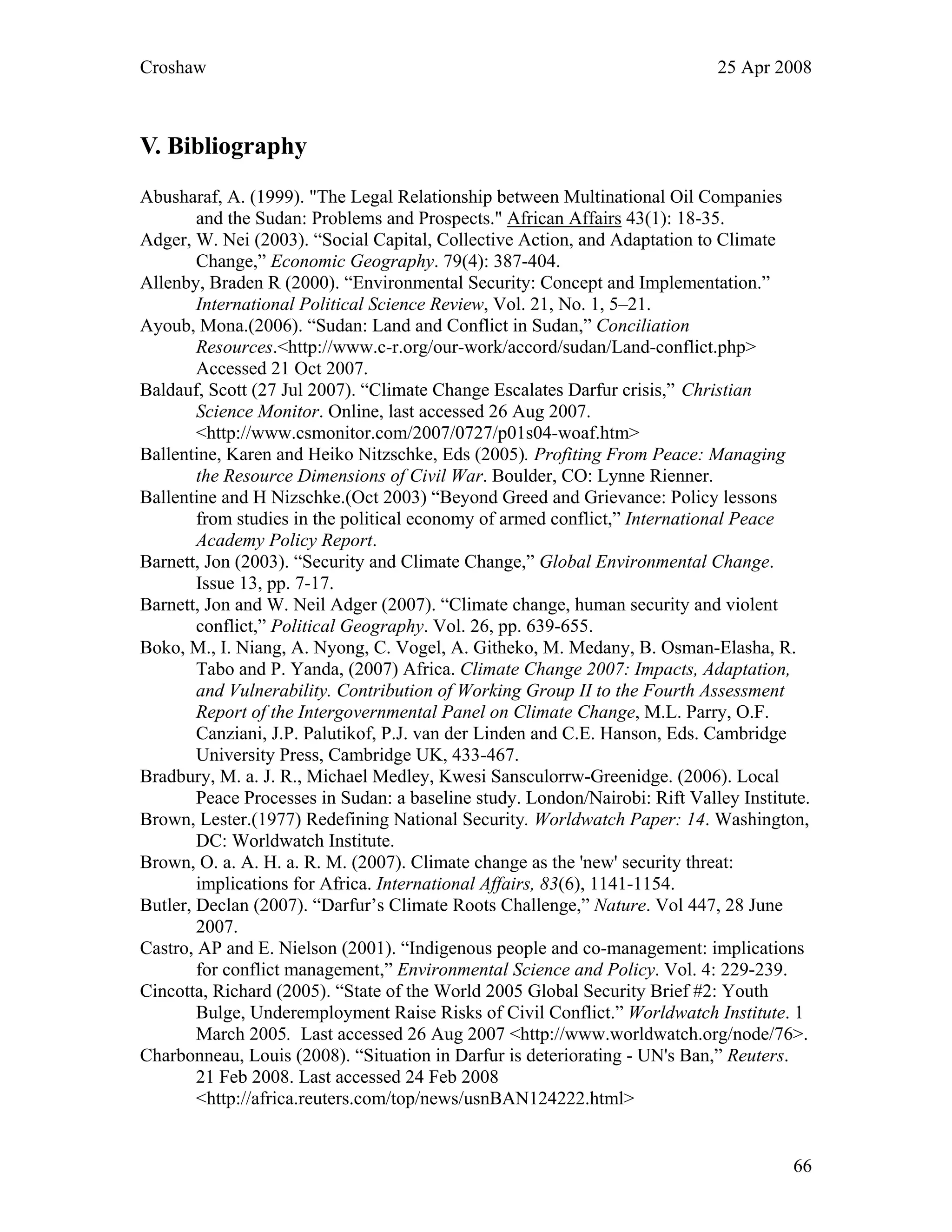
![Croshaw 25 Apr 2008
Clover, Jenny. (2005). “Human centered environmental security: The link between
environmental care and the creation of a more secure society,” African Security
Review Vol 14 No 2, pp. 77-112.
Collier, Paul (2003). “Natural Resources, Development and Conflict: Channels of
Causation and Policy Interventions,” Working Paper for Oxford University and
the World Bank. 28 April 2003.
Collier, Paul and Anke Hoeffler (2004). “Greed and Grievance in Civil War,” Oxford
Economic Papers 56: pp. 563-95.
Collier, Paul and Nicholas Sambanis (2005). Understanding Civil War: Vol 1: Africa.
The International Bank for Reconstruction and Development/The World Bank:
Washington, DC.
Daly, M.W (2007). Darfur’s Sorrow: A History of Destruction and Genocide. Cambridge
University Press: New York.
De Waal, A. (2005). Who are the Darfurians? Arab and African Identities, Violence and
External Engagement. African Affairs, 104(415), 181-205.
De Waal, A. (2006). “The Question of Land,” All Africa. Posted to the web14 Jul 2006.
<http://allafrica.com/stories/200607140762.html> Accessed 10 Oct 2007
Dimitrov, Radoslav S (2002). “Water, Conflict, and Security: A Conceptual Minefield.”
Society and Natural Resources. 15: 677-691.
Fadul, A. A. (2004). Natural Resources Management for Sustainable Peace in Darfur.
Paper presented at the Environmental Degradation as a Cause of Conflict in
Darfur, Khartoum, Sudan.
Falk, Richard. This Endangered Planet: Prospects and Proposals for Human Survival.
Random House, New York: 1971
Faris, Stephen. (April 2007). “The real roots of Darfur: the violence in Darfur is usually
attributed to ethnic hatred. But global warming may be primarily to blame,” The
Atlantic Monthly. 299.3: p. 63(3). Academic Onefile. Gale. Duke University
Library- Perkins. 1 Feb 2008
<http://find.galegroup.com/itx/start.do?prodId=AONE>.
Fisher, Simon, and et al. (2000). Working with Conflict: Skills and Strategies for Action.
London: Zed Books.
Gettlemen, Jeffrey (3 Sept. 2007). “Arab Tribes Battling in Darfur Over Spoils of War,”
New York Times. Online. Last accessed 16 Sept. 2007 <
http://www.nytimes.com/2007/09/03/world/africa/03cnd-
darfur.html?_r=1&pagewanted=print&oref=slogin >.
Gidley, Ruth (15 Jun 2005). “Oil Discovery adds new twist to Darfur tragedy,” Reuters.
Lexis Nexis. Duke University. 27 Aug 2007.
Gleditch, Nils Petter (2007) Environmental Change, Security and Conflict, in: Crocker,
Chester et al, and Eds. Leashing the Dogs of War: Conflict Management in a
Divided World. United States Institute of Peace Press: pp.177-196.
Goodman, P. S. (2004). China Invests Heavily In Sudan's Oil Industry: Beijing Supplies
Arms Used on Villagers [Electronic Version]. The Washington Post, A01.
Retrieved 24 Apr 2008, from <http://www.washingtonpost.com/wp-
dyn/articles/A21143-2004Dec22.html>
67](https://image.slidesharecdn.com/9cf9284a-b20c-4b4a-b7ec-c17601a02e45-150317122303-conversion-gate01/75/MP_hrc4_a_200805-71-2048.jpg)
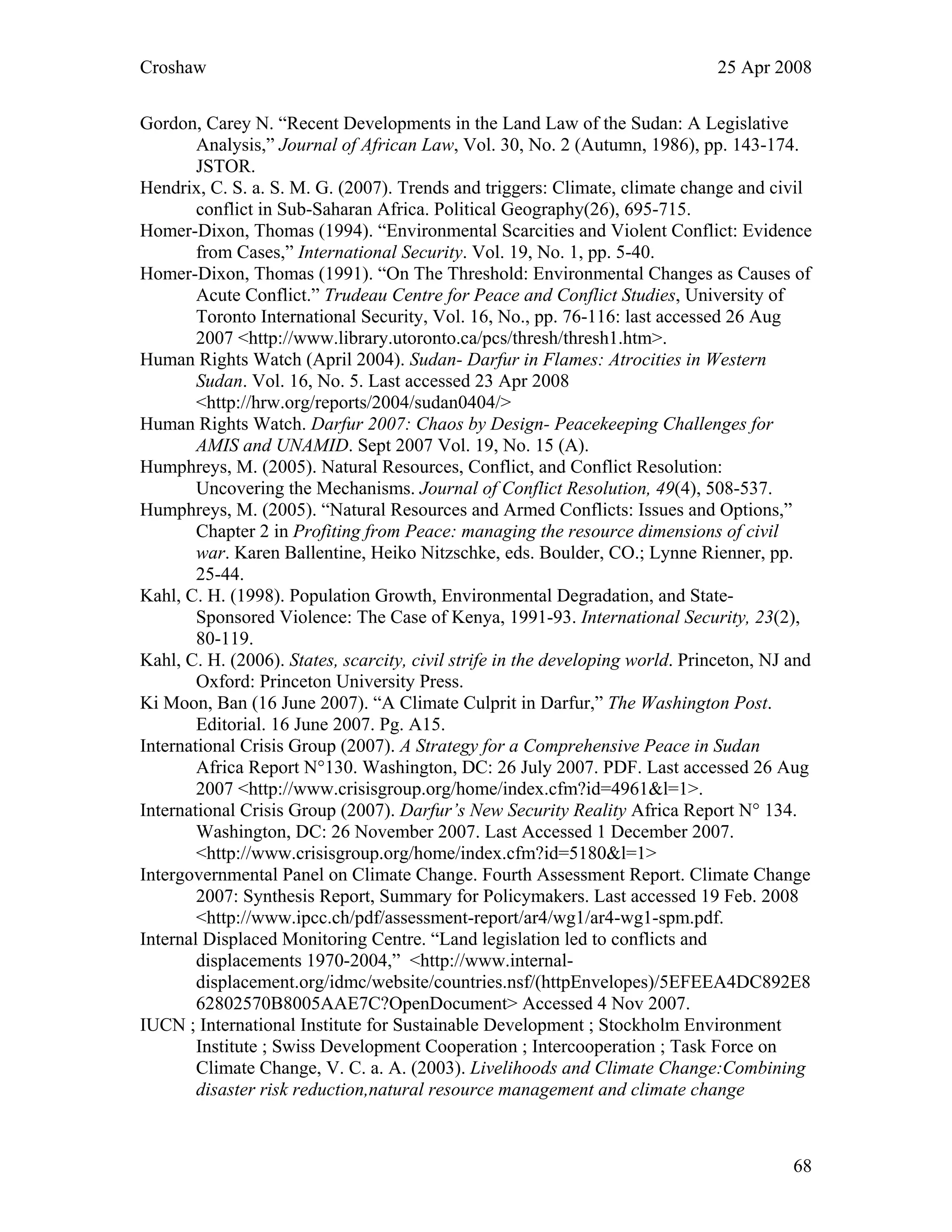

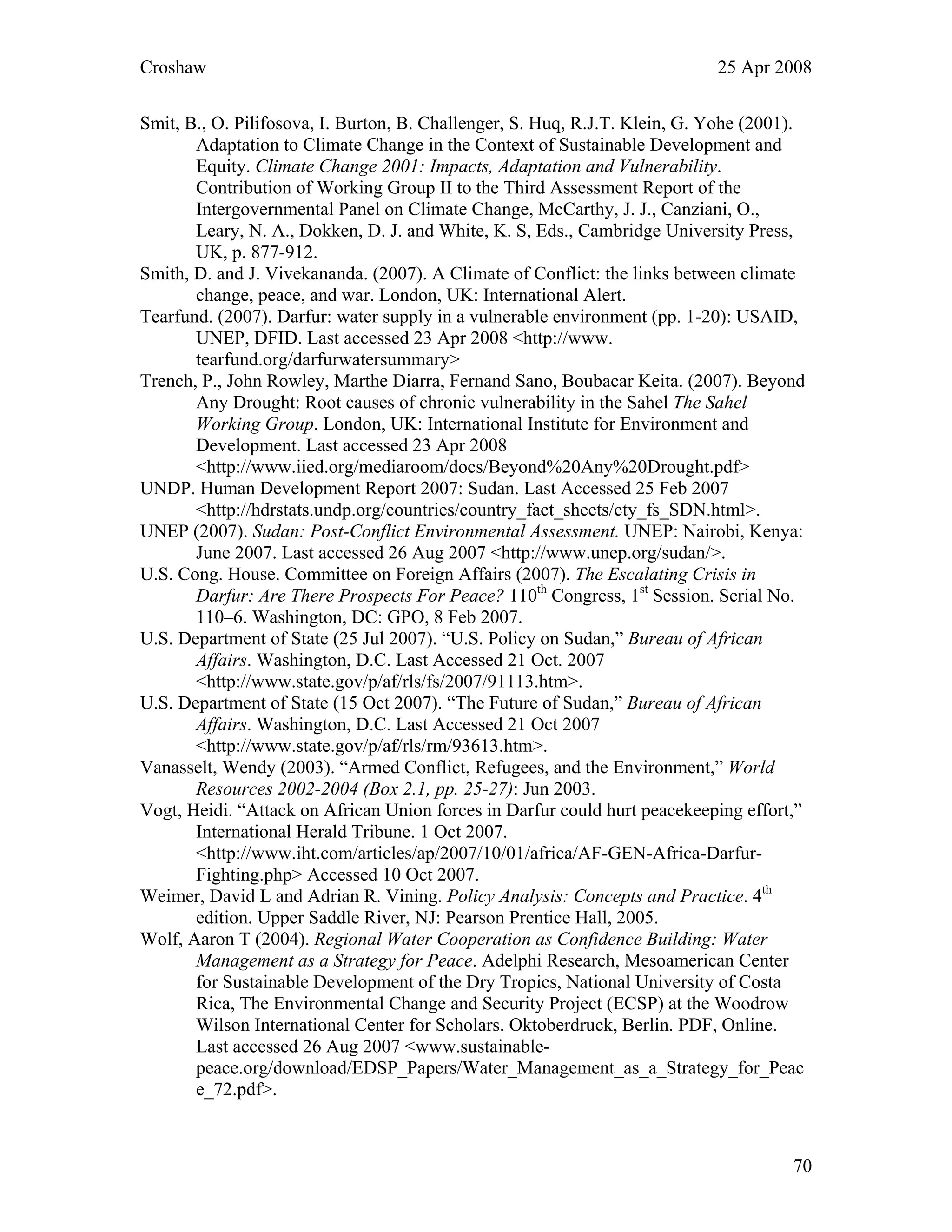
![Croshaw 25 Apr 2008
Wolf, Aaron T., Annika Kramer, Alexander Carius, and Geoffrey D. Dabelko (2006).
“Water Can Be A Pathway to Peace.” Navigating Peace. Woodrow Wilson
International Center for Scholars. No. 1: Jul. 2006.
Woodruff, Bob and Christine Romo (26 Mar 2008). “A Massive Oasis Could Ease
Suffering in Darfur: Scientist Says Rare Oasis Could Help War-Torn Region
Desperate for Water,” ABC News. Last accessed 17 Apr 2008
<http://abcnews.go.com/Technology/WoodruffReports/Story?id=4528101&page=
1>
Articles
A Dream Writ in Water. (9 Aug 2007) The Economist. Last accessed 26 Aug 2007
<http://www.economist.com/displaystory.cfm?story_id=9622006>.
Battle for Control of Chad Palace: Rebels in Chad have seized control of large parts of
the capital N'Djamena, and say they have surrounded the presidential palace. (3
Feb 2008) . BBC News. Last accessed 18 Apr 2008
<http://news.bbc.co.uk/2/hi/africa/7223760.stm>
China issues a warning to Sudan over Darfur crisis. (30 Jan 2008). Sudan Tribune.
15:50.<http://www.sudantribune.com/spip.php?article25753>
Darfur’s Deaths ‘Could Be 300,000.’ (Wed 23 Apr 2008) BBC News. Online. Last
accessed 24 Apr 2008 <http://news.bbc.co.uk/2/hi/africa/7361979.stm>.
Environmental Degradation Triggering Tensions and Conflict in Sudan. (22 Jun 2007).
UNEP, Geneva/Nairobi: Last accessed 26 Aug 2007
<http://www.unep.org/Documents.Multilingual/Default.Print.asp?DocumentID=5
12&ArticleID=5621&l=en>.
Q&A: Sudan's Darfur Conflict. (Thurs 15 Nov 2007). BBC News. Last Updated:
Thursday, 15 November 2007. Last accessed 24 Feb 2008
<http://news.bbc.co.uk/2/hi/africa/3496731.stm>.
Sudan: Chinese envoy urges former Darfur rebels to protect peacekeepers. (2008, 26
February). Sudan Tribune. Reprinted 28 February 2008. BBC Monitoring Asia-
Pacific-Political. BBC News. Retrieved 20 March, LexisNexis Academic, Duke
University.
Press Release, Boston University.(11 Apr 2007). Space Data Unveils Evidence of Ancient
Mega-Lake in Northern Darfur. Last accessed 23 Apr 2008
<http://www.bu.edu/phpbin/news/releases/display.php?id=1298&template=grs>
Thousand Wells for Darfur Follows Discovery of Ancient Lake [Electronic. (2007).
Version]. Environment News Service. Retrieved 25 Apr 2008, from
<http://www.ens-newswire.com/ens/jul2007/2007-07-23-02.asp>
Who are Sudan’s Darfur rebels? (Fri 12 Oct 2007) BBC News. Last accessed 13 April
2008. <http://news.bbc.co.uk/2/hi/africa/3702242.stm>
Websites
CIA World Factboook: Sudan
<https://www.cia.gov/library/publications/the-world-factbook/geos/su.html>
Creative Associates International: Welcome to the Conflict Prevention Web
<http://www.caii.com/CAIIStaff/Dashboard_GIROAdminCAIIStaff/Dashboard_
CAIIAdminDatabase/resources/ghai/default.htm>
71](https://image.slidesharecdn.com/9cf9284a-b20c-4b4a-b7ec-c17601a02e45-150317122303-conversion-gate01/75/MP_hrc4_a_200805-75-2048.jpg)

